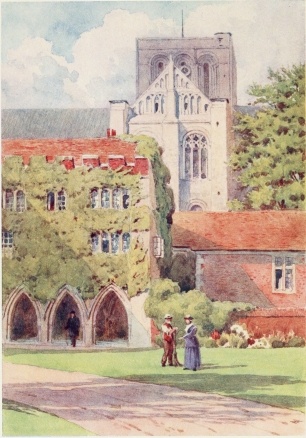*** START OF THE PROJECT GUTENBERG EBOOK 44684 ***
|
Every attempt has been made to replicate the original as printed.
Some typographical errors have been corrected;
a list follows the text.
Some illustrations
have been moved from mid-paragraph for ease of reading.
In certain versions of this etext, in certain browsers,
clicking on this symbol  will bring up a larger version of the image.
will bring up a larger version of the image.
Contents
List of Illustrations
Index
(etext transcriber's note) |

{i}
{ii}
THE PILGRIMS’ WAY
FROM WINCHESTER TO CANTERBURY
{iii}
T H E P I L G R I M S’ W A Y
FROM WINCHESTER
TO CANTERBURY
BY JULIA CARTWRIGHT

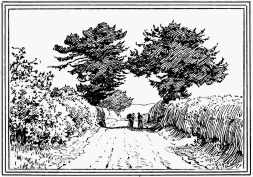
ILLUSTRATED BY
A. H. HALLAM MURRAY
NEW YORK
E. P. DUTTON AND COMPANY
1911
{iv}
“From every shire’s ende
Of Engelond, to Caunterbury they wende,
The holy blissful martyr for to seeke,
That them hath holpen when that they were sicke.”
All Rights Reserved
{v}

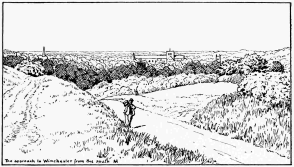
THE APPROACH TO WINCHESTER FROM THE SOUTH
PREFACE
THIS account of the Way trodden by the pilgrims of the Middle Ages
through the South of England to the shrine of St. Thomas of Canterbury
originally appeared in the Art Journal for 1892, with illustrations by
Mr. A. Quinton. It was published in the following year as a separate
volume, and reprinted in 1895 and 1901. Now by the courtesy of Messrs.
Virtue’s representatives, and in response to a continued demand, it
appears again in a new and revised form, with the{vi} additional attraction
of illustrations from original drawings by Mr. Hallam Murray.
During the twenty years which have elapsed since these pages were first
written, a whole literature has grown up round the Pilgrims’ Way. Not
only have scholarly papers on separate sections of the road appeared in
the Journals of Archæological Societies, but several valuable works on
the subject have been issued by writers of authority. Mr. H.
Snowden-Ward has written a book on “The Canterbury Pilgrimages,” in
Messrs. A. & C. Black’s Pilgrimage Series, in which he deals at length
with the life and death, the cult and miracles of St. Thomas, and the
different routes taken by pilgrims to his shrine. Mr. Palmer has
described a considerable portion of the Way in his treatise on “Three
Surrey Churches,” and only last autumn Mr. Elliston-Erwood published an
excellent little guide-book called “The Pilgrims’ Road,” for the use of
cyclists and pedestrians, in Messrs. Warne’s Homeland Pocket-book
Series. But the most thorough and systematic attempt to reconstruct{vii} the
route taken by pilgrims from Winchester to Canterbury has been made by
Mr. Belloc in his admirable work, “The Old Road.” The author himself
walked along the ancient track, and succeeded in filling up many gaps
where the road had been lost, and in recovering almost the whole of the
Way, “yard by yard from the capital of Hampshire to the capital of
Kent.” This intimate knowledge of the road and its characteristics have
led him to make several alterations in the line of the Way marked on the
Ordnance Map, which had hitherto served as the basis of most
descriptions. But as Mr. Belloc himself recognises, it is clear that
pilgrims often left the original road to visit churches and shrines in
the neighbourhood. Thus, in several places, new tracks sprang up along
the downs to which local tradition has given the name of the Pilgrims’
Way, and which it is not always easy to distinguish from the main road.
Like Bunyan’s pilgrims, when they came to the foot of the hill
Difficulty, “one turned to the left hand, and the other to the right,
but the narrow way lay right up the hill.”{viii}
In this edition of my book some obvious errors have been corrected, and
certain doubtful points have been cleared up with the help of experience
gained by other workers in the same field. But, as a rule, my object has
been not so much to draw attention to the actual road as to describe the
antiquities and objects of interest which arrest the traveller’s notice
on his journey. From whatever side we approach it, the subject is a
fascinating one. All of these different studies, varied in aims and
scope as they may be, bear witness to the perennial interest which the
Pilgrims’ Way inspires. The beauty of the country through which the old
road runs, its historic associations and famous memories, the ancient
churches and houses which lie on its course, will always attract those
who love and reverence the past, and will lead many to follow in the
footsteps of the mediæval pilgrims along the Way to Canterbury.
Julia Cartwright.
Ockham, Nov. 1, 1911.
{ix}

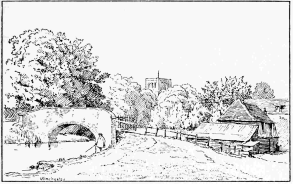
THE RIVER ITCHEN WHERE IT LEAVES THE TOWN.
CONTENTS
NOTE ON THE BINDING
THE “Canterbury Bell” and the Badges, represented on the cover of the
book, were worn by the Pilgrims on their return from the Shrine of St.
Thomas. The Badges were made of lead.
{xi}

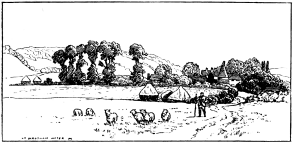
NEAR WROTHAM WATER.
LIST OF ILLUSTRATIONS
| COLOURED PLATES |
|---|
| THE NORMAN TOWER AND SOUTH TRANSEPT, WINCHESTER CATHEDRAL | Frontispiece |
| FACING PAGE |
| WINCHESTER CATHEDRAL FROM THE NORTH | 32 |
| CHAWTON HOUSE | 50 |
| THE MOTE, IGHTHAM | 136 |
| AYLESFORD BRIDGE | 146 |
| COTTAGE AT BOARLEY, NEAR BOXLEY | 152 |
| CHARING | 170 |
| CANTERBURY CATHEDRAL FROM THE SOUTH-WEST | 192 |
| {xii}HALF-TONES |
|---|
| WINCHESTER CATHEDRAL, SOUTH AISLE OF CHOIR | 25 |
| KING’S GATE, WINCHESTER, FROM THE CLOSE | 28 |
| LOSELEY | 67 |
| THE HOSPITAL, GUILDFORD | 72 |
| OLD YEWS AND OAK IN EASTWELL PARK | 176 |
| THE WEST GATE, CANTERBURY | 194 |
| MERCERY LANE, CANTERBURY | 199 |
| THE MARTYRDOM, CANTERBURY CATHEDRAL | 205 |
| LINE BLOCKS |
|---|
| ON “THE WAY” BETWEEN KEMSING AND OTFORD | Title-page |
| THE APPROACH TO WINCHESTER FROM THE SOUTH | v |
| THE RIVER ITCHEN WHERE IT LEAVES THE TOWN | ix |
| NEAR WROTHAM WATER | xi |
| ST. CROSS AND ST. KATHERINE’S HILL | 1 |
| DOORWAY IN CANTERBURY CLOISTERS THROUGH WHICH BECKET PASSED ON HIS WAY TO VESPERS | 8 |
| ST. CROSS FROM THE MEADOWS | 13 |
| THE ENTRANCE TO ST. CROSS HOSPITAL | 15 |
| BOX HILL | 18 |
| THE CATHEDRAL FROM THE SOUTH | 20 |
| ROOF OF STRANGERS’ HALL, WINCHESTER | 21 |
| THE WEST GATE, WINCHESTER | 23 |
| ON THE RIVER ITCHEN, WINCHESTER | 27 |
| {xiii}THATCHED COTTAGE, MARTYR WORTHY | 34 |
| CHILLAND FARM, NEAR ITCHEN ABBAS | 36 |
| NEW ALRESFORD | 40 |
| THE HOG’S BACK | 44 |
| JANE AUSTEN’S HOUSE, CHAWTON | 47 |
| FARNHAM CASTLE | 53 |
| CROOKSBURY FROM NEWLANDS CORNER | 55 |
| COMPTON VILLAGE | 63 |
| COMPTON CHURCH | 65 |
| ST. KATHERINE’S, GUILDFORD | 70 |
| ST. MARTHA’S CHAPEL | 71 |
| THE HOG’S BACK | 73 |
| ST. MARTHA’S FROM THE HOG’S BACK | 75 |
| ST. MARTHA’S FROM CHILWORTH | 81 |
| ALBURY OLD CHURCH | 85 |
| THE MILL, GOMSHALL | 87 |
| SHERE | 89 |
| CROSSWAYS FARM, NEAR WOTTON | 91 |
| WOTTON | 93 |
| BOX HILL AND DORKING CHURCH SPIRE | 95 |
| THE WHITE HORSE, DORKING | 96 |
| BETWEEN DORKING AND BETCHWORTH LOOKING WEST | 97 |
| ON “THE WAY” ABOVE BETCHWORTH | 100 |
| WINDMILL ON REIGATE COMMON | 103 |
| REIGATE COMMON | 105 |
| {xiv}LOOKING EAST FROM GATTON PARK | 108 |
| GATTON TOWN HALL | 110 |
| MERSTHAM CHURCH | 113 |
| THE WHITE HART, GODSTONE | 115 |
| OLD HOUSE IN OXTED | 116 |
| OXTED CHURCH | 117 |
| BRASTED | 120 |
| CHEVENING CHURCH | 123 |
| OTFORD CHURCH | 125 |
| THE PORCH, KEMSING CHURCH | 133 |
| WROTHAM CHURCH | 135 |
| WROTHAM, LOOKING SOUTH | 137 |
| THE BULL, WROTHAM | 139 |
| TROTTESCLIFFE | 140 |
| FORD PLACE, NEAR WROTHAM | 141 |
| THE FRIARY, AYLESFORD | 144 |
| KITS COTY HOUSE | 147 |
| LOOKING WEST FROM ABOVE BOXLEY ABBEY | 149 |
| HOLLINGBOURNE HOUSE | 155 |
| MARKET-PLACE, LENHAM | 163 |
| IN CHARING VILLAGE | 167 |
| THE PALACE, WROTHAM | 181 |
| CHILHAM | 182 |
| ON THE VILLAGE GREEN, CHARTHAM | 187 |
| ST. NICHOLAS’, HARBLEDOWN | 193 |
| SITE OF THE SHRINE OF ST. THOMAS, CANTERBURY CATHEDRAL | 209 |
{1}

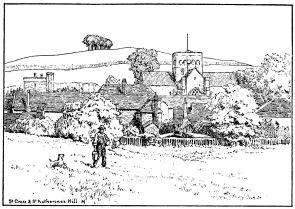
ST. CROSS AND ST. KATHERINE’S HILL.
CHAPTER I
THE PILGRIMS’ WAY
THREE hundred and seventy years have passed since the shrine of St.
Thomas at Canterbury was swept away, and the martyr’s ashes were
scattered to the winds. The age of pilgrimages has gone by, the
conditions of life have changed, and the influences which drew such vast
multitudes of men and women to worship at the murdered Archbishop’s tomb
have long ago ceased to work on the popular mind. No longer does the
merry{2} cavalcade of Chaucer’s lay ride forth in the freshness of the
spring morning, knight and merchant, scholar and lawyer, Prioress and
Wife of Bath, yeoman and priest and friars, a motley company from all
parts of the realm, “ready to wenden on their pilgrimage with full
devout courage” to Canterbury. The days of pilgrimages are over, their
fashion has passed away, but still some part of the route which the
travellers took can be traced, and the road they trod still bears the
name of the Pilgrims’ Way. Over the Surrey hills and through her stately
parks the dark yews which lined the path may yet be seen. By many a
quiet Kentish homestead the grassy track still winds its way along the
lonely hill-side overlooking the blue Weald, and, if you ask its name,
the labourer who guides the plough, or the waggoner driving his team,
will tell you that it is the Pilgrims’ Road to Canterbury. So the old
name lives, and the memory of that famous pilgrimage which Chaucer sang
has not yet died out of the people’s heart. And although strangers
journey no longer from afar to the martyrs shrine, it is still a
pleasant thing to ride out on a spring or{3} summer morning and follow the
Pilgrims’ Way. For the scenes through which it leads are fair, and the
memories that it wakes belong to the noblest pages of England’s story.
In those old days the pilgrims who came to Canterbury approached the
holy city by one of the three following routes. There was first of all
the road taken by Chaucer’s pilgrims from London, through Deptford,
Greenwich, Rochester, and Sittingbourne; the way trodden by all who came
from the North, the Midlands, and the Eastern Counties, and by those
foreigners who, like Erasmus, had first visited London. But the greater
number of the foreign pilgrims from France, Germany, and Italy landed at
Sandwich Haven or Dover, and approached Canterbury from the south; while
others, especially those who came from Normandy and Brittany, landed at
Southampton and travelled through the southern counties of Hampshire,
Surrey, and Kent. Many of these doubtless stopped at Winchester,
attracted by the fame of St. Swithun, the great healing Bishop; and
either here or else at Guildford, they would be joined by the{4} pilgrims
from the West of England on their way to the Shrine of Canterbury. This
was the route taken by Henry II. when, landing at Southampton on his
return from France, he made his first memorable pilgrimage to the tomb
of the murdered Archbishop, in the month of July, 1174. And this route
it is, which, trodden by thousands of pilgrims during the next three
centuries, may still be clearly defined through the greater part of its
course, and which in Surrey and Kent bears the historic name of the
Pilgrims’ Way. A very ancient path it is, older far than the days of
Plantagenets and Normans, of shrines and pilgrimages. For antiquarian
researches have abundantly proved this road to be an old British track,
which was in use even before the coming of the Romans. It may even have
been, as some writers suppose, the road along which caravans of
merchants brought their ingots of tin from Cornwall to be shipped at
what was then the great harbour of Britain, the Rutupine Port,
afterwards Sandwich Haven, and then borne overland to Massilia and the
Mediterranean shores. Ingots of tin, buried it may be in haste{5} by
merchants attacked on their journey by robbers, have, it is said, been
dug up at various places along this route, and British earthworks have
been found in its immediate neighbourhood.
The road was, there can be no doubt, used by the Romans; and all along
its course remains of Roman villas, baths, and pavements have been
brought to light, together with large quantities of Roman coins,
cinerary urns, and pottery of the most varied description. In mediæval
days this “tin road,” as Mr. Grant Allen calls it, still remained the
principal thoroughfare from the West to the East of England. It followed
the long line of hills which runs through the north of Hampshire, and
across Surrey and Kent, that famous chalk ridge which has for us so many
different associations, with whose scenery William Cobbett, for
instance, has made us all familiar in the story of his rides to and from
the Wen. And it lay outside the great trackless and impassable forest of
Anderida, which in those days still covered a great part of the
south-east counties of England. Dean Stanley, in his{6} eloquent account
of the Canterbury pilgrimage, describes this road as a byway, and
remarks that the pilgrims avoided the regular roads, “probably for the
same reason as in the days of Shamgar, the son of Anath, the highways
were unoccupied, and the traveller walked through byways.” But the
statement is misleading, and there can be little doubt that in the
twelfth and thirteenth centuries this road was, if not the only means of
communication between West and East, at least the principal thoroughfare
across this part of England, and was as such the route naturally chosen
by pilgrims to Canterbury.
Certain peculiarities, it is interesting to notice, mark its course from
beginning to end. It clings to the hills, and, wherever it is possible,
avoids the marshy ground of the valleys. It runs, not on the summit of
the downs, but about half-way down the hill-side, where there is shelter
from the wind, as well as sunshine to be had under the crest of the
ridge. And its course is marked by rows of yew trees, often remarkable
for their size and antiquity. Some of these are at least seven or eight
hundred years old, and must have{7} reared their ancient boughs on the
hill-side before the feet of pilgrims ever trod these paths. So striking
is this feature of the road, and so fixed is the idea that some
connection exists between these yew trees and the Pilgrims’ Way, that
they are often said to have been planted with the express object of
guiding travellers along the road to Canterbury. This, however, we need
hardly say, is a fallacy. Yews are by no means peculiar to the Pilgrims’
Way, but are to be found along every road in chalk districts. They
spring up in every old hedgerow on this soil, and are for the most part
sown by the birds. But the presence of these venerable and picturesque
forms does lend an undeniable charm to the ancient track. And in some
places where the line of cultivation gradually spreading upwards has
blotted out every other trace of the road, where the ploughshare has
upturned the sod, and the hedgerows have disappeared, three or four of
these grand old trees may still be seen standing by themselves in the
midst of a ploughed field, the last relics of a bygone age.

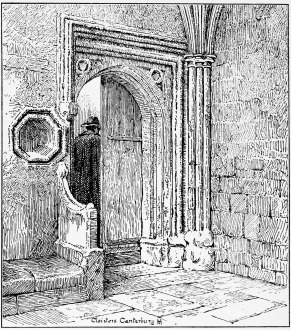
DOORWAY IN CANTERBURY CLOISTERS THROUGH WHICH BECKET
PASSED ON HIS WAY TO VESPERS.
The murder of Becket took place on the{8} 29th of December, 1170. At five
o’clock on that winter evening, as the Archbishop was on{9} his way to
vespers, the King’s men, Reginald Fitz Urse and three knights who had
accompanied him from Saltwood Castle, rushed upon him with their swords
and murdered him in the north transept of his own Cathedral. The tragic
circumstance of Becket’s end made a profound impression on the people of
England, and universal horror was excited by this act of sacrilege.
Whatever his faults may have been, the murdered Archbishop had dared to
stand up against the Crown for the rights of the Church, and had died
rather than yield to the Kings demands. “For the name of Jesus and the
defence of the Church I am ready to die,” were his last words, as he
fell under the assassins’ blows. When he landed at Sandwich, on his
return from France, the country folk crowded to meet him and hailed him
as the father of orphans and deliverer of the oppressed, crying,
“Blessed is he that cometh in the name of the Lord.” His journey to
Canterbury was one long triumphal procession.[1] The poor looked to him
as their champion and{10} defender, who had laid down his life in the cause
of freedom and righteousness. Henceforth Thomas became a national hero,
and was everywhere honoured as the Martyr of the English.
The popular belief in his holiness was confirmed by the miracles that
were wrought in his name from the moment of his death. A violent storm
broke over the Cathedral when the fatal deed was done, and was followed
by a red glow, which illuminated the choir where the dead man’s body was
laid before the altar. The next day the monks buried the corpse in a
marble tomb behind Our Lady’s altar in the under-croft. For nearly a
year no mass was said in the Cathedral, no music was heard, no bells
were rung; the altars were stripped of their ornaments, and the
crucifixes and images were covered over. Meanwhile, reports reached
Canterbury of the wonderful cures performed by the martyred Archbishop.
On the third day after the murder, the wife of a Sussex knight, who
suffered from blindness, invoked the blessed martyr’s help, and was
restored to sight. And on the very night of the burial the paralytic
wife of a citizen of{11} Canterbury was cured by a garment which her
husband had dipped in the murdered saint’s blood.
These marvels were followed by a stream of devout pilgrims who came to
seek healing at the martyr’s tomb or to pay their vows for the mercies
which they had received. A monk was stationed at the grave to receive
offerings and report the miracles that were wrought to the Chapter. At
first these wonders were kept secret, for fear of the King, and of
Becket’s enemies, the De Brocs, whose men guarded the roads to
Canterbury. The doors of the crypt were kept bolted and barred, and only
the poor in the town and the neighbouring villages crept to the tomb.[2]
But on Easter Day, 1171, the crowds rushed in to see a dumb man who was
said to have recovered his speech; and on the following Friday the crypt
was thrown open to the public. From that time, writes Benedict, the monk
of Canterbury, “the scene of the Pool of Bethesda was daily renewed in
the Cathedral, and numbers of sick and helpless persons were to be seen
lying on the pavement{12} of the great church.”[3] “These great miracles
are wrought,” wrote John of Salisbury, an intimate friend of Becket, who
became Bishop of Chartres in 1176, and was an able statesman and
scholar, “in the place of his passion and in the place where he lay
before the great altar before his burial, and in the tomb where he was
laid at last, the blind see, the deaf hear, the dumb speak, the lame
walk, lepers are cleansed, and, a thing unheard of since the days of our
fathers, the dead are raised to life.”[4]
From all parts of England the sick and suffering now crowded to
Canterbury, telling the same marvellous tale, how Thomas had appeared to
them robed in white, with the thin red streak of blood across his face,
bringing healing and peace. “In towns and villages, in castles and
cottages, throughout the kingdom,” writes another contemporary
chronicler, “every one from the highest to the lowest wishes to visit
and honour his tomb. Clerks and laymen, rich and{13} poor, nobles and
common people, fathers and mothers with their children, masters with
their servants, all come hither, moved by the same spirit of devotion.
They travel by day and night in winter and summer, however cold the
weather may be, and the inns and hostelries on the road to Canterbury
are as crowded with people as great cities are on market days.”[5]

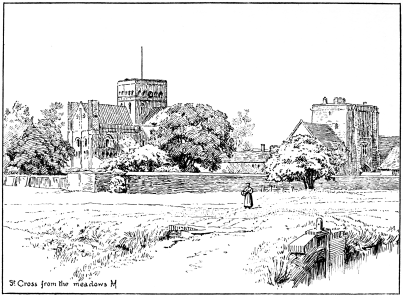
ST. CROSS FROM THE MEADOWS.
On the 21st of February, 1173, Pope Alexander III. pronounced the decree
of canonisation, and fixed the Feast of St. Thomas of Canterbury on the
day of the Archbishop’s martyrdom. In July, 1174, King Henry II., moved
by the reports which reached him in Normandy of the popular enthusiasm
for Becket, and fearing the effects of the divine wrath, came himself to
do penance at the martyr’s tomb. Three months after the King of the
English had given this public proof of his penitence and obtained
release from the Church’s censures, “the glorious choir of Conrad” was
destroyed by fire, on the night of September 5, 1174. The rebuilding of
the church, which was largely assisted by offerings at Becket’s tomb,{15}
was not finished until 1220, when the Saint’s body was removed to its
final resting-place in the new apse at the East end of the Chapel of the
Blessed Trinity, where the Archbishop had said his first mass.

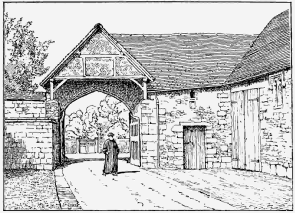
THE ENTRANCE TO ST. CROSS HOSPITAL.
On Tuesday, July 7, an immense concourse of people of all ranks and ages
assembled at Canterbury. “The city and villages round,” writes an
eye-witness, “were so filled with folk{16} that many had to abide in tents
or under the open sky.”[6] Free hospitality was given to all, and the
streets of Canterbury literally flowed with wine. A stately procession,
led by the young King Henry III. and the patriot Archbishop Stephen
Langton, entered the crypt, and bore the Saint’s remains with solemn
ceremonial to their new resting-place. Here a sumptuous shrine, adorned
with gold plates and precious gems, wrought “by the greatest master of
the craft” that could be found in England, received the martyr’s relics,
and the new apse became known as “Becket’s Crown.”
The fame of St. Thomas now spread into all parts of the world during the
next two centuries, and the Canterbury pilgrimage was the most popular
in Christendom. The 7th of July was solemnly set apart as the Feast of
the Translation of St. Thomas, and henceforth the splendour of this
festival threw the anniversary of the actual martyrdom into the shade.
The very fact that it took place in summer and not in winter naturally
attracted greater numbers of{17} pilgrims from a distance. And on the
jubilees or fiftieth anniversaries of the Translation, the concourse of
people assembled at Canterbury was enormous.
Besides the crowds attracted by these two chief festivals, pilgrims came
to Canterbury in smaller parties at all seasons of the year, but more
especially in the spring and summer months. Each year, as Chaucer sings,
when the spring-time comes round,
“When that Aprille with his showers sweete
The drought of Marche had pierced to the roote....
When Zephyrus eke with his sweete breathe
Inspired hath in every holt and heathe
The tender croppes ...
And small fowlës maken melodie,
That sleepen all the night with open eye,
Then longen folk to go on pilgrimages,
And palmers for to seeken strange ‘strandës’ ...
And specially, from every shire’s ende
Of Engelond, to Caunterbury they wende,
The holy blissful martyr for to seeke
That them hath holpen when that they were sicke.”

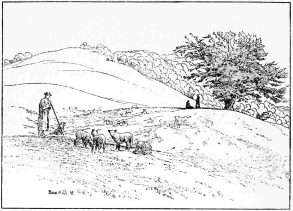
BOX HILL.
The passage of these caravans of pilgrims could not fail to leave its
mark on the places and the people along their path. The sight of these{18}
strange faces, the news they brought, and the tales they told must have
impressed the dwellers in these quiet woodlands and lonely hills. And
traces of their presence remain to this day on the Surrey downs and in
the lanes of Kent. They may, or may not, have been responsible for the
edible variety of large white snails, Helix pomatia, commonly called
Roman snails, which are found in such abundance at Albury in Surrey, and
at Charing in Kent, as well as at other places along{19} the road, and
which the Norman French pilgrims are traditionally said to have brought
over with them. But the memory of their pilgrimage survives in the
wayside chapels and shrines which sprung up along the track, in the
churches which were built for their benefit, or restored and decorated
by their devotion, above all in the local names still in common use
along the countryside. Pilgrims’ Lodge and Pilgrims’ Ferry, Palmers’
Wood, Paternoster Lane—these, and similar terms, still speak of the
custom which had taken such fast hold of the popular mind during the
three hundred and fifty years after the death of Becket, and recall the
long processions of pilgrims which once wound over these lonely hills
and through these green lanes on their way to the martyr’s shrine.{20}

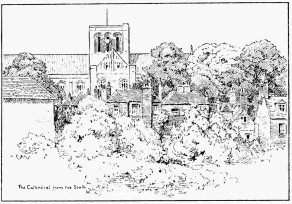
THE CATHEDRAL FROM THE SOUTH.
CHAPTER II
WINCHESTER TO ALTON

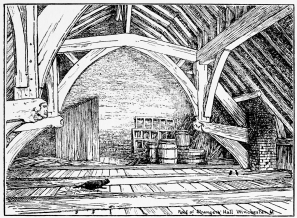
ROOF OF STRANGERS’ HALL, WINCHESTER.
Few traces of the Pilgrims’ Way are now to be found in Hampshire. But
early writers speak of an old road which led to Canterbury from
Winchester, and the travellers’ course would in all probability take
them through this ancient city. Here the foreign pilgrims who landed at
Southampton, and those who came from the West of England, would find
friendly shelter in one or other of the religious houses, and enjoy{21} a
brief resting-time before they faced the perils of the road. The old
capital of Wessex, the home of Alfred, and favourite residence of Saxon
and Norman kings, had many attractions to offer to the devout pilgrim.
Here was the splendid golden shrine of St. Swithun, the gentle Bishop
who had watched over the boyhood of Alfred. In A.D. 971, a hundred years
after the Saint’s death, his bones had been solemnly removed{22} from their
resting-place on the north side of the Minster, where he had humbly
begged to be buried” so that the sun might not shine upon him,” and laid
by Edgar and Dunstan behind the altar of the new Cathedral which Bishop
Ethelwold had raised on the site of the ancient church of Birinus. This
was done, says the chronicler Wulfstan, although the Saint himself
“protested weeping that his body ought not to be set in God’s holy
church amidst the splendid memorials of the ancient fathers,” a legend
which may have given rise to the popular tradition of the forty days’
rain, and the supposed delay in the Saint’s funeral. From that time
countless miracles were wrought at the shrine of St. Swithun, and
multitudes from all parts of England flocked to seek blessing and
healing at the great church which henceforth bore his name.

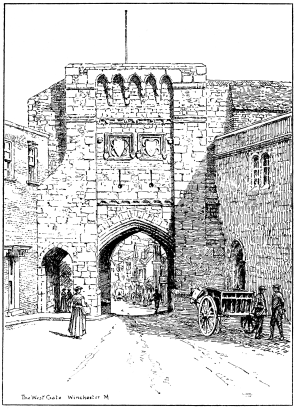
THE WEST GATE, WINCHESTER.
Under the rule of Norman and Angevin kings, the venerable city had
attained the height of wealth and prosperity. In those days the
population numbered some 20,000, and there are said to have been as many
as 173 churches and chapels within its wall. In spite of the{23} horrors
of civil war, which twice desolated the streets, in the time of Stephen
and Henry III., the frequent presence of the court and the energy of her
prince-bishops had made Winchester a centre of religious and literary
activity. And, although after the death of Henry III., who throughout
his long life remained faithful to his native city, royal visits became
few and far between, and the old capital lost something of its
brilliancy, there was still much to attract strangers and strike the
imagination of the wayfarer who entered her gates in the fifteenth
century. Few mediæval cities could boast foundations of equal size and
splendour. There was the strong castle of Wolvesey, where the bishops
reigned in state, and the royal palace by the West gate, built by King
Henry III., with the fair Gothic hall which he had decorated so
lavishly. There was the Hospital of St. Cross, founded by the
warrior-bishop, Henry de Blois, and the new College of St. Mary, which
William of Wykeham, the great master-builder, had reared in the meadows
known as the Greenery, or promenade of the monks of St. Swithun.
Another{25} venerable hospital, that of St. John’s, claimed to have been
founded by Birinus, and on Morne Hill, just outside the East gate, stood
a hospital for lepers, dedicated to St. Mary Magdalene. There,
conspicuous among a crowd of religious houses by their wealth and
antiquity, were the two great Benedictine communities of St. Swithun and
Hyde. And there, too, was the grand Norman church which the Conqueror’s
kinsman, Bishop Walkelin, had raised on the ruins of Ethelwold’s
Minster, with its low massive tower and noble transepts, and the long
nave roofed in with solid trees of oak cut down in Hempage Wood. Three
centuries later, William of Wykeham transformed the nave after the
latest fashion of architecture, cut through the old Norman work, carried
up the piers to a lofty height, and replaced the flat wooden roof by
fine stone groining. But the Norman tower and transepts of Bishop
Walkelin’s church still remain to-day almost unchanged.

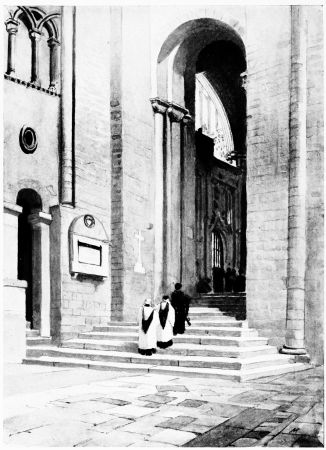
WINCHESTER CATHEDRAL, SOUTH AISLE OF CHOIR.
So great was the concourse of pilgrims to St. Swithun’s shrine in the
early part of the fourteenth century, that Bishop Godfrey Lucy enlarged{26}
the eastward portion of the church, and built, as it were, another
church, with nave, aisles, and Lady Chapel of its own, under the same
roof. The monks had no great love for the lower class of pilgrims who
thronged their doors, and took good care to keep them out of the
conventual precincts. They were only allowed to enter the Minster by a
doorway in the north transept, and, once they had visited the shrine and
duly made their offerings, they were jealously excluded from the rest of
the church by those fine ironwork gates still preserved in the
Cathedral, and said to be the oldest specimen of the kind in England.

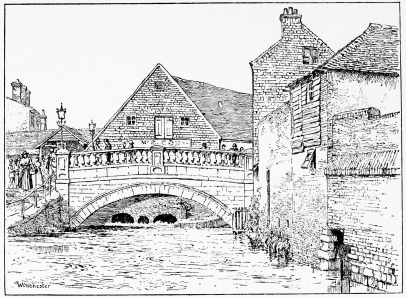
ON THE RIVER ITCHEN, WINCHESTER.
Towards the close of the century, in the reign of Edward I., the fine
old building still known as the Strangers’ Hall was built by the monks
of St. Swithun at their convent gate, for the reception of the poorer
pilgrims. Here they found food and shelter for the night. They slept,
ate their meals, and drank their ale, and made merry round one big
central fire. The hall is now divided, and is partly used as the Dean’s
stable, partly enclosed in a Canon’s house, but traces of rudely carved
heads, a bearded king, and a nun’s{27} face are still visible on the
massive timbers of the vaulted roof, blackened with the smoke of bygone
ages. In the morning the same pilgrims would wend their way to the doors
of the Prior’s lodging, and standing under the three beautiful pointed
arches which form the entrance to the present Deanery, would there
receive alms in money and fragments of bread and meat to help them on
their journey.

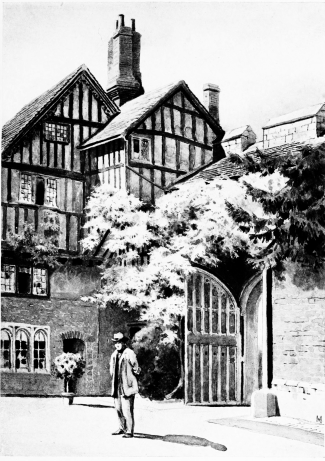
KING’S GATE, WINCHESTER, FROM THE CLOSE.
The route which they took on leaving Winchester is uncertain. It is not
till we approach Alton that we find the first traces of the Pilgrims’
Way, but in all probability they followed the Roman road which still
leads to Silchester and London along the valley of the river Itchen.
Immediately outside the city gates they would find themselves before
another stately pile of conventual buildings, the great Abbey of Hyde.
This famous Benedictine house, founded by Alfred, and long known as the
New Minster, was first removed from its original site near the Cathedral
in the twelfth century. Finding their house damp and unhealthy, and
feeling themselves cramped in the narrow space close to the rival
monastery{29} of St. Swithun, the monks obtained a charter from Henry I.
giving them leave to settle outside the North gate. In the year 1110,
they moved to their new home, bearing with them the wonder-working
shrine of St. Josse, the great silver cross given to the New Minster by
Cnut, and a yet more precious relic, the bones of Alfred the Great. Here
in the green meadows on the banks of the Itchen they reared the walls of
their new convent and the magnificent church which, after being in the
next reign burnt to the ground by fire-balls from Henry of Blois’ Castle
at Wolvesey, rose again from the flames fairer and richer than before.
Here it stood till the Dissolution, when Thomas Wriothesley, Cromwell’s
Commissioner, stripped the shrine of its treasures, carried off the gold
and jewels, and pulled down the abbey walls to use the stone in the
building of his own great house at Stratton. “We intend,” he wrote to
his master, after describing the riches of gold and silver plate, the
crosses studded with pearls, chalices, and emeralds on which he had lain
sacrilegious hands, “both at Hyde and St. Mary to sweep away all the
rotten{30} bones that be called relics; which we may not omit, lest it be
thought we came more for the treasure than for the avoiding of the
abomination of idolatry.” Considerable fragments of the building still
remained. In Milner’s time the ruins covered the whole meadow, but
towards the end of the last century the city authorities fixed on the
spot as the site of a new bridewell, and all that was left of the once
famous Abbey was then destroyed. The tombs of the dead were rifled. At
every stroke of the spade some ancient sepulchre was violated, stone
coffins containing chalices, croziers, rings, were broken open and bones
scattered abroad. Then the ashes of the noblest of our kings were blown
to the winds, and the resting-place of Ælfred remains to this day
unknown. A stone marked with the words, Ælfred Rex, DCCCLXXXI., was
carried off by a passing stranger, and is now to be seen at Corby
Castle, in Cumberland. To-day an old gateway near the church of St.
Bartholomew and some fragments of the monastery wall are the only
remains of Alfred’s new Minster.
From this spot an ancient causeway, now{31} commonly known as the Nuns’
Walk, but which in the last century bore the more correct title of the
Monks’ Walk, leads alongside of a stream which supplied Hyde Abbey with
water, for a mile and a half up the valley to Headbourne[7] Worthy. The
path is cool and shady, planted with a double row of tall elms, and as
we look back we have beautiful views of the venerable city and the great
Cathedral sleeping in the quiet hollow, dreaming of all its mighty past.
Above, scarred with the marks of a deep railway cutting, and built over
with new houses, is St. Giles’ Hill, where during many centuries the
famous fair was held each September. Foreign pilgrims would gaze with
interest on the scene of that yearly event, which had attained a
world-wide fame, and attracted merchants from all parts of France,
Flanders, and Italy. The green hill-side from which we look down on the
streets and towers of Winchester presented a lively spectacle during
that fortnight. The stalls were arranged in long rows and called after
the nationality of the vendors of the goods they sold. There was the{32}
Street of Caen, of Limoges, of the Flemings, of the Genoese, the
Drapery, the Goldsmiths’ Stall, the Spicery, held by the monks of St.
Swithun, who drove a brisk trade in furs and groceries on these
occasions. All shops in the city and for seven leagues round were closed
during the fair, and local trade was entirely suspended. The mayor
handed over the keys of the city for the time being to the bishop, who
had large profits from the tolls and had stalls at the fair himself,
while smaller portions went to the abbeys, and thirty marks a year were
paid to St. Swithun’s for the repair of the great church. The Red King
first granted his kinsman, Bishop Walkelin, the tolls of this three
days’ fair at St. Giles’ feast, which privilege was afterwards extended
to a period of sixteen days by Henry III. The great fair lasted until
modern times, but in due course was removed from St. Giles’ Hill into
the city itself. “As the city grew stronger and the fair weaker,” writes
Dean Kitchin, “it slid down St. Giles’ Hill and entered the town, where
its noisy ghost still holds revel once a year.”

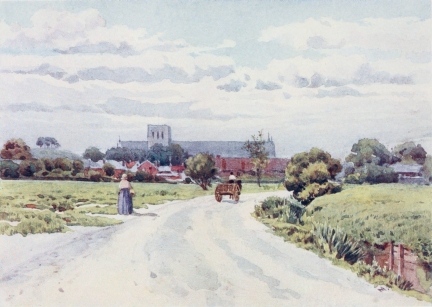
WINCHESTER CATHEDRAL FROM THE NORTH
Leaving these historic memories behind us we{33} follow the Monks’ Walk
until we reach Headbourne Worthy, the first of a group of villages
granted by Egbert, in 825, to St. Swithun’s Priory, and bearing this
quaint name, derived from the Saxon woerth—a homestead. The church
here dates from Saxon times, and claims to have been founded by St.
Wilfred. The rude west doorway and chancel arch are said to belong to
Edward the Confessor’s time. Over the west archway, which now leads into
a fifteenth-century chapel, is a fine sculptured bas-relief larger than
life, representing the Crucifixion and the Maries, which probably
originally adorned the exterior of the church. But the most interesting
thing in the church is the brass to John Kent, a Winchester scholar, who
died in 1434. The boy wears his college gown and his hair is closely
cut, while a scroll comes out of his lips bearing the words:
“Misericordiam Dni inetum cantabo.” Next we reach Kingsworthy, so called
because it was once Crown property, a pretty little village with low
square ivy-grown church-tower and lych-gate, and a charming
old-fashioned inn standing a little back from the road.{34}

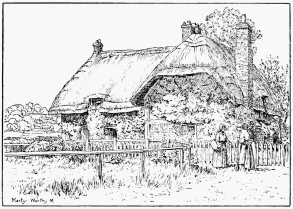
THATCHED COTTAGE, MARTYR WORTHY.
The third of the Worthys, Abbotsworthy, is now united to Kingsworthy.
Passing through its little street of houses, a mile farther on we reach
Martyrsworthy, a still smaller village with another old Norman church
and low thatched cottages, picturesquely placed near the banks of the
river, which is here crossed by a wooden foot-bridge. But all this part
of the Itchen valley has the same charm. Everywhere we find the same old
farmhouses with mullioned windows and sundials{35} and yew trees, the same
straggling roofs brilliant with yellow lichen, and the same cottages and
gardens gay with lilies and phloxes, the same green lanes shaded with
tall elms and poplars, the same low chalk hills and wooded distances
closing in the valley, and below the bright river winding its way
through the cool meadows. “The Itchen—the beautiful Itchen valley,”
exclaims Cobbett, as he rides along this vale of meadows. “There are few
spots in England more fertile, or more pleasant, none, I believe, more
healthy. The fertility of this vale and of the surrounding country is
best proved by the fact that, besides the town of Alresford and that of
Southampton, there are seventeen villages, each having its parish
church, upon its borders. When we consider these things, we are not
surprised that a spot situated about half-way down this vale should have
been chosen for the building of a city, or that that city should have
been for a great number of years the place of residence for the kings of
England.”

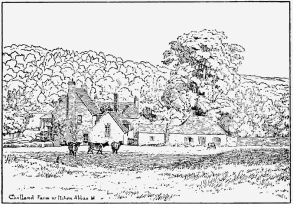
CHILLAND FARM, NEAR ITCHEN ABBAS.
Towards Itchen Abbas—of the Abbot—the valley opens, and we see the
noble avenues and{36} spreading beeches of Avington Park, long the property
of the Dukes of Chandos, and often visited by Charles II. while Wren was
building his red-brick palace at Winchester. Here the Merry Monarch
feasted his friends in a banqueting-hall that is now a greenhouse, and a
room in the old house bore the name of Nell Gwynne’s closet. In those
days it was the residence of the notorious Lady Shrewsbury, afterwards
the wife of George Brydges, a member of the Chandos{37} family, the lady
whose first husband, Francis, Earl of Shrewsbury, was slain fighting in
a duel with George Villiers, Duke of Buckingham, while the Countess
herself, disguised as a page, held her lover’s horse.
The river winds through the park, and between the over-arching boughs of
the forest trees we catch lovely glimpses of wood and water. In the
opposite direction, but also close to Itchen Abbas, is another
well-known seat, Lord Ashburton’s famous Grange, often visited by
Carlyle. Here the dark tints of yew and fir mingle with the bright hues
of lime and beech and silver birch on the banks of a clear lake, and
long grassy glades lead up to wild gorse-grown slopes of open down.
Still following the river banks we reach Itchen Stoke, another
picturesque village with timbered cottages and mossy roofs. A little
modern church, with high-pitched roof and lancet windows having a
curiously foreign air, stands among the tall pines on a steep bank above
the stream. But here our pleasant journey along the fair Itchen valley
comes to an end, and, leaving the river-side,{38} we climb the hilly road
which leads us into Alresford.
New Alresford, a clean, bright little town, with broad street, planted
with rows of trees, boasts an antiquity which belies its name, and has
been a market-town and borough from time immemorial. Like its yet more
venerable neighbour, Old Alresford, it was given by a king of the West
Saxons to the prior and monks of St. Swithun at Winchester, and formed
part of the vast possessions of the monastery at the Conquest. Both
places took their name from their situation on a ford of the Arle or
Alre river, a considerable stream which joins the Itchen below Avington,
and is called by Leland the Alresford river. In the eleventh century New
Alresford had fallen into decay, and probably owes its present existence
to Bishop Godfrey Lucy, who rebuilt the town, and obtained a charter
from King John restoring the market, which had fallen into disuse. At
the same time he gave the town the name of New Market, but the older one
survived, and the Bishop’s new title was never generally adopted. The
same{39} energetic prelate bestowed a great deal of care and considerable
attention on the water supply of Winchester, and made the Itchen
navigable all the way from Southampton to Alresford.
In recognition of this important service, Bishop Lucy received from King
John the right of levying toll on all leather, hides, and other goods
which entered Winchester by the river Itchen through this canal, a right
which descended to his successors in the see. South-west of the town is
the large pond or reservoir which he made to supply the waters of the
Itchen. This lake, which still covers about sixty acres, is a well-known
haunt of moor-hens and other waterfowl, and the flags and bulrushes
which fringe its banks make it a favourable resort of artists. Old
Alresford itself, with its gay flower-gardens, tall elms, pretty old
thatched cottages grouped round the village green, may well supply them
with more than one subject for pen and pencil.

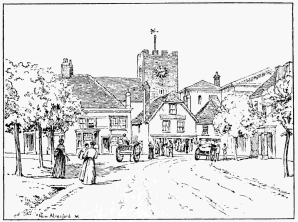
NEW ALRESFORD.
New Alresford was at one time a flourishing centre of the cloth trade,
in which the Winchester merchants drove so brisk a trade at St. Giles’
Fair. The manufacture of woollen cloth was{40} carried on till quite recent
times, and Dean Kitchin tells us that there are old men still living who
remember driving with their fathers to the fair at Winchester on St.
Giles’ day, to buy a roll of blue cloth to provide the family suits for
the year. But New Alresford shared the decline as it had shared the
prosperity of its more important neighbour, and suffered even more
severely than Winchester in the Civil Wars, when the town{41} was almost
entirely burnt down by Lord Hopton’s troops after their defeat in
Cheriton fight. The scene of that hard-fought battle, which gave
Winchester into Waller’s hands and ruined the King’s cause in the West
of England, lies a few miles to the south of Alresford. Half-way between
the two is Tichborne Park, the seat of a family which has owned this
estate from the days of Harold, and which took its name from the stream
flowing through the parish, and called the Ticceborne in Anglo-Saxon
records. In modern times a well-known case has given the name of
Tichborne an unenviable notoriety, but members of this ancient house
have been illustrious at all periods of our history, and the legend of
the Tichborne Dole so long associated with the spot deserves to be
remembered. In the reign of Henry I., Isabella, the wife of Sir Roger
Tichborne, a lady whose long life had been spent in deeds of mercy,
prayed her husband as she lay dying to grant her as much land as would
enable her to leave a dole of bread for all who asked alms at the gates
of Tichborne on each succeeding Lady Day. Sir Roger was a knight of
sterner{42} stuff, and seizing a flaming brand from the hearth he told his
wife jestingly that she might have as much land as she could herself
walk over before the burning torch went out. Upon which the sick lady
caused herself to be borne from her bed to a piece of ground within the
manor, and crawled on her knees and hands until she had encircled
twenty-three acres. The actual plot of ground still bears the name of
Lady Tichborne’s Crawles, and there was an old prophecy which said that
the house of Tichborne would only last as long as the dying bequest of
Isabella was carried out. During the next six centuries, nineteen
hundred small loaves were regularly distributed to the poor at the gates
on Lady Day, and a miraculous virtue was supposed to belong to bread
thus bestowed. The custom was only abandoned a hundred years ago, owing
to the number of idlers and bad characters which it brought into the
neighbourhood, and a sum of money equal in amount to the Dole is given
to the poor of the parish in its stead.
Whether any of our Canterbury pilgrims stopped in their course to avail
themselves of the{43} Tichborne Dole we cannot say, but there was a
manor-house of the Bishops of Winchester at Bishop Sutton, near
Alresford, where they would no doubt find food and shelter. Nothing now
remains of the episcopal palace, and no trace of its precincts is
preserved but the site of the bishop’s kennels.
After crossing the river at Alresford the pilgrims turned north-east,
and according to an old tradition their road led them through the parish
of Ropley, a neighbouring village where Roman remains have been
discovered. A little further on the same track, close to Rotherfield
Park, where the modern mansion of Pelham now stands, was an ancient
house which bore the name of Pilgrims’ Place, and is indicated as such
in old maps.{44}

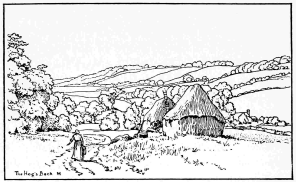
THE HOG’S BACK.
CHAPTER III
ALTON TO COMPTON
A FEW miles to the right of the road is a place which no pilgrim of
modern times can leave unvisited—Selborne, White’s Selborne, the home
of the gentle naturalist whose memory haunts these rural scenes. Here he
lived in the picturesque house overgrown with creepers, with the sunny
garden and dial at the back, and the great spreading oak where he loved
to study the ways of the owls, and the juniper tree, which, to his joy,
survived the Siberian winter of 1776. And here{45} he died, and lies buried
in the quiet churchyard in the shade of the old yew tree where he so
often stood to watch his favourite birds. Not a stone but what speaks of
him, not a turn in the village street but has its tale to tell. The
play-stow, or village green, which Adam de Gurdon granted to the
Augustinian Canons of Selborne in the thirteenth century, where the
prior held his market of old, and where young and old met on summer
evenings under the big oak, and “sat in quiet debate” or “frolicked and
danced” before him; the farmhouse which now marks the site of the
ancient Priory itself, founded by Peter de Rupibus, Bishop of
Winchester, in 1232—he has described them all. How the good Canons grew
lazy and secular in their ways after a time, how William of Wykeham
found certain of them professed hunters and sportsmen, and tried in vain
to reform them, and how the estates were finally handed over to the new
college of St. Mary Magdalene at Oxford, by its founder, William of
Waynflete—Gilbert White has already told us. The Hanger, with its
wooded slopes, rising from the back of his garden, and that “noble
chalk{46} promontory” of Nore Hill, planted with the beeches which he
called the most lovely of all forest trees, how familiar they seem to
us! Still the swifts wheel to and fro round the low church-tower, and
the crickets chirp in the long grass, and the white owl is heard at
night, just as when he used to linger under the old walls and watch
their manners with infinite care and love.

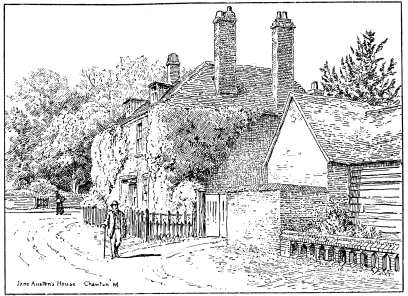
JANE AUSTEN’S HOUSE, CHAWTON.
One of the “rocky hollow lanes” which lead towards Alton will take us
back into the road, and bring us to Chawton, a village about a mile from
that town. The fine Elizabethan manor-house at the foot of the green
knoll, and the grey church peeping out of the trees close by, have been
for centuries the home and burial-place of the Knights. On the south
side of the chancel a black and white marble monument records the memory
of that gallant cavalier, Sir Richard Knight, who risked life and
fortune in the Royal cause, and was invested with the Order of the Royal
Oak by Charles II. after the Restoration. But it is as the place where
Jane Austen, in George Eliot’s opinion, “the greatest artist that has
ever written,” composed her novels, that Chawton is memorable.{47} The
cottage where she lived is still standing a few hundred yards from the
“great house,” which was the home of the brother and nieces to whom she
was so fondly attached. She and her sister, Cassandra, settled there in
1809, and remained there until May, 1817, when they moved to the corner
house of College Street, Winchester, where three months afterwards she
died. During the eight years spent in this quiet home, Jane Austen
attained the height of her powers and wrote her most famous novels,
those works which she herself said cost her so little, and which in
Tennyson’s words have given her a place in English literature “next to
Shakespeare.” “Sense and Sensibility,” her first novel, was published
two years after the move to Chawton. “Persuasion,” the last and most
finished of the immortal series, was only written in 1816, a year before
her death. Seldom, indeed, has so great a novelist led so retired an
existence. The life at Chawton, so smooth in its even flow, with the
daily round of small excitements and quiet pleasures, the visits to the
“great house,” and walks with her nieces in the woods, the shopping
expeditions{49} to Alton, the talk about new bonnets and gowns, and the
latest news as to the births, deaths, and marriages of the numerous
relatives in Kent and Hampshire, are faithfully reflected in those
pleasant letters of Jane Austen, which her great-nephew, Lord Brabourne,
gave to the world. There is a good deal about her flowers, her chickens,
her niece’s love affairs, the fancy work on which she is engaged, the
improvements in the house and garden—“You cannot imagine,” she writes
on one occasion, “it is not in human nature to imagine, what a nice walk
we have round the orchard!”—but very little indeed about her books.
Almost the only allusion we find to one of her characters is in 1816,
when she writes to Fanny Knight of Anne Elliot in “Persuasion.” “You
may perhaps like the heroine, as she is almost too good for me!”
Anything like fame or publicity was positively distasteful to her. She
owns to feeling absolutely terrified when a lady in town asked to be
introduced to her, and then adds laughingly, “If I am a wild beast I
cannot help it, it is not my fault!”
Curiously enough, the Pilgrims’ Way, in the{50} later course of its path,
brings us to Godmersham, that other and finer home of the Knights on the
Kentish Downs, a place also associated with Jane Austen’s life and
letters, where she spent many pleasant hours in the midst of her family,
enjoying the beauty of the spot and its cheerful surroundings. But
Chawton retains the supremacy as her own home, and as the scene of those
literary labours that were cut short, alas! too soon. “What a pity,” Sir
Walter Scott exclaimed, after reading a book of hers, “what a pity such
a gifted creature died so early!”

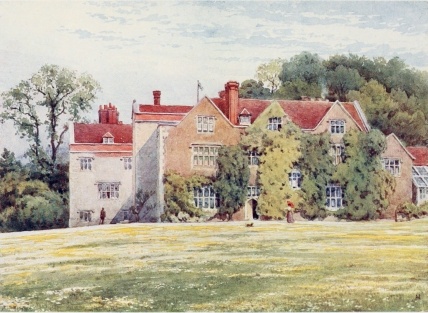
CHAWTON HOUSE
From Chawton it is a short mile to Alton, famous for its breweries and
hop gardens, and its church door, riddled with the bullets of the
Roundheads. Our way now leads us through the woods of Alice
Holt—Aisholt—the Ash wood; like Woolmer, a royal forest from Saxon
times. Alice Holt was renowned for the abundance of its fallow deer,
which made it a favourite hunting ground with the Plantagenet kings, and
on one occasion Edward II., it is said, gave one of his scullions,
Morris Ken, the sum of twenty shillings because he fell from his horse
so often out hunting,{51} “which made the king laugh exceedingly.”
Here, too, after the battle of Evesham, Edward, Prince of Wales,
defeated Adam de Gurdon, one of Simon de Montfort’s chief followers. He
is said to have challenged the rebel baron to a single combat, in which
Gurdon was wounded and made prisoner, but the victor spared his life and
afterwards obtained a royal pardon for his vanquished foe. A wild rugged
tract of country, Alice Holt was a chosen haunt of robbers and outlaws,
the terror of the wealthy London merchants who journeyed to St. Giles’
Fair at Winchester, and in the fourteenth century the wardens of the
fair kept five mounted serjeants-at-arms in the forest near Alton, for
their protection at that season.
Soon after leaving Alton the pilgrims would catch their first sight of
the river Wey, which rises close to the town. Along the banks of this
stream, flowing as it does through some of the loveliest Surrey scenery,
their road was now to lie, and not until they crossed St. Katherine’s
ferry, at Guildford, were they finally to lose sight of its waters. The
river itself, more than one{52} writer has suggested, may owe its name to
this circumstance, and have been originally called the Way river from
the ancient road which followed the early part of its course.

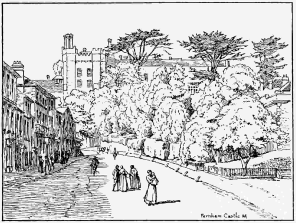
FARNHAM CASTLE.
Leaving Froyle Park, Sir Hubert Miller’s fine Jacobean house, on our
left, we pass Bentley Station, and, still following the river, join the
Portsmouth road just before entering Farnham. This town, which takes its
name from the commons overgrown with fern and heather still to be seen
in the neighbourhood on the Surrey side, is now surrounded with hop
gardens. It was among the earliest possessions of the Bishops of
Winchester, and formed part of the land granted to St. Swithun, in 860,
by Alfred’s elder brother, Ethelbald, King of Wessex. The Castle-palace,
which still looks proudly down on the streets of the little town, was
first built by that magnificent prelate, Henry of Blois, but little of
the original building now remains except the offices, where some round
Norman pillars may still be seen. Farnham Castle was partly destroyed by
Henry III. during his wars with the barons, and suffered greatly at the
hands of the rebels in the time{53} of Charles I., but was afterwards
rebuilt by Bishop Morley. Queen Elizabeth paid frequent visits here, and
on one occasion, while dining in the great hall with the Duke of
Norfolk, who was suspected of planning a marriage with Mary Queen of
Scots, pleasantly advised the Duke to be careful on what pillow he laid
his head. The lawn, with its stately cedars and grass-grown moat,
deserves a visit, but the most interesting{54} part of the building is the
fine old keep with its massive buttresses and thirteenth-century arches,
commanding a wide view over the elm avenues of the park, and the commons
which stretch eastward on the Surrey side. Prominent in the foreground
are the picturesque heights of Crooksbury, crowned with those tall pines
which Cobbett climbed when he was a boy, to take the nests of crows and
magpies.
Farnham, it must be remembered, was the birthplace of this remarkable
man, and it was at Ash, a small town at the foot of the Hog’s Back, that
he died in 1835. All his life long he retained the fondest affection for
these scenes of his youth. In 1825 he brought his son Richard, then a
boy of eleven, to see the little old house in the street where he had
lived with his grandmother, and showed him the garden at Waverley where
he worked as a lad, the tree near the Abbey from which he fell into the
river in a perilous attempt to take a crow’s nest, and the strawberry
beds where he gathered strawberries for Sir Robert Rich’s table, taking
care to eat the finest! Among these hills and commons, where he followed
the{55} hounds on foot at ten years old, and rode across country at
seventy, we forget the political aspect of his life, his bitter
invectives against the Poor-laws and Paper-money, the National Debt and
the System, and think rather of his keen love of nature and delight in
the heaths, the sandy coppices, and forests of Surrey and Hampshire. And
now he sleeps in the church of Farnham, where he desired to be buried,
in the heart of the wild scenery which he loved so well.

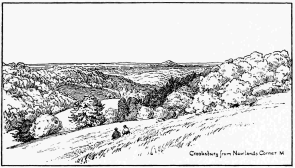
CROOKSBURY FROM NEWLANDS CORNER.
Just under Crooksbury, that “grand scene” of Cobbett’s “exploits,” lies
Moor Park, the retreat{56} of Sir William Temple in his old age, which
seemed to him, to quote his own words, “the sweetest place, I think,
that I have ever seen in my life, either before or since, at home or
abroad.” There we may still see the gardens which the statesman of the
Triple Alliance laid out after the fashion of those which he remembered
in Holland, where he enjoyed the companionship of his beloved sister,
Lady Giffard, and where his heart lies buried under the sundial. Here
Swift lived as his secretary, and learnt from King William III. how to
cut asparagus; here he wrote the “Tale of a Tub,” and made love to Mrs.
Hester Johnson, Lady Giffard’s pretty black-eyed waiting-maid. The
memory of that immortal love-story has not yet perished, and the house
where she lived is still known as Stella’s Cottage. Here, too, just
beyond Moor Park, on the banks of the Wey, are the ruins of Waverley
Abbey, the first Cistercian house ever founded in England, often
described as “le petit Cîteaux,” and the mother of many other abbeys.
The more distinguished pilgrims who stopped at Farnham would taste the
hospitality of the{57} monks of Waverley, and Henry III. was on one
occasion their guest. The Abbot of Waverley, too, was a great personage
in these parts, and his influence extended over several parishes through
which the pilgrims had to pass, although the privileges which he claimed
were often disputed by the Prior of Newark, the other ecclesiastical
magnate who reigned in this part of Surrey. Pilgrims of humbler rank
would find ample accommodation in the ancient hostelries of Farnham,
which was at that time a place of considerable importance, and returned
two members to Edward II.’s Parliament.
Their onward course now lay along the banks of the Wey until they
reached the foot of the narrow, curiously shaped chalk ridge known as
the Hog’s Back. Here, at a place called Whiteway End, the end of the
white chalk road, two roads divide. Both lead to Guildford, the one
keeping on the crest of the ridge, the other along its southern slope.
The upper road has become an important thoroughfare in modern times, and
is now the main road from Farnham to Guildford; the lower{58} is a grassy
lane, not always easy to follow, and little used in places, which leads
through the parishes of Seale, Puttenham, and Compton, the bright little
villages which stud the sides of the Hog’s Back. This green woodland
path under the downs was the ancient British and Roman track along which
the Canterbury pilgrims journeyed, and which is still in some places
spoken of by the inhabitants as the Way. Other names in local use bear
the same witness. Beggar’s Corner and Robber’s or Roamer’s Moor are
supposed to owe their appellations to the pilgrims: while the ivy-grown
manor-house of Shoelands, bearing the date of 1616 on its porch, is said
to take its name from the word “to shool,” which in some dialects has
the same meaning as “to beg.”
Another trace of the Pilgrimage is to be found in the local fairs which
are still held in the towns and villages along the road, and which were
fixed at those periods of the year when the pilgrims would be either
going to Canterbury or returning from there. Thus we find that at
Guildford the chief fair took place at Christmas, when the pilgrims
would be on their way to the{59} winter festival of St. Thomas, and was
only altered to September in 1312, by which time the original day of the
Saint’s martyrdom had ceased to be as popular as the summer feast. Again
the great fair at Shalford was fixed for the Feast of the Assumption,
the 15th of August, so as to catch the stream of pilgrims which flowed
back from Canterbury after the Feast of the Translation in July, and the
seven days’ fair there, that went by the name of Becket’s fair. Fairs
soon came to be held not only at towns such as Farnham, Guildford, and
Shalford, but at the small villages along the Pilgrims’ Road. There was
one in the churchyard at Puttenham, and another at Wanborough, a church
on the northern side of the hill, which belonged to Waverley Abbey,
where the offerings made by the pilgrims formed part of the payments
yearly received by the Abbot, while a third was held on St. Katharine’s
Hill during five days in September.
Even the churches along the road often owed their existence to the
Pilgrimage. The church of Seale was built early in the thirteenth
century by the Abbots of Waverley, and that of Wanborough{60} was rebuilt
by the same Abbots, and was again allowed to fall into decay when the
days of pilgrimages were over. Both the sister chapels of St. Katharine
and St. Martha, we shall see, owed their restoration to the pilgrims’
passage, and many more along the Way were either raised in honour of St.
Thomas, or else adorned with frescoes and altar-pieces of the Martyrdom.
Along this pleasant Surrey hill-side the old Canterbury pilgrims
journeyed, going from church to church, from shrine to shrine, and more
especially if their pilgrimage took place in summer, enjoying the sweet
country air and leafy shades of this quiet woodland region. They
lingered, we may well believe, at the village fairs, and stopped at
every town to see the sights and hear the news; for the pilgrim of
mediæval days was, as Dean Stanley reminds us, a traveller with the same
adventures, stories, pleasures, pains, as the traveller of our own
times, and men of every type and class set out on pilgrimages much as
tourists to-day start on a foreign trip. Some, no doubt, undertook the
journey from devotion, and more in{61} a vague hope of reaping some profit,
both material and spiritual, from a visit to the shrine of the
all-powerful Saint, while a thousand other motives—curiosity, love of
change and adventure, the pleasure of a journey—prompted the crowds who
thronged the road at certain seasons of the year. Chaucer’s company of
pilgrims we know was a motley crew, and included men and women whose
characters were as varied as their rank and trade. With them came a
throng of jugglers and story-tellers and minstrels, who beguiled the way
with music and laughter as they rode or walked along, so that “every
town they came through, what with the noise of their singing, and with
the sound of their piping, and with the jangling of their Canterbury
bells, and with the barking of the dogs after them, they made more noise
than if the king came there with all his clarions.” In their train, too,
a crowd of idle folk, of roving pedlars and begging friars and lazy
tramps, who were glad of any excuse to beg a crust or coin.
The presence of these last was by no means always welcome at the inns
and religious houses on the road, where doubtful characters often{62}
craved admittance, knowing that if the hand of justice overtook them
they could always find refuge in one of those churches where the rights
of sanctuary were so resolutely claimed and so jealously defended by the
Abbot of Waverley or the Prior of Newark.{63}

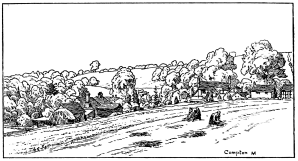
COMPTON VILLAGE.
CHAPTER IV
COMPTON TO SHALFORD
FOLLOWING the Pilgrims’ Way along the southern slopes of the Hog’s Back,
we cross Puttenham Heath, and reach the pretty little village of
Compton. Here, nestling under the downs, a few hundred yards from the
track, is a beautiful old twelfth-century church, which was there before
the days of St. Thomas. This ancient structure, dedicated to St.
Nicholas, still retains some good stained glass and boasts a unique
feature in the shape of a double-storied chancel. The east end of the
church is crossed by a low{64} semicircular arch enriched with Norman
zigzag moulding, and surmounted by a rude screen, which is said to be
the oldest piece of wood-work in England. Both the upper and the lower
sanctuaries have piscinas, and there is an Early English one in the
south aisle. The massive bases of the chalk pillars, the altar-tomb
north of the chancel—probably an Eastern sepulchre—and a hagioscope
now blocked up, all deserve attention, as well as the fine Jacobean
pulpit and chancel screen, which is now placed under the tower arch.

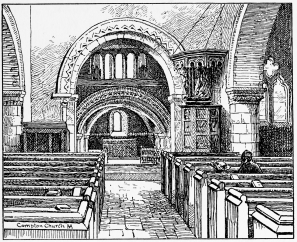
COMPTON CHURCH.

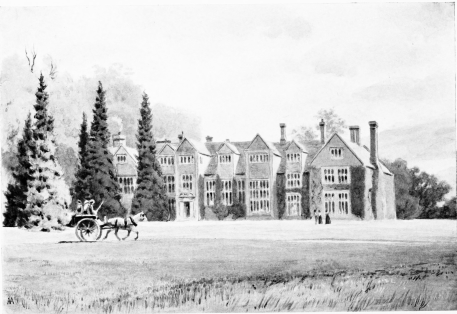
LOSELEY.
A mile to the west of this singularly interesting church is Loseley, the
historic mansion of the More and Molyneux family. This manor was Crown
property in the reign of Edward the Confessor, and is described in
Domesday Book as the property of the Norman Roger de Montgomery, Earl of
Shrewsbury, on whom it was bestowed by the Conqueror. After passing
through many hands it was finally bought from the Earl of Gloucester,
early in the sixteenth century, by Sir Christopher More, whose son, Sir
William, built the present mansion. The{65} grand old house with its
grey-stone gables and mullioned windows is a perfect specimen of
Elizabethan architecture. The broad grass terrace along the edge of the
moat, the yew hedges with their glossy hues of green and purple, the
old-fashioned borders full of bright flowers, and the low pigeon-houses
standing at each angle, all remain as they were in the reign of James
I.,{66} and agree well with Lord Bacon’s idea of what a pleasance ought to
be. Within, the walls are wainscoted with oak panelling throughout, and
the ceilings and mantelpieces are richly decorated. The cross and
mulberry tree of the Mores, with their mottoes, may still be seen in the
stained-glass oriel of the great hall, and on the cornices of the
drawing-room. Here too is a fine mantelpiece, carved in white chalk,
which is said to have been designed by Hans Holbein. Many are the royal
visitors who have left memorials of their presence at Loseley. Queen
Elizabeth had an especial affection for the place, and was here three
times. The cushioned seats of two gilt chairs were worked by her needle,
and there is a painted panel bearing the quaint device of a flower-pot
with the red and white roses of York and Lancaster, and the
fleur-de-lis, with the words Rosa Electa and Felicior Phœnice, a
pretty conceit which would not fail to find favour in the eyes of the
Virgin Queen. The hall contains portraits of James I. and his wife Anne
of Denmark, painted by Mytens in honour of a visit which they paid to
Loseley in the first year of{67} this monarch’s reign; and the ceiling of
his Majesty’s bedroom is elaborately patterned over with stucco reliefs
of Tudor roses and lilies and thistles. A likeness of Anne Boleyn, and
several fine portraits of members of the More family, also adorn the
walls, and there is a beautiful little picture of the boy-king, Edward
VI., wearing an embroidered crimson doublet and jewelled cap and
feather, painted by some clever pupil of Holbein in 1547. This portrait
was sent in 1890 to the Tudor Exhibition, which also contained many
historical documents relating to different personages of this royal
line, preserved among the Loseley manuscripts. There are warrants signed
by Edward VI., the Lord Protector, by Queen Elizabeth and the Lord of
her Council, including Hatton the Lord Chancellor, Cecil, Lord Burghley,
Lord Effingham, and Lord Derby. There is one of 1540, signed by Henry
VIII., commanding Christopher More, Sheriff of the County of Sussex, to
deliver certain goods forfeited to the crown to “Katheryn Howarde, one
of our quene’s maidens,” and another, signed by Elizabeth in the first
year of her reign, commanding{68} William More to raise and equip one
hundred able men, for the defence of England against foreign invasion.
There is also a curious sumptuary proclamation by Queen Elizabeth
respecting the dress and ornaments of women, and, what is still more
rare and interesting, a warrant from Lady Jane Grey, dated July 19, I.
Jane, and signed “Jane the Quene.” Among the more private and personal
papers is an amusing letter from Robert Horne, Bishop of Winchester,
giving Mr. More, of Loseley, advice as to stocking the new pond with the
best kind of carp, “thes be of a little heade, broade side and not long;
soche as be great headed and longe, made after the fashion of an
herring, are not good, neither will ever be.” Another from Bishop Day
informs Sir William More, in 1596, that he intends to fish the little
pond at Frensham; while one to the same gentleman from Alexander Nowell,
Dean of St. Paul’s, thanks him for his exertions to recover a stolen nag
on his behalf. The treasures of Loseley, in fact, are as inexhaustible
as its beauty.
A pleasant walk through the forest trees and{69} grassy glades of the park
leads us back to Compton village and the green lanes through which the
Pilgrims’ Way now wanders. Skirting the grounds of Monk’s Hatch, with
their pine-groves and rose-gardens lying under the chalk hanger, the old
road passes close to Limnerslease, the Surrey home of George Frederic
Watts. To-day thousands of pilgrims from all parts of the world seek out
this sylvan retreat where the great master spent his last years, and
visit the treasures of art which adorn its galleries, and the fair
chapel and cloister that mark the painter’s grave.

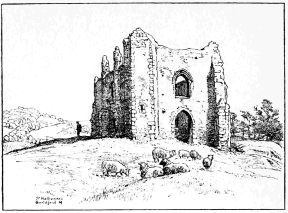
ST. KATHERINE’S, GUILDFORD.

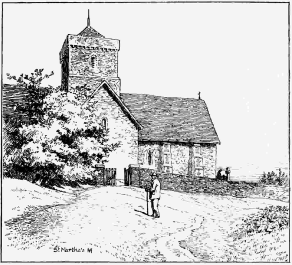
ST. MARTHA’S CHAPEL.
From Compton a path known as “Sandy Lane” leads over the hill past
Brabœuf Manor, and the site of the old roadside shrine of Littleton
Cross, and comes out on the open down, close to the chapel of St.
Katherine. This now ruined shrine, which stands on a steep bank near the
road, was rebuilt on the site of a still older one in 1317, by Richard
de Wauncey, Rector of St. Nicholas, Guildford, and was much frequented
by pilgrims to Canterbury. So valuable were the revenues derived by the
parson from their{70} offerings that the original grant made to Richard de
Wauncey was disputed, and for some years the Rector of St. Mary stepped
into his rights. But in 1329 the Rector of St. Nicholas succeeded in
ousting his rival, and the chapel was re-consecrated and attached to the
parish of St. Nicholas. An old legend ascribes the building of this
shrine and of the chapel on St. Martha’s Hill to two giant sisters of
primæval days, who raised the walls with their own hands and flung
their{71} enormous hammer backwards and forwards from one hill to the
other. Unlike its more fortunate sister-shrine, St. Katherine’s chapel
has long been roofless and dismantled, but it still forms a very
picturesque object in the landscape, and the pointed arches of its
broken windows frame in lovely views of the green meadows of the
winding{72} Wey, with the castle and churches of Guildford at our feet, and
the hills and commons stretching far away, to the blue ridge of
Hindhead.

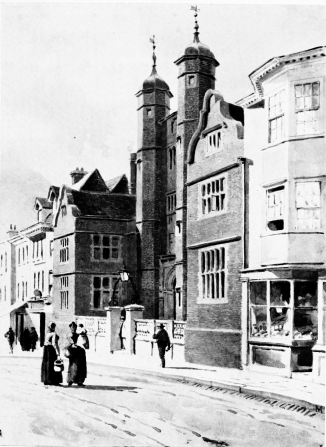
THE HOSPITAL, GUILDFORD. p. 72
The ancient city of Guildford owes its name and much of its historic
renown to its situation on the chief ford of the river Wey, which here
makes a break in the ridge of chalk downs running across Surrey.
Guildford is mentioned in his will by King Alfred, who left it to his
nephew Ethelwold, and became memorable as the spot where another Alfred,
the son of Knut and Emma, was treacherously seized and murdered by Earl
Godwin, who, standing on the eastern slope of the Hog’s Back above the
city, bade the young prince look back and see how large a kingdom would
be his. For seven centuries, from the days of the Saxon kings to those
of the Stuarts, Guildford remained Crown property, and the Norman keep
which still towers grandly above the city was long a royal palace. The
strength of the castle and importance of the position made it famous in
the wars of the barons, and the Waverley annalist records its surrender
to Louis VIII. of France, when he marched against{73} King John from
Sandwich Haven to Winchester. To-day the picturesqueness of the streets,
the gabled roofs and panelled houses, and even more the situation of the
town in the heart of this fair district, attract many artists, and make
it a favourite centre for tourists.

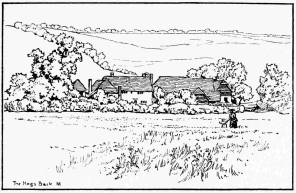
THE HOG’S BACK.
In mediæval times Guildford was a convenient halting-place for pilgrims
on their way from the south and west of England to the shrine of St.
Thomas. Many of these, however, as the shrewd parson of St. Nicholas
saw, when he{74} thought it worth his while to buy the freehold of the site
on which St. Katherine’s chapel stood, would push on and cross the river
by the ferry at the foot of the hill, which still bears the name of the
Pilgrims’ Ferry. On landing they found themselves in the parish of
Shalford, in the meadows where the great fair was held each year in
August. When the original charter was granted by King John, the fair
took place in the churchyard, but soon the concourse of people became so
great that it spread into the fields along the river, and covered as
much as one hundred and forty acres of ground. Shalford Fair seems, in
fact, to have been the most important one in this part of Surrey, and no
doubt owed its existence to the passage of the Canterbury pilgrims.{75}

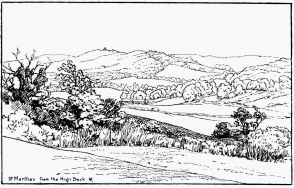
ST. MARTHA’S FROM THE HOG’S BACK.
CHAPTER V
SHALFORD TO ALBURY
THE line of the Pilgrims’ Way may be clearly followed from the banks of
the Wey up the hill. It goes through Shalford Park, up Ciderhouse Lane,
where the ancient Pesthouse or refuge for sick pilgrims and travellers,
now called Ciderhouse Cottage, is still standing, and leads through the
Chantrey Woods straight to St. Martha’s Chapel.
The district through which it takes us is one{76} of the wildest and
loveliest parts of Surrey. “Very few prettier rides in England,” remarks
Cobbett, who repeatedly travelled along this track, and the beauty of
the views all along its course will more than repay the traveller who
makes his way on foot over the hills from Guildford to Dorking. One of
the most extensive is to be had from St. Martha’s Hill, where the
prospect ranges in one direction over South Leith Hill and the South
Downs far away to the Weald of Sussex and the well-known clump of
Chanctonbury Ring; and on the other over the commons and moors to the
crests of Hindhead and the Hog’s Back; while looking northward we have a
wide view over the Surrey plains and the valley of the Thames, and
Windsor Castle and the dome of St. Paul’s may be distinguished on clear
days.
The ancient chapel on the summit, which gives its name to St. Martha’s
Hill, was originally built in memory of certain Christians who suffered
martyrdom on the spot, and was formerly dedicated to all holy martyrs,
while the hill itself was known as the Martyrs’ Hill, of which, as
Grose{77} remarks,[8] “the present name is supposed to be a corruption.” In
the twelfth century it became peculiarly associated with the Canterbury
pilgrims, and a new chancel was built for their use, and consecrated to
St. Thomas à Becket in the year 1186. In 1262 this chapel was attached
to the Priory of Newark, an Augustinian convent near Ripley, dedicated
to St. Thomas of Canterbury by Ruald de Calva in the reign of Richard
Cœur de Lion. The Prior already owned most of the hill-side, and the
names of Farthing Copse and Halfpenny Lane, through which the pilgrims
passed on their way to St. Martha’s Chapel, remind us of the tolls which
he levied from all who travelled along the road. We have already seen
how in the earlier portions of the Way the Prior of Newark disputed the
rights of the Abbot of Waverley. Here he reigned supreme. A priest from
Newark Priory served St. Martha’s Chapel, and is said to have lived at
Tyting’s Farm, an old gabled house with the remains of a small oratory
close to the Pilgrims’ Way. In latter days a colony of monks{78} from
Newark settled at Chilworth, where the present manor-house contains
fragments of monastic building, and the fishponds of the friars may
still be seen near the terraced gardens. During the troubled times of
the Wars of the Roses the Chapel of St. Martha fell into ruins, and owed
its restoration to Bishop William of Waynflete, who in 1463 granted
forty days’ indulgence to all pilgrims who should visit the shrine and
there repeat a Pater Noster, an Ave, and a Credo, or contribute to its
repair. After the dissolution of the monasteries both Newark Priory and
St. Martha’s shrine fell into ruins, and the chapel was only restored of
late years. At Chilworth, south of St. Martha’s Hill, lies the once fair
valley which has been defaced by the powder-mills, first established
there three centuries ago by an ancestor of John Evelyn, and now worked
by steam. This is the place which Cobbett denounces in his “Rural Rides”
with a vigour and eloquence worthy of Mr. Ruskin himself:
“This valley, which seems to have been created by a bountiful Providence
as one of the choicest{79} retreats of man, which seems formed for a scene
of innocence and happiness, has been by ungrateful man so perverted as
to make it instrumental in effecting two of the most damnable of
purposes, in carrying into execution two of the most damnable inventions
that ever sprang from the mind of man under the influence of the devil!
namely, the making of gunpowder and of bank-notes! Here, in this
tranquil spot, where the nightingales are to be heard earlier and later
in the year than in any other part of England; where the first budding
of the buds is seen in spring; where no rigour of season can ever be
felt; where everything seems formed for precluding the very thought of
wickedness; here has the devil fixed on as one of the seats of this
grand manufactory; and perverse and ungrateful man not only lends his
aid, but lends it cheerfully. To think that the springs which God has
commanded to flow from the sides of these happy hills for the comfort
and delight of man—to think that these springs should be perverted into
means of spreading misery over a whole nation!”{80}
One of these “inventions of the devil” has been removed. The paper-mills
which made the bank-notes in Cobbett’s time are silent now, but the
powder-mills are in full activity, and Chilworth, with its coal-stores
and railway-crossing, has a blackened and desolate look which not all
the natural beauties of its surroundings can dispel.

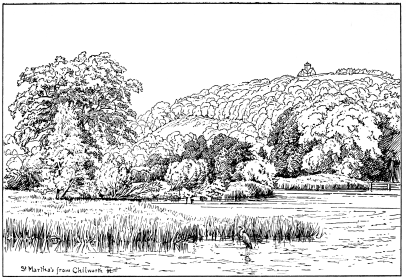
ST. MARTHA’S FROM CHILWORTH.
Once more upon the hills, we can follow the line of yews which are seen
at intervals along the ridge from St. Martha’s Chapel by Weston Wood and
the back of Albury Park, turning a few steps out of our path to visit
Newland’s Corner, the highest point of Albury Downs, and one of the most
beautiful spots in the whole of Surrey. The view is as extensive as that
from St. Martha’s Hill, and is even more varied and picturesque. Over
broken ridges of heathery down and gently swelling slopes, clad with
beech and oak woods, we look across to Ewhurst Mill, a conspicuous
landmark in all this country, and farther westward to the towers of
Charterhouse and the distant heights of Hindhead and Blackdown; while
immediately in front, across the wooded valley, rises St. Martha’s Hill,
crowned{81} by its ancient chapel. Here we can watch the changes of sun
and shower over the wide expanse of level country, and see the long
range of far hills veiled in the thin blue mists of morning, or turning
purple under the gold of the evening sky. Some of the oldest and finest
yew trees in all Surrey are close to Newland’s Corner—the ancient yew
grove there is mentioned in Domesday—and their dark foliage offers a
fine contrast to the bright tints of the neighbouring woods and to the
snowy masses of blossom which in early summer clothe the gnarled old
hawthorn trees that are studded over the hill-side. We can follow the
track over the springy turf of the open downs and up glades thick with
bracken, till it becomes choked with bushes and brambles, and finally
loses itself in the woods of Albury.
Here, in the middle of the Duke of Northumberland’s park, is the deep
glen, surrounded by wooded heights, known as the Silent Pool. A dark
tale, which Martin Tupper has made the subject of his “Stephen Langton,”
belongs to this lonely spot. King John, tradition says, loved a fair
woodman’s daughter who lived here,{83} and surprised her in the act of
bathing in the pool. The frightened girl let loose the branch by which
she held, and was drowned in the water; and her brother, a goat-herd,
who at the sound of her scream had rushed in after her, shared the same
fate. And still, the legend goes, at midnight you may see a black-haired
maiden clasping her arms round her brother in his cowhide tunic under
the clear rippling surface of the Silent Pool.
A little farther on is the old church of Albury—Eldeburie, mentioned in
Domesday, and supposed to be the most ancient in Surrey. The low tower,
with its narrow two-light windows, probably dates back to very early
Norman times, but the rest of the church is considerably later. The
south chapel was richly decorated by Mr. Drummond, who bought the place
in 1819, and is now used as a mortuary chapel for his family. Albury
formerly belonged to the Dukes of Norfolk. The gardens were originally
laid out by Thomas Howard, Earl of Arundel, the accomplished collector
of the Arundel marbles, and whose fine portrait by Vandyck was
exhibited{84} at Burlington House in the winter of 1891. His friend and
neighbour, Mr. Evelyn, helped him with his advice and taste, and
designed the grotto under the hill, which still remains. “Such a
Pausilippe,” remarks the author of “The Sylva,” “is nowhere in England
besides.” But the great ornament of Albury is the famous yew hedge,
about ten feet high and a quarter of a mile long, probably the finest of
its kind in England. So thick are the upper branches of the yew trees
that, as William Cobbett writes, when he visited Albury in Mr.
Drummond’s time, they kept out both the rain and sun, and alike in
summer and winter afford “a most delightful walk.” The grand terrace
under the hill, “thirty or forty feet wide, and a quarter of a mile
long, of the finest green-sward, and as level as a die,” particularly
delighted him; and the careful way in which the fruit trees were
protected from the wind, and the springs along the hill-side collected
to water the garden, gratified his practical mind. “Take it altogether,”
he goes on, “this certainly is the prettiest garden that I ever beheld.
There was taste and sound judgment at every step in the{85} laying out of
this place. Everywhere utility and convenience is combined with beauty.
The terrace is by far the finest thing of the sort that I ever saw, and
the whole thing altogether is a great compliment to the taste of the
times in which it was formed.” The honest old reformer’s satisfaction in
these gardens was increased by the reflection that the owner was worthy
of his estate, seeing that he was famed for his justice and kindness
towards the labouring classes—“who, God knows, have very few friends
amongst the rich;” and adds, that he for one has no sympathy with “the
fools” who want a revolution for the purpose of getting hold of other
people’s property. “There are others who like pretty gardens as well as
I, and if the question were to be decided according to the laws of the
strongest, or, as the French call it, droit du plus fort, my chance
would be but a very poor one.”

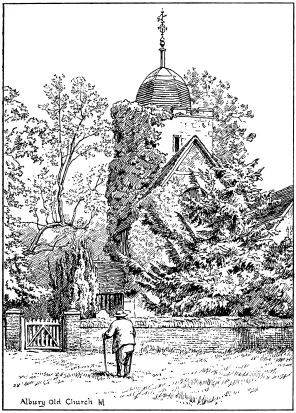
ALBURY OLD CHURCH.
{87}

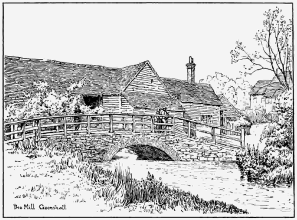
THE MILL, GOMSHALL.
CHAPTER VI
SHERE TO REIGATE
THE Pilgrims’ Way ran through Albury Park, passing close to the old
church and under the famous yew hedge, and crossed the clear trout
stream of the Tillingbourne by a ford still known as “Chantry Ford.”
Here a noble avenue of lime trees brings us to Shere church, a building
as remarkable for the beauty of its situation as for its architectural
interest. The lovely Early{88} English doorway, the heavy transitional
arches of the nave and the fourteenth-century chancel are still unhurt,
and among the fragments of old glass we recognise the flax-breaker,
which was the crest of the Brays, one of the oldest families in the
county, who are, we rejoice to think, still represented here. Shere
itself is one of the most charming villages in all this lovely
neighbourhood. For many years now it has been a favourite resort of
artistic and literary men, who find endless delight in the quiet beauty
of the surrounding country. Subjects for pen and pencil abound in all
directions; quaint old timbered houses, picturesque water-mills and
barns, deep ferny lanes shaded by overhanging trees, and exquisite
glimpses of heather-clad downs meet us at every turn. Fair as the scene
is, travellers are seldom seen in these hilly regions; and so complete
is the stillness, so pure the mountain air, that we might almost fancy
ourselves in the heart of the Highlands, instead of thirty miles from
town. Here it was, in the midst of the wild scenery of these Surrey
Hills, that a sudden end closed the life of a great prelate of our own
days,{89} Samuel Wilberforce, Bishop of Winchester. A granite cross at
Evershed’s Rough, just below Lord Farrer’s house at Abinger Hall, now
marks the spot where his horse stumbled and fell as he rode down the
hill towards Holmbury on that summer afternoon.

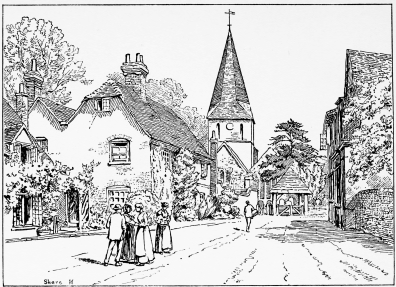
SHERE.

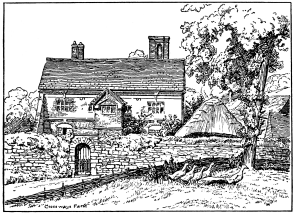
CROSSWAYS FARM, NEAR WOTTON.[9]
About a mile beyond Abinger we reach the home of John Evelyn, and see
the grey tower of the church where he is buried. This is Wotton—the
town of the woods, as he loved to call it—“sweetly environed” with
“venerable woods and delicious streams;” Wotton where, after all his
wanderings and all the turmoil of those troublous times, Evelyn found a
peaceful haven wherein to end his days. There are the terraces, the
“fountains and groves,” in which he took delight; there, too, are the
pine-woods which he planted, not only for ornament, and because they
“create a perpetual spring,” but because he held the air to be improved
by their “odoriferous and balsamical emissions.” Not only these trees,
but the oak and ash, and all the different species which he studied so
closely and has written about so well, were dear to him as his own
children, and he{91} speaks in pathetic language of the violent storm which
blew down two thousand of his finest trees in a single night, and almost
within sight of his dwelling, and left Wotton, “now no more Woodtonn,
stripped and naked, and almost ashamed to own its name. Methinks that I
still hear, and I am sure that I feel, the dismal groans of our{92}
forests, when that late dreadful hurricane, happening on the 26th of
November, 1703, subverted so many thousands of goodly oaks, prostrating
the trees, laying them in ghastly postures, like whole regiments fallen
in battle by the sword of the conqueror, and crushing all that grew
beneath them.” Evelyn’s descendants have bestowed the same care on the
woods and plantations, and in spite of the havoc wrought by wind and
tempest, Wotton is still remarkable for the beauty of its forest-trees
and masses of flowering rhododendrons.

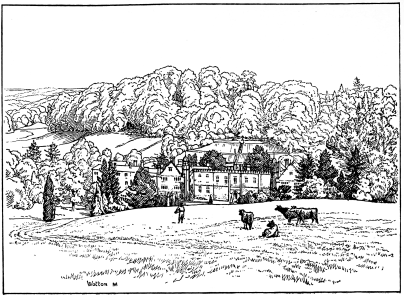
WOTTON.
The red-brick house has been a good deal altered during the present
century, but is still full of memorials of Evelyn. His portrait, and
that of his wife and father-in-law, Sir Richard Browne, are there, and
that of his “angelic friend,” Mistress Blagge, the wife of Godolphin,
whose beautiful memory he has enshrined in the pages of the little
volume that bears her name. The drawings which he made on his foreign
travels are there too; and better still, the books in which he took such
pride and pleasure, carefully bound, bearing on their backs a device and
motto which he chose,{93} a spray of oak, palm, and olive entwined
together, with the words, “Omnia explorate; meliora retinete.” But the
most precious relic of all is the Prayer Book used by Charles I. on the
morning of his execution. It was saved from destruction by a devoted
loyalist, Isaac Herault, brother of a Walloon minister in London, and
afterwards given by him to Evelyn’s father-in-law, Sir Richard Browne.
The fly-leaf bears a Latin inscription with this note:—This is the
Booke which Charles the First, Martyr beatus, did use upon the
Scaffold, XXX Jan., 1649, being the Day of his glorious martyrdom.”
The exact course of the Pilgrims’ Way here is uncertain. After leaving
Shere church it disappears, and we must climb a steep lane past Gomshall
station, to find the track again on Hackhurst Downs. The line of yews is
to be seen at intervals all along these downs, and as we descend into
the valley of the Mole, opposite the heights of Box Hill, we pass four
venerable yew trees standing in a field by themselves. One of the group
was struck by lightning many years ago, but still stretches its gaunt,
withered arms{95} against the sky, like some weather-beaten sign-post
marking the way to Canterbury.

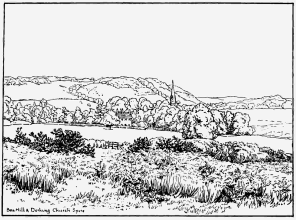
BOX HILL AND DORKING CHURCH SPIRE.
The town of Dorking lies in the break here made in the chalk hills by
the passage of the river Mole; Milton’s “sullen Mole that windeth
underground,” or, as Spenser sings in his “Faërie Queen,”—
“Mole, that like a mousling mole doth make
His way still underground, till Thames he overtake.”
{96}

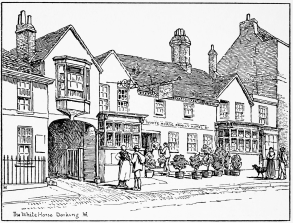
THE WHITE HORSE, DORKING.
The Mole owes its fame to the fact that it is so seldom seen, and
several of the swallows or gullies into which it disappears at intervals
along its chalky bed are at Burford, close to Dorking. The ponds which
supplied the perch for that water-sousie which Dutch merchants came to
eat at Dorking, are still to be seen in the fields under Redhill, and
near them many an old timbered house and mill-wheel well worth
painting.{97}

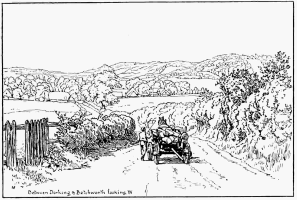
BETWEEN DORKING AND BETCHWORTH LOOKING WEST.
To-day Dorking is a quiet, sleepy little place, but its situation on the
Stane Street, the great Roman road from Chichester to London, formerly
made it a centre of considerable importance, and the size and excellence
of the old-fashioned inns still bear witness to its departed grandeur.
Whether, as seems most probable, the old road ran under the wall of
Denbies Park, and across the gap now made by the Dorking lime works, or
whether, as the Ordnance map indicates, it crossed the breezy{98} heights
of Ranmore Common, pilgrims to Canterbury certainly crossed the Mole at
Burford Bridge about half a mile from the town. The remains of an
ancient shrine known as the Pilgrims’ Chapel are still shown in
Westhumble Lane. The path itself bears the name of Paternoster Lane, and
the fields on either side are called the Pray Meadows. From this point
the path runs along under Boxhill, the steep down that rises abruptly on
the eastern side of Dorking, and takes its name from the box-trees which
here spring up so plentifully in the smooth green turf above the chalk.
Boxhill is, we all know, one of the chief attractions which Dorking
offers to Londoners. The other is to be found in the fine parks of
Deepdene and Betchworth, immediately adjoining the town. The famous
gardens and art collections of Deepdene, and the noble lime avenue of
Betchworth, which now forms part of the same estate, have often been
visited and described. The house at Deepdene is now closed to the
public, but the traveller can still stroll under the grand old trees on
the river bank, and enjoy a wealthy variety of forest scenery{99} almost
unrivalled in England. A picturesque bridge over the Mole leads back to
the downs on the opposite side of the valley, where the old track
pursues its way along the lower slope of the hills, often wending its
course through ploughed fields and tangled thickets and disappearing
altogether in places where chalk quarries and lime works have cut away
the face of the down. But on the whole the line of yews which mark the
road is more regular between Dorking and Reigate than in its earlier
course, and at Buckland, a village two miles west of Reigate, a whole
procession of these trees descends into the valley.

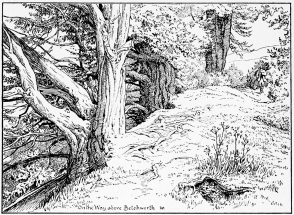
ON “THE WAY” ABOVE BETCHWORTH.
All this part of the road is rich in Roman remains. Of these one of the
most interesting was the building discovered in 1875, at Colley Farm, in
the parish of Reigate, just south of the Way. Not only were several
cinerary urns and fragments of Roman pottery dug up, but the walls of a
Roman building were found under those of the present farmhouse. Some
twenty years ago a similar building was discovered at Abinger, also in
the immediate vicinity of the{100} track, but unfortunately it was
completely destroyed in the absence of the owner, Sir Thomas Farrer.
Another Roman house came to light in 1813, at Bletchingley, and one
chamber, which appeared to be a hypocaust, was excavated at the time.
Lastly, considerable Roman remains have been discovered and carefully
excavated by Mr. Leveson-Gower in the park at Titsey. Of these the most
important are a Roman villa, which was{101} thoroughly excavated in 1864,
together with a group of larger buildings, apparently the farm belonging
to the ancient house. These are only a few of the principal links in the
chain of Roman buildings which lie along the course of this ancient
trackway, and which all help to prove its importance as a thoroughfare
at the time of the Roman occupation.
Another point of interest regarding this part of the Pilgrims’ Way is
its connection with John Bunyan. When his peculiar opinions and open-air
preachings had brought him into trouble with the authorities, he came to
hide in these Surrey hills, and earned his living for some time as a
travelling tinker. Two houses, one at Horn Hatch, on Shalford Common,
the other at Quarry Hill, in Guildford, are still pointed out as having
been inhabited by him at this time; and a recent writer[10] has
suggested that in all probability the recollections of Pilgrimage days,
then fresh in the minds of the people, first gave him the idea{102} of his
“Pilgrim’s Progress.” Certainly more than one incident in the history of
the road bears a close resemblance to the tale of Christian’s
adventures. Thus, for instance, the swampy marshes at Shalford may have
been the Slough of Despond, the blue Surrey hills seen from the distance
may well have seemed to him the Delectable Mountains, and the name of
Doubting Castle actually exists at a point of the road near Box Hill.
Lastly, the great fair at Shalford corresponds exactly with Bunyan’s
description of Vanity Fair, no newly erected business, but “a thing of
ancient standing,” where “the ware of Rome and her merchandise is
greatly promoted ... only our English nation have taken a dislike
thereat.” In the days when Bunyan wrote, the annual fair had degenerated
into a lawless and noisy assembly, where little trade was done, and much
drinking and fighting and rude horseplay went on, as he may have found
to his cost. The wares of Rome, in fact, were commodities no longer in
fashion, and soon the fair itself came to an end and passed away, like
so many other things that had been called into being by the Canterbury
Pilgrimage.{103}

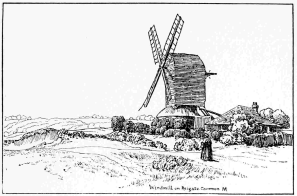
WINDMILL ON REIGATE COMMON.
CHAPTER VII
REIGATE TO CHEVENING
ALTHOUGH the town of Reigate lies in the valley, it certainly takes its
name from the Pilgrims’ Road to Canterbury. In Domesday it is called
Cherchfelle, and it is not till the latter part of the twelfth century
that the comparatively modern name of Rigegate, the Ridge Road, was
applied, first of all to the upper part of the parish, and eventually to
the whole town. In those days a chapel dedicated to the memory of the
blessed{104} martyr, St. Thomas, stood at the east end of the long street,
on a site now occupied by a market-house, built early in the last
century, and part of the ancient foundations of this pilgrimage shrine
were brought to light when the adjoining prison was enlarged some eighty
or ninety years back. Another chapel, dedicated to St. Laurence the
Martyr, stood farther down the street; and a third, the Chapel of Holy
Cross, belonged to the Augustine Canons of the Priory founded by William
of Warrenne, Earl of Surrey, in the thirteenth century. In Saxon days
Reigate, or Holm Castle, as it was then termed, from its situation at
the head of the valley of Holmesdale, was an important stronghold, and
the vigour and persistence with which the incursions of the Danes were
repelled by the inhabitants of this district gave rise to the rhyme
quoted by Camden—
“The Vale of Holmesdale
Never wonne, ne never shall.”

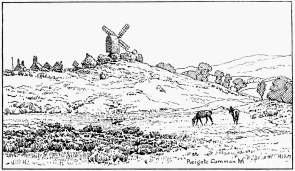
REIGATE COMMON.
At the Conquest the manor was granted to William of Warrenne, and from
that time the{105} castle became the most powerful fortress of the mighty
Earls of Surrey. In the days of John it shared the fate of Guildford
Castle, and was one of the strongholds which opened its gates to Louis
VIII., King of France, on his march from the Kentish Coast to
Winchester. The Fitzalans succeeded the Warrennes in the possession of
Reigate, and in the reign of Edward VI., both the castle and the Priory
were granted to the Howards of Effingham. Queen Elizabeth’s Lord High
Admiral, the victor of the Invincible Armada, lies buried in the vault
under the{106} chancel of Reigate Church. In Stuart times the castle
gradually fell into decay, until it was finally destroyed by order of
Parliament, during the Civil War, lest it should fall into the King’s
hands. Now only the mound of the ancient keep remains, and some spacious
subterranean chambers which may have served as cellars or dungeons in
Norman times. The Priory has also been replaced by a modern house, and
is the property of Lady Henry Somerset, the representative of the Earl
Somers, to whom William III. granted Reigate in 1697.
Reigate is frequently mentioned in Cobbett’s “Rural Rides,” and it was
the sight of the Priory that set him moralising over monasteries and
asking himself if, instead of being, as we take it for granted, bad
things, they were not, after all, better than poor-rates, and if the
monks and nuns, who fed the poor, were not more to be commended than
the rich pensioners of the State, who feed upon the poor.
Close to this ancient foundation is the hilly common known as Reigate
Park, a favourite haunt with artists, who find endless subjects in the{107}
fern-grown dells and romantic hollows, the clumps of thorn-trees with
their gnarled stems and spreading boughs, their wealth of wild flowers
and berries. The views over Reigate itself and the Priory grounds on one
side, and over the Sussex Weald on the other, are very charming; but a
still finer prospect awaits us on the North Downs on the opposite side
of the valley, where the Pilgrims’ Road goes on its course. The best way
is to climb Reigate Hill as far as the suspension bridge, and follow a
path cut in the chalk to the summit of the ridge. It leads through a
beechwood on to the open downs, where, if the day is clear, one of the
finest views in the whole of England—in the whole world, says
Cobbett—breaks upon us. The Weald of Surrey and of Sussex, from the
borders of Hampshire to the ridge of East Grinstead, and Crowborough
Beacon, near Tunbridge Wells, lies spread out at our feet. Eastward, the
eye ranges over the Weald of Kent and the heights above Sevenoaks;
westward the purple ridge of Leith Hill and the familiar crest of
Hindhead meet us; and far away to the south are the Brighton downs and
Chanctonbury Ring.{108}

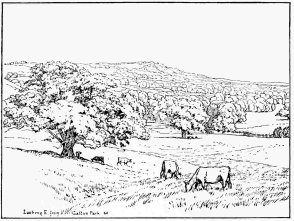
LOOKING EAST FROM GATTON PARK.
The line of yew trees appears again here, and after keeping along the
top of the ridge for about a mile, the Pilgrims’ Way enters Gatton Park,
and passing through the woods near Lord Oxenbridge’s house, joins the
avenue that leads to Merstham. Gatton itself, which, like Reigate, takes
its name from the Pilgrims’ Road—Saxon, Gatetun, the town of the
road—was chiefly famous for the electoral privileges which it so long
enjoyed.{109} From the time of Henry VI. until the Reform Bill of 1832, this
very small borough returned two members to Parliament. In the reign of
Henry VIII. Sir Roger Copley is described as the burgess and sole
inhabitant of the borough and town of Gatton, and for many years the
constituency consisted of one person, the lord of the manor.
At the beginning of the present century there were only eight houses in
the whole parish, a fact which naturally roused the ire of William
Cobbett. “Before you descend the hill to go into Reigate,” he writes in
one of his Rural Rides, “you pass Gatton, which is a very rascally spot
of earth.” And when rainy weather detained him a whole day at Reigate,
he moralises in this vein—“In one rotten borough, one the most rotten
too, and with another still more rotten up upon the hill, in Reigate
and close by Gatton, how can I help reflecting, how can my mind be
otherwise than filled with reflections on the marvellous deeds of the
collective wisdom of the nation?” These privileges doubled the value of
the property, and when Lord Monson bought Gatton Park in{110} 1830, he paid
a hundred thousand pounds for the place; but the days of close boroughs
were already numbered, and less than two years afterwards the Reform
Bill deprived Gatton of both its members. The little town hall of
Gatton, where the important ceremony of electing two representatives to
serve in Parliament was performed, is still standing, an interesting
relic of bygone days, on a mound in the park, almost hidden by large
chestnut trees.

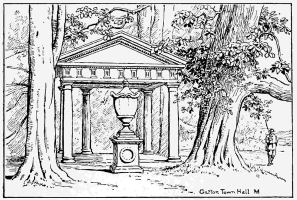
GATTON TOWN HALL.
{111}
Gatton House is chiefly remarkable for the marble hall built by the same
Lord Monson in imitation of the Orsini Chapel at Rome, and adorned with
rich marbles which he had brought from Italy. The collection of
pictures, formed by the same nobleman, contains several good Dutch and
Italian pictures, including the “Vierge au bas-relief,” a graceful Holy
Family, which takes its name from a small carved tablet in the
background. It was long held to be an early work by the great Leonardo
da Vinci, and was purchased by Lord Monson of Mr. Woodburn for £4,000,
but is now generally attributed to his pupil, Cesare da Sesto.
Like so many of the churches we have already mentioned, like Seale and
Wanborough, and the chapels of St. Katherine and St. Martha, like the
old church at Titsey and the present one at Chevening, Gatton was
originally a Pilgrims’ church. Now it has little that is old to show,
for it was restored by Lord Monson in 1831, and adorned with a variety
of treasures from all parts of the Continent. The stained glass comes
from the monastery of Aerschot, near Louvain, the{112} altar-rails from
Tongres, the finely carved choir-stalls and canopies from Ghent, and the
altar and pulpit from Nuremberg. Like most of the mediæval wood-work and
glass which has come to England from that “Quaint old town of toil and
traffic, Quaint old town of art and song,” these last are said to have
been designed by the great master of the Franconian city, Albert Dürer.

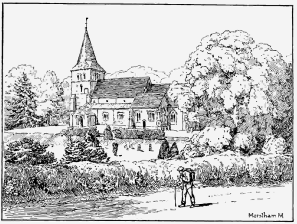
MERSTHAM CHURCH.
The Pilgrims’ Way, as has been already said, runs through Gatton Park,
and brings us out close to Merstham, and through lanes shaded with fine
oaks and beeches we reach the pretty little village, with its old
timbered cottages and still older church buried in the woods. Local
writers of the last century frequently allude to the Pilgrims’ Road as
passing through this parish, although its exact course is not easy to
trace. It seems, however, certain that the track passed near Lord
Hylton’s house, and south of the church, which stands close by. In
mediæval times, Merstham formed part of the vast estates held by the
monks of Christ Church, Canterbury, and was bestowed upon them by
Athelstan, a son{113} of Ethelred the Unready, in the tenth century. There
was a church here at the time of the Norman Conquest, but the only
portion of the present building dating from that period is a fine old
square Norman font which, like several others in the neighbourhood, is
of Sussex marble. Of later date, there is much that is extremely
interesting. The tower and the west door are Early English, and the
chancel arch is adorned{114} with curious acanthus-leaf mouldings, while the
porch and chancel are Late Perpendicular.
After passing Merstham Church the track is lost in a medley of roads and
railway cuttings, but soon the line of yews appears again, climbing the
crest of the hill, and can be followed for some distance along White
Hill, or Quarry Hangers, as these downs are commonly called. The next
object of interest which it passes is the War Camp, or Cardinal’s Cap,
as it is sometimes termed, an old British earthwork on the face of the
chalk escarpment. Then the path turns into a wood, and we leave it to
descend on Godstone. This is a fascinating spot for artists. The low
irregular houses are grouped round a spacious green and goose-pond,
shaded by fine horse-chestnuts, and there is a charming inn, the White
Hart or Clayton Arms, with gabled front and large bay-windows of the
good old-fashioned type. “A beautiful village,” wrote Cobbett, ninety
years ago, “chiefly of one street, with a fine large green before it,
and with a pond in the green;” and he goes on to speak of the neatness
of the gardens and of the double violets,{115} “as large as small pinks,”
which grew in the garden of this same inn, and of which the landlady was
good enough to give some roots. Happily for his peace of mind, he adds,
“The vile rotten borough of Bletchingley, which lies under the downs
close by, is out of sight.”

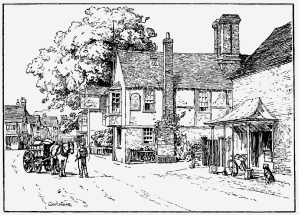
THE WHITE HART, GODSTONE.

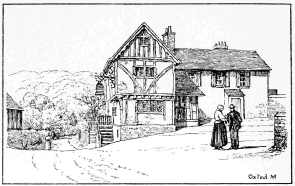
OLD HOUSE IN OXTED.
From Godstone it is a pleasant walk over the open commons, along the top
of the ridge, looking over the Weald of Sussex and across{116} the valleys
of Sevenoaks and Tunbridge to the Kentish hills. Once more we track the
line of the Pilgrims’ Way as it emerges from the woods above the
Godstone quarries and, passing under Winder’s Hill and by Marden Park,
reaches a wood called Palmers Wood. The name is significant, more
especially since there is no record of any owner who bore that name.
Here its course is very clearly defined, and when, in the autumn of
1890, pipes for carrying water out of the hill were laid down, a section
of the old{117} paved road was cut across. A little farther on, at
Limpsfield Lodge Farm, just on the edge of Titsey park, it formed the
farm road till 1875. At this point the path was ten feet wide, and the
original hedges remained. Before entering the park of Titsey, the way
runs through part of Oxted parish, where a spring still bears the name
of St. Thomas’s Well, and then reaches Titsey Place.

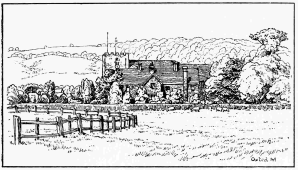
OXTED CHURCH.
Few places in this part of Surrey are more attractive than this old home
of the Greshams. The purity of the air, praised by Aubrey long{118} ago for
its sweet, delicate, and wholesome virtues, the health-giving breezes of
the surrounding downs and commons, the natural loveliness of the place,
and the taste with which the park and gardens have been laid out, all
help to make Titsey a most delightful spot. Its beautiful woods stretch
along the grassy slopes of Botley Hill, and the clump of trees on the
heights known as Cold-harbour Green is 881 feet above the sea, and marks
the loftiest point in the whole range of the North Downs. Wherever the
eye rests, one ridge of wooded hill after the other seems to rise and
melt away into the soft blue haze. Nor is there any lack of other
attractions to invite the attention of scholar and antiquary. The place
is full of historic associations. A whole wealth of antiquities, coins,
urns, and pottery, have been dug up in the park, and some remains of
Roman buildings were discovered there a few years ago, close to the
Pilgrims’ Way. After the conquest Titsey was given to the great Earls of
Clare, who owned the property at the time of the Domesday Survey. In the
fourteenth century it belonged{119} to the Uvedale family, and two hundred
years later was sold to Sir John Gresham, an uncle of Sir Thomas
Gresham, the illustrious merchant of Queen Elizabeth’s court, and the
founder of the Royal Exchange. A fine portrait of Sir Thomas himself, by
Antonio More, now hangs in the library of Titsey Place. Unfortunately
the Greshams suffered for their loyalty to Charles I., and after the
death of the second Sir Marmaduke Gresham in 1742, a large part of the
property was sold. His son, Sir John, succeeded in partly retrieving the
fortunes of the family, and rebuilt and enlarged the old manor-house,
which had been allowed to fall into a ruinous state. But the Tudor
arches of the east wing still remain, as well as much of the fine oak
panelling which adorned its walls; and the crest of the Greshams, a
grasshopper, may still be seen in the hall chimney-piece. The present
owner, Mr. Leveson-Gower, is a lineal descendant of the last baronet,
and inherited Titsey from his great-grandmother Katherine, the heiress
of the Greshams. The fourteenth-century church was unluckily pulled down
a hundred years ago,{120} because Sir John Gresham thought it stood too near
his own house, but an old yew in the garden and some tombstones of early
Norman date still mark its site. The course of the Pilgrims’ Way through
the Park is clearly marked by a double row of fine ash trees, and the
flint stones with which the road itself is paved may still be seen under
the turf. Further along the road is a very old farmhouse, which was
formerly a hostelry, and still bears the name of the Pilgrims’ Lodge.
From Titsey the Way runs along the side of the hills, under Tatsfield
Church, which stands on{121} the summit of the ridge, and about a mile above
the pretty little towns of Westerham and Brasted. Here the boundary of
the counties is crossed, and the traveller enters Kent. Soon we reach
the gates of Chevening Park, where, as at Titsey, the Pilgrims’ Way
formerly passed very near the house, until it was closed by Act of
Parliament in 1780.

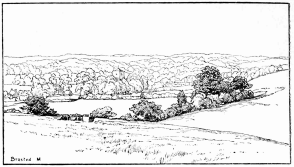
BRASTED.
The manor of Chevening, originally the property of the See of
Canterbury, was held in the thirteenth and fourteenth centuries by the
family of Chevening, from whence it passed to the Lennards, who became
Barons Dacre and Earls of Sussex. In the last century it was bought by
General Stanhope, the distinguished soldier and statesman, who, after
reducing the island of Minorca, served King George I. successively as
Secretary of State and First Lord of the Treasury. Inigo Jones built the
house for Richard Lennard, Lord Dacre, early in the seventeenth century,
but since then it has undergone such extensive alterations that little
of the original structure remains, and the chief interest lies in a
valuable collection of historical{122} portraits, including those of the
Chesterfields, Stanhopes, and the great Lord Chatham. The last-named
statesman, whose daughter Hester married Charles, Lord Stanhope, in
1774, was a frequent visitor at Chevening, and is said to have planned
the beautiful drive which leads through the woods north of the house to
the top of the downs. The little village of Chevening lies on the other
side of the park, just outside Lord Stanhope’s gates and close to the
old church of St. Botolph, which was one of the shrines frequented by
the pilgrims on their way to Canterbury. There are some good Early
English arches in the nave and chancel, and a western tower of
Perpendicular date. The south chapel contains many imposing sepulchral
monuments to the different lords of the manor. Amongst them are those of
John Lennard, who was sheriff of the county and held several offices
under the crown in the reigns of Henry VIII. and Elizabeth, and of his
son Sampson, who with his wife Margaret, Lady Dacre in her own right,
reposes under a sumptuous canopy of alabaster surrounded by kneeling
effigies of their children. There is{123} also a fine black marble monument
to the memory of James, Earl of Stanhope, the prime minister of George
I., who was buried here with great pomp in 1721. He was actually in
office at the time of his death, and was taken ill in the House of
Lords, and breathed his last the next day. But the most beautiful tomb
here is Chantrey’s effigy of Lady Frederica Stanhope sleeping with her
babe in her arms, and an expression of deep content and peace upon her
quiet face.

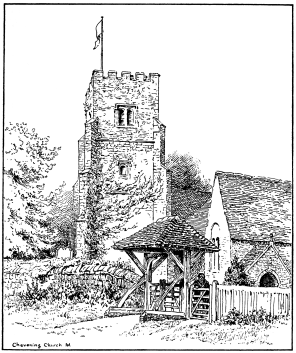
CHEVENING CHURCH.
“Storms may rush in, and crimes and woes
Deform the quiet bower;
They may not mar the deep repose
Of that immortal flower.”
{125}

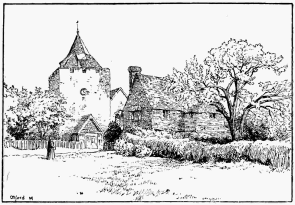
OTFORD CHURCH.
CHAPTER VIII
OTFORD TO WROTHAM
WE have followed the Pilgrims’ Way over Hampshire Downs and Surrey hills
and commons, through the woods which Evelyn planted, and along the ridge
where Cobbett rode. We have seen the track become overgrown with tangled
shrubs and underwood, and disappear altogether in places. We have lost
the road at one point in the fields, to find it again half a mile
further; we have noted the regular lines of yews climbing{126} up the
hill-side, and the lonely survivors which are left standing bare and
desolate in the middle of the corn-fields. The part of the ancient road
on which we are now entering differs in several important respects from
its earlier course. From the time the Pilgrims’ Way enters Kent its
track is clearly marked. Already we have followed its line through
Titsey and along the downs as far as Chevening, where the path, now
closed, may be traced through Lord Stanhope’s Park. A group of
magnificent old yew trees arrests our attention just beyond Chevening,
before the road from Sevenoaks to Bromley is crossed. Then the Way
descends into the valley of the Darent, an excellent trout-stream which
flows north through this chalk district to join the Thames near
Dartford, and after crossing the ford over that river, regains the hills
at Otford. From this place it runs along under the hill in one unbroken
line all the way to Eastwell Park, between Ashford and Canterbury. It is
a good bridle-way, somewhat grass-grown in places, in others enclosed by
hedges, and still used by farmers for their carts. Before toll-bars
were{127} abolished there was a good deal of traffic along this part of the
Pilgrims’ Road, which, running as it does parallel with the turnpike
road along the valley to Ashford, was much used as a means of evading
the payment of toll. This cause is now removed, and excepting for an
occasional hunting-man who makes use of the soft track along the
hill-side, or a camp of gipsies sitting round their fire, waggoners and
ploughmen are the only wayfarers to be met with along the Pilgrims’
Road. But the old name still clings to the track, and as long as the
squires of Kent have any respect for the traditions of the past, any
particle of historic sense remaining, they will not allow the Pilgrims’
Way to be wiped out.
In actual beauty of scenery this portion of the Way may not equal the
former part. We miss the wild loveliness of Surrey commons, the rare
picturesqueness of the rolling downs round Guildford and Dorking, but
this Kentish land has a charm of its own, which grows upon you the
longer you know it. These steep slopes and wooded hollows, these grand
old church towers and quaint village streets, these homesteads with{128}
their vast barns of massive timber and tall chimney-stacks overshadowed
with oaks and beeches, cannot fail to delight the eyes of all who find
pleasure in rural scenes. And all along our way we have that noble
prospect over the wide plains of the dim blue Weald, which is seldom
absent from our eyes, as we follow this narrow track up and down the
rugged hill-side. In historic interest and precious memorials of the
past, this part of the Pilgrims’ Way, we need hardly say, is
surpassingly rich. Endless are the great names and stirring events which
these scenes recall: battlefields where memorable fights were fought in
days long ago, churches and lands that were granted to the Archbishops
or Abbots of Canterbury before the Conquest, manor-houses which our
kings and queens have honoured with their presence in the days of yore.
All these things, and many more of equal interest and renown, will the
traveller find as he follows the Pilgrims’ Way along the chalk hills
which form the backbone of Kent.
The first resting-place which the pilgrims would find on this part of
their route would be{129} the Archbishop’s manor-house at Otford. There were
no less than fifteen of these episcopal residences in different parts of
Kent, Surrey, and Sussex, and of these, three lay along the Kentish
portion of the Pilgrims’ Way. The palace at Otford possessed an especial
sanctity in the eyes of wayfarers journeying to the shrine of St.
Thomas, as having been a favourite residence of the martyred Archbishop
himself. The manor was originally granted to the See of Canterbury in
791, by Offa, king of Mercia, who defeated Aldric, king of Kent, at
Otford in 773, and conquered almost the whole province.
More than two hundred years later, Otford was the scene of another
battle, in which Edmund Ironside defeated the Danes under Knut, and to
this day bones are dug up in the meadow which bears the name of
Danefield. From the tenth century the Archbishops had a house here, and
Otford is described in the Domesday Survey as Terra Archiepi
Cantuariensis. So it remained until Cranmer surrendered the palace,
with many other of his possessions, to Henry VIII. The mediæval
Archbishops seem to have had an{130} especial affection for Otford, and
spent much of their time at this pleasant country seat. Archbishop
Winchelsea entertained Edward I. in 1300, and was living here at the
time of his death thirteen years later, when his remains were borne by
the King’s command to Canterbury, and buried there with great state.
Simon Islip enclosed the park, and Archbishop Deane repaired the walls;
but the whole was rebuilt on a grander scale by Warham, who spent
upwards of thirty thousand pounds upon the house, and received Henry
VIII. here several times in the first years of his reign.
After Otford had become Crown property, the Archbishop’s manor-house
passed into the hands of the Sydneys and Smyths, who dismantled the
castle, as it was then commonly called, and allowed the walls to fall
into ruin. Two massive octagonal towers of three stories, with double
square-headed windows, and a fragment of a cloister, now used as farm
stables, are the only portions remaining. These evidently formed part of
the outer court, and are good specimens of fifteenth-century brickwork.
The tower was considerably{131} higher a hundred years ago, and Hasted
describes the ruins as covering nearly an acre of ground. The stones of
the structure were largely used in the neighbouring buildings, and the
Bull Inn contains a good deal of fine oak wainscoting, and several
handsome carved mantelpieces, which originally belonged to the castle.
Two heads in profile, carved in oak over one of the fireplaces, are said
to represent Henry VIII. and Katherine of Aragon. A bath, or chamber,
paved and lined with stone, about thirty feet long, and ten or twelve
feet deep, not far from the ruins, still bears the name of Becket’s
Well. Tradition ascribes the birth of the spring which supplies it to
St. Thomas, who, finding no water at Otford, struck the hill-side with
his staff, and at once brought forth a clear stream, which since then
has never been known to fail. Another legend tells how the Saint one
day, being “busie at his prayers in the garden at Otford, was much
disturbed by the sweete note and melodie of a nightingale that sang in a
bush beside him, and in the might of his holinesse commanded all birds
of this kind to be henceforth silent,” after which{132} the nightingale was
never heard at Otford. But with the decay of the palace and the
departure of the Archbishops, the spell was broken; and the Protestant
Lambarde, when he was at Otford, takes pleasure in recording how many
nightingales he heard singing thereabouts.

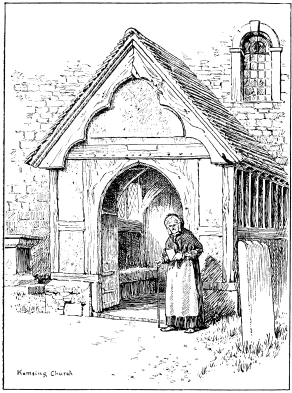
THE PORCH, KEMSING CHURCH.
From Otford the Pilgrims’ Way runs along the edge of the hills about
half a mile above the villages of Kemsing and Wrotham, and passes close
to St. Clere, a mansion built by Inigo Jones, where Mrs. Boscawen, the
witty correspondent of Mrs. Delany and the friend of Johnson and
Boswell, was born. Kemsing still retains its old church and well, both
consecrated to the memory of the Saxon Princess, St. Edith, whose image
in the churchyard was, during centuries, the object of the peasants’
devout veneration. “Some seelie bodie,” writes Lambarde, who visited
these shrines in Queen Elizabeth’s reign, and delights in pouring
contempt on the old traditions of these country shrines, “brought a
peche or two, or a bushelle of corne, to the churche after praiers made,
offered it to the image of the saint. Of this offering the priest used
to toll the greatest{133} portion, and then to take one handful or little
more of the residue (for you must consider he woulde bee sure to gaine
by the bargaine), the which, after aspersion of holy water and the
mumbling of a fewe words of conjuration, he first dedicated to the image
of Saint Edith, and then delivered it backe to the partie that brought
it; who departed with full persuasion that if he mingled that hallowed
handfull with his seede corne, it would preserve from harme and prosper
in growthe the whole heape that he should sowe, were it never so great a
stacke.”

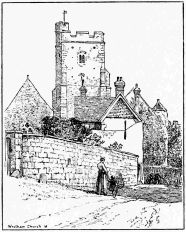
WROTHAM CHURCH.
Wrotham was the site of another of the Archbishops’ manor-houses, and
rivalled Otford in antiquity, having been granted to the See of
Canterbury by Athelstan in 964. Wrotham was never as favourite a
residence with the Archbishops as Otford, but they stopped here
frequently on their progresses through Kent, until, in the fourteenth
century, Simon Islip pulled down the house to supply materials for the
building of his new palace at Maidstone. A terrace and some scanty
remains of the offices are the only fragments now to be seen at Wrotham,
but{135} the charming situation of the village in the midst of luxuriant
woods, and the beauty of the view over the Weald from Wrotham Hill,
attract many visitors. The church has several features of architectural
interest, including a handsome rood-screen of the fourteenth century,
and a watching-chamber over the chancel, as well as a curious archway
under the tower, which was probably{136} used as a passage for processions
from the Palace. It contains many tombs and brasses, chiefly of the
Peckham family, who held the manor of Yaldham in this parish for upwards
of five hundred years. Below the church is Wrotham Place, a fine old
Tudor house with a corridor and rooms of the fifteenth century, and a
charming garden front bearing the date 1560. Fairlawn, the ancestral
home of the Vanes, also lies in a corner of Wrotham parish, and a
terrace, bordered with close-clipped yew hedges, and surrounded by sunny
lawns, where peacocks spread their tails over the grass, is still
pointed out as a favourite walk of that stout old regicide, Sir Harry
Vane. Ightham, with its famous Mote, so perfect a picture of an old
English house, is close by, within a walk of Wrotham station, but lies,
unluckily, on the opposite side from the line of hills along which our
path takes us.{137}

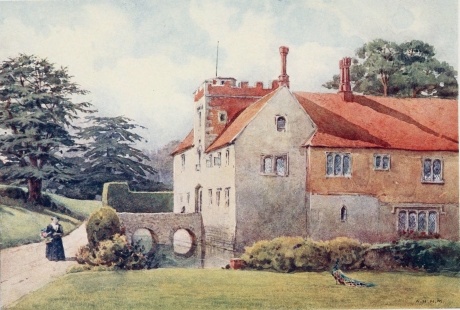
THE MOTE, IGHTHAM

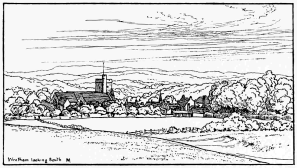
WROTHAM, LOOKING SOUTH.
CHAPTER IX
WROTHAM TO HOLLINGBOURNE
THE Pilgrims’ Way continues its course over Wrotham Hill and along the
side of the chalk downs. This part of the track is a good bridle road,
with low grass banks or else hedges on either side, and commands fine
views over the rich Kentish plains, the broad valley of the Medway, and
the hills on the opposite shore. The river itself glitters in the sun,
but as we draw nearer the beauty of the prospect is sorely marred by the
ugly chimneys and dense smoke of the Snodland limestone works.{138}
At one point on the downs, close to the Vigo Inn, a few hundred yards
above our road, there is a very extensive view over the valley of the
Thames, ranging from Shooters’ Hill to Gravesend, and far away out to
sea. In the daytime the masts of the shipping in the river are clearly
seen. At night the Nore lights twinkle like stars in the distance. The
height of these downs is close on 700 feet, that of Knockholt is 783
feet. On the other side of the Medway the chalk range is considerably
lower, and the highest points are above Detling, 657 feet,
Hollingbourne, 606 feet, and Charing, 640 feet.

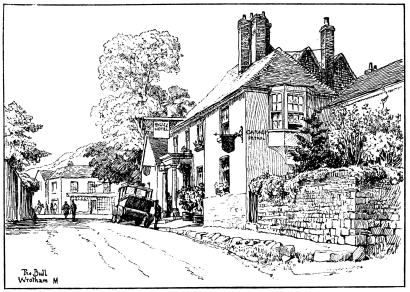
THE BULL, WROTHAM.
The Way now runs past Pilgrims’ house, formerly the Kentish Drovers’
Inn, above the old church and village of Trottescliffe (Trosley) and the
megalithic stones known as Coldrum circle, one of the best preserved
cromlechs along the road. Further on a short lane leads south to Birling
Place, the ancient home of the Nevills, who have owned the estate since
the middle of the fifteenth century, while in a group of old farm
buildings at Paddlesworth (formerly Paulsford) we find the remains of a
Norman Pilgrims’{139} Chapel, with a fine Early English arch. The track now
crosses a large field and enters Snodland, an old town containing many
Roman remains, and an interesting church, but sadly disfigured by cement
works and paper factories.

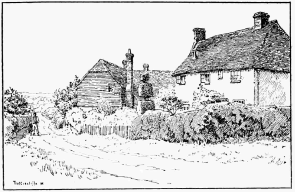
TROTTESCLIFFE.
Here the pilgrims left the hills to descend into the valley below. Twice
before, at Shalford and Dorking, they had crossed the rivers which make
their way through the chalk range; now they had reached the third great
break in the downs, and the broad stream of the Medway lay{141} at their
feet. They might, if they pleased, go on to Rochester, three miles
higher up, and join the road taken by the London pilgrims along the
Watling Street to Canterbury—the route of Chaucer’s pilgrimage. But
most of them, it appears, preferred to follow the hills to which they
had clung so long.

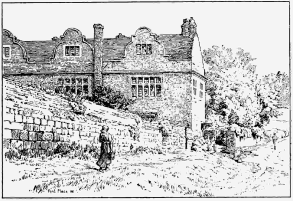
FORD PLACE, NEAR WROTHAM.
The exact point where they crossed the river has been often disputed.
According to the old maps it was by the ford at Cuxton, where the{142} river
was shallow enough to allow of their passage. From Bunker’s Farm,
immediately above Birling, a road diverges northwards to Cuxton and
Rochester, and was certainly used by many of the pilgrims. At Upper
Halling, on this track, we may still see the lancet windows of a
pilgrims’ shrine formerly dedicated to St. Laurence, which have been
built into some cottages known as Chapel houses. The Bishops of
Rochester, who held this manor from Egbert’s days, had “a right fair
house” at Lower Halling, on the banks of the Medway, with a vineyard
which produced grapes for King Henry III.’s table. This pleasant
manor-house on the river was the favourite summer residence of Bishop
Hamo de Hethe, who built a new hall and chapel in the reign of Edward
I., and placed his own statue on a gateway which was still standing in
the eighteenth century. Another interesting house, Whorne Place, lies a
little higher up, on the banks of the Medway, where the grass-grown
track leading from Bunker’s Farm joins the main road to Cuxton and
Rochester. This fine brick mansion formerly{143} belonged to the Levesons,
and the quarterings of Sir John Leveson and his two wives are to be seen
above the central porch.

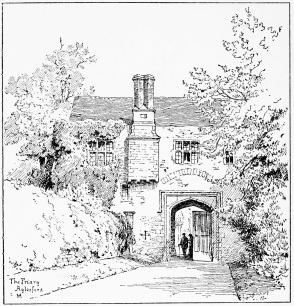
THE FRIARY, AYLESFORD.
In the thirteenth century a great number of pilgrims seem to have
stopped at Maidstone, where, in 1261, Archbishop Boniface built a
hospital for their reception on the banks of the Medway. The funds which
supported this hospital, the Newark—New-work, Novi operis, as it was
called—were diverted by Archbishop Courtenay, a hundred and forty years
later, to the maintenance of his new college of All Saints, on the
opposite side of the river, but a remnant of the older foundation is
still preserved in the beautiful Early English Chancel of St. Peter’s
Church, which was originally attached to Boniface’s hospital, and is
still known as the Pilgrims’ Chapel. By the time that Archbishop
Courtenay founded his college, the stream of pilgrims had greatly
diminished, and the hostel which had been intended for their
resting-place was rapidly sinking into a common almshouse. Maidstone,
too, no doubt, lay considerably out of the pilgrims’ course, and the
great majority naturally preferred{144} to cross the Medway by the ferry at
Snodland. Others again might choose Aylesford, which lay a mile or two
below. At this ancient town, the Eglesford of the Saxon Chronicle, there
was a{145} stone bridge across the river, and a Carmelite Priory founded in
1240 by Richard de Grey, on his return from the Crusades, where the
pilgrims would be sure to find shelter. But even if they did not cross
the Medway at this place, where the old church stands so picturesquely
on its high bank overhanging river and red roofs, the pilgrims certainly
passed through the parish of Aylesford. For on the opposite banks of the
ferry at Snodland the familiar line of yew trees appears again,
ascending the hill by Burham church, and runs through the upper part of
Aylesford parish, close to the famous dolmen of Kits Coty House. This
most interesting sepulchral monument, Kêd-coit—Celtic for the Tomb in
the Wood—consists of three upright blocks of sandstone about eight feet
high and eight feet broad, with a covering stone of eleven feet which
forms the roof, and is one of a group of similar remains which lie
scattered over the hill-side and are locally known as the Countless
Stones. We have here, in fact, a great cemetery of the Druids which once
extended for many miles on both sides of the river. Deep pits dug out in
the{146} chalk, filled with flints and covered with slabs of stone, have
been discovered on Aylesford Common, and a whole avenue of stones
formerly connected this burial place with the cromlechs at Addington,
six miles off. Here, if the old legend be true, was fought the great
battle which decided the fate of Britain, and gave England into the
hands of the English. For at this place, the old chroniclers say, about
the year 455, the Saxon invaders stopped on their march to the Castle of
Rochester, and turning southwards met the Britons in that deadly fray,
when both Kentigern and Horsa were left dead on the field of battle.
Ancient military entrenchments are still visible on the hill-side near
Kits Coty House, and a boulder on the top was long pointed out as the
stone on which Hengist was proclaimed the first king of Kent.
About a mile from this memorable spot, in the plains at the foot of the
downs, was a shrine which no pilgrim of mediæval days would leave
unvisited, the Cistercian Abbey of Boxley, then generally known as the
Abbatia S. Crucis de Gracias, the Abbey of the Holy Rood of Grace.{147}

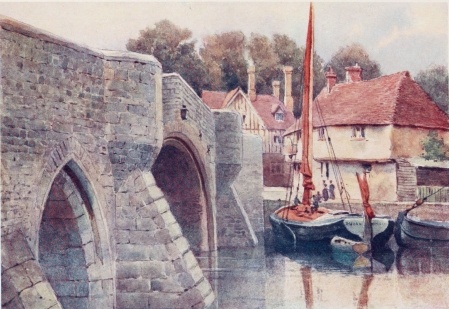
AYLESFORD BRIDGE

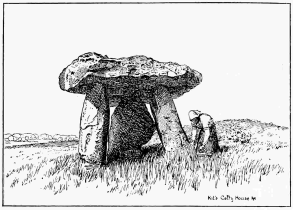
KITS COTY HOUSE.
Not only was Boxley, next to Waverley Abbey, the oldest Cistercian house
founded on this side of the Channel, the filia propria of the great
house of Clairvaux, but the convent church rejoiced in the possession of
two of the most celebrated wonder-working relics in all England. There
was the image of St. Rumbold, that infant child of a Saxon prince who
proclaimed himself a Christian the moment of his birth, and after three
days spent in edifying his pagan hearers,{148} departed this life. This
image could only be lifted by the pure and good, and having a hidden
spring, which could be worked by the hands or feet of the monks, was
chiefly influenced by the amount of the coin that was paid into their
hands. And there was that still greater marvel, the miraculous Rood, or
winking image, a wooden crucifix which rolled its eyes and moved its
lips in response to the devotees who crowded from all parts of England
to see the wondrous sight. The clever mechanism of this image, said to
have been invented by an English prisoner during his captivity in
France, was exposed by Henry VIII.’s commissioners in 1538, who
discovered “certayn ingyns of old wyer with olde roten stykkes in the
back of the same,” and showed them to the people of Maidstone on
market-day, after which the Rood of Grace was taken to London and
solemnly broken in pieces at Paul’s Cross. The Abbey of Boxley owned
vast lands, and the Abbots were frequently summoned to Parliament, and
lived in great state. Among the royal guests whom they entertained was
King Edward II., whose visit was made memorable by the letter which{149} he
addressed from Boxley Abbey to the Aldermen of the City of London,
granting them the right of electing a Lord Mayor. At one time their
extravagance brought them to the verge of ruin, as we learn from a
letter which Archbishop Warham addressed to Cardinal Wolsey; but at the
dissolution the Commissioners could find no cause of complaint against
the monks, excepting the profusion of flowers in the convent garden,
which made them comment on the waste of turning “the rents of the
monastery into gillyflowers{150} and roses.” The foundations of the church
where the Cistercians showed off their “sotelties” may still be traced
in the gardens of the house built by Sir Thomas Wyatt on the site of the
abbey. Here some precious fragments of the ruins are still preserved.
The chapel of St. Andrew, which stood near the great gateway, has been
turned into cottages, and the noble “guesten-house,” where strangers
were lodged, is now a barn. The old wall remains to show the once vast
extent of the Abbey precincts. Now these grey stones are mantled with
thick bushes of ivy, and a fine clump of elm trees overshadows the
red-tiled roof of the ancient guest-house in the meadows, but we look in
vain for poor Abbot John’s gillyflowers and roses.

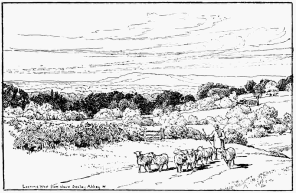
LOOKING WEST FROM ABOVE BOXLEY ABBEY.
Between Boxley Abbey and Maidstone stretches the wide common of Penenden
Heath, famous from time immemorial as the place where all great county
meetings were held. Here the Saxons held their “gemotes,” and here in
1076, was that memorable assembly before which Lanfranc pleaded the
cause of the Church of Canterbury against Odo, Bishop of Bayeux, Earl{151}
of Kent, the Conqueror’s half-brother, who had defrauded Christ Church
of her rights, and laid violent hands on many of her manors and lands.
Not only were the Kentish nobles and bishops summoned to try the cause,
but barons and distinguished ecclesiastics, and many men “of great and
good account,” from all parts of England and Normandy, were present that
day. Godfrey, Bishop of Coutances, represented the King, and Agelric,
the aged Bishop of Chester, “an ancient man well versed in the laws and
customs of the realm,” was brought there in a chariot by the King’s
express command. Three days the trial lasted, during which Lanfranc
pleaded his cause so well against the rapacious Norman that the see of
Canterbury recovered its former possessions, and saw its liberties
firmly established.
The village and church of Boxley (Bose-leu in Domesday), so called from
the box trees that grow freely along the downs, as at Box Hill, are
about a mile and a half beyond the Abbey, and lie on the sloping ground
at the foot of the hills, close to the Pilgrims’ Way. Old houses and
timbered barns, with lofty gables and irregular{152} roofs, are grouped
round the church, which is itself as picturesque an object as any, with
its massive towers and curious old red-tiled Galilee porch. Next we
reach Detling, a small village, prettily situated on the slope of the
hills, with a church containing a rare specimen of mediæval wood-work in
the shape of a carved oak reading-desk, enriched with pierced tracery of
the Decorated period. We pass Thurnham, with the foundations of its
Saxon castle high up on the downs, and then enter Hollingbourne. As
Boxley reminds us of the box trees on the hill-side, and Thurnham of the
thorn trees in the wood, so Hollingbourne owes its name to the hollies
on the burn or stream which runs through the parish. William Cobbett,
whose memory has followed us all the way from the Itchen valley,
describes how he rode over Hollingbourne Hill on his return from Dover
to the Wen, and from the summit of that down, one of the highest in this
neighbourhood, looked down over the fair Kentish land, which in its
richness and beauty seemed to him another Garden of Eden.{153}

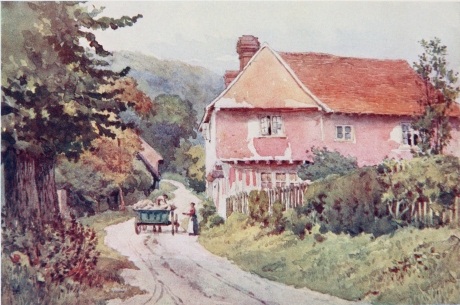
COTTAGE AT BOARLEY, NEAR BOXLEY
CHAPTER X
HOLLINGBOURNE TO LENHAM
THE village of Hollingbourne lies at the foot of the hill, and an old
inn at the corner of the Pilgrims’ Road, now called the King’s Head, was
formerly known by the name of the Pilgrims’ Rest. The history of
Hollingbourne is full of interest. The manor was granted to the church
at Canterbury, “for the support of the monks,” by young Athelstan, the
son of Æthelred II., in the year 980, and was retained by the monastery
when Lanfranc divided the lands belonging to Christ Church between the
priory and the see. It is described in Domesday as Terra Monachorum
Archiepi, the land of the monk and the Archbishop; in later records as
Manorium Monachorum et de cibo eorum, a manor of the monks and for
their food. The Priors of Christ Church held{154} their courts here, and the
convent records tell us that Prior William Sellyng greatly improved the
Priory rooms at Hollingbourne. Their residence probably occupied the
site of the present manor-house. This handsome red-brick building, rich
in gables and mullions, in oak panelling and secret hiding-places, was
built in Queen Elizabeth’s reign by the great Kentish family of the
Culpepers, who at that time owned most of the parish. More than one
fragment of the earlier house, encased in the Elizabethan building, has
been brought to light, and a pointed stone archway of the thirteenth
century, and an old fireplace with herring-bone brickwork, have lately
been discovered. Many are the interesting traditions which belong to
this delightful old manor-house. The yews in the garden are said to have
been planted by Queen Elizabeth on one of her royal progresses through
Kent, when she stayed at Leeds Castle, and was the guest of Sir Henry
Wotton at Boughton Malherbe. According to another very old local
tradition, Katherine Howard, whose mother was a Culpeper, spent some
years here as a girl, and the ghost of that unhappy{155} queen is said to
haunt one of the upper chambers of the house. Another room, called the
Needle-Room, was occupied during the Commonwealth by the daughters of
that faithful loyalist, John Lord Culpeper, Frances, Judith, and
Philippa, who employed the weary years of their father’s exile in
embroidering a gorgeous altar-cloth and hangings, which they presented
to the parish church on the happy day when the king came back to enjoy
his own again. The tapestries, worked by the same deft fingers, which
once adorned the chambers of the manor-house, are gone, and the hangings
of the reading-desk in the church have been cut up into a frontal, but
the altar-cloth remains absolutely intact, and is one of the finest
pieces of embroidery of the kind in England. Both design and colouring
are of the highest beauty. On a ground of violet velvet, bordered with a
frieze of cherub heads, we see the twelve mystic fruits of the Tree of
Life—the grape, orange, cherry, apple, plum, pear, mulberry, acorn,
peach, medlar, quince, and pomegranate. The richest hues of rose and
green are delicately blended together, and their effect{157} is heightened
by the gold thread in which the shading is worked. The lapse of two
centuries and a half has not dimmed the brightness of their colours,
which are as fresh as if the work had been finished yesterday. A needle
which had been left in a corner of the altar-cloth all those long years
ago was still to be seen sticking in the velvet early in the last
century, but has now disappeared.

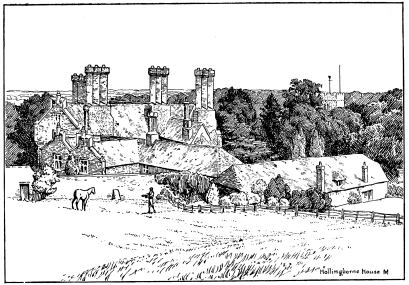
HOLLINGBOURNE HOUSE.
This goodly manor-house was only one of several seats belonging to the
Culpepers in this neighbourhood. They had a mansion at Greenway Court,
which was burnt down in the last century, and another of imposing
dimensions where Grove Court now stands. In the seventeenth century the
Lords Culpeper also owned Leeds Castle, that noble moated house, a mile
to the south, which was once a royal park, and is still one of the
finest places in Kent. But the second Lord Culpeper died without a male
heir in 1688, and this famous house passed by marriage into the Fairfax
family. The Hollingbourne branch of the Culpepers died out in the course
of the last century, and at the present time no member{158} of this
illustrious family is known to exist in England, although persons
bearing this ancient name are still to be found in America. The church
at Hollingbourne contains a whole series of Culpeper monuments. The most
remarkable is the white marble altar-tomb, which bears the recumbent
effigy of Elizabeth Lady Culpeper, who died in 1638, and is described in
the inscription on her monument as Optima Fœmina, Optima Conjux, et
Optima Mater. This lady was the heiress of the Cheney family, whose
arms, the ox’s hide and horns, appear on the shield at the foot of the
tomb, and are repeated in the stained glass of the chapel window.
Tradition says that Sir John Cheney had his helmet struck off, when he
fought by the victor’s side on Bosworth Field, and fixed a bull’s horns
on his head in its place. Afterwards Henry VII. gave him this crest,
when he made him a Baron and a Knight of the Garter, in reward for his
valour on that hard-fought field. A monument on the north wall of the
chancel records the memory of John Lord Culpeper, who was successively
Chancellor of the Exchequer, Master of the Rolls, and Privy Councillor
to{159} Charles I. and Charles II. “For equal fidelity to the king and
kingdome,” says the epitaph on his tomb, “he was most exemplary.” He
followed the last-named king into exile and remained there until the
Restoration, when “with him he returned tryumphant into England on the
29th of May, 1660,” only to die six weeks afterwards, “to the
irreparable losse of his family.” Another descendant of the Culpepers is
buried under the altar in this church, Dame Grace Gethin, a great
grand-daughter of Sir Thomas Culpeper, and wife of Sir Richard Gethin,
of Gethinge Grott, in Ireland, whose learning and virtues were so
renowned that monuments were erected in her honour both at Bath and in
Westminster Abbey. This youthful prodigy, who died at the age of
twenty-one, is here represented kneeling between two angels, and holding
in her hand the commonplace book which she filled with extracts from her
favourite authors, and which was afterwards published under the title of
“Reliquiæ Gethinianæ.” Her piety was as great as her personal charms,
and the inscription on her monument records how, “being adorned with all
the Graces and{160} Perfections of mind and body, crowned them all with
exemplary Patience and Humility, and having the day before her death
most devoutly received the Holy Communion, which she said she would not
have omitted for Ten Thousand Worlds, she was vouchsafed in a miraculous
manner an immediate prospect of her future Blisse, for the space of two
hours, to the astonishment of all about her, and being, like St. Paul,
in an unexpressible Transport of joy, thereby fully evincing her
foresight of the Heavenly Glory, in unconceivable Raptures triumphing
over Death, and continuing sensible to the last, she resigned her pious
soul to God, and victoriously entered into rest, Oct. 11th, anno ætatis
21, D’ni: 1697. Her dear and affectionate Mother, whom God in mercy
supported by seeing her glorious end, erected this monument, she being
her last surviving issue.”
Soon after leaving Hollingbourne, the Pilgrims’ Way enters the grounds
of Stede Hill, and passes through the beech-woods that spread down the
grassy slopes to the village and church of Harrietsham—Heriard’s Home
in Domesday—in the{161} valley below. An altar-tomb, to the memory of Sir
William Stede, who died in 1574, and several other monuments to members
of the same family, may be seen in the south chapel of the church, a
fine building of Early English and Perpendicular work, with a good
rood-screen, standing in an open space at the foot of the Stede Hill
grounds. The rectory of Harrietsham was formerly attached to the
neighbouring Priory of Leeds, but was granted by Henry VI. to Archbishop
Chichele’s newly founded College of All Souls, Oxford, which still
retains the patronage of this living. The manor was one of many in this
neighbourhood given to Odo of Bayeux after the battle of Hastings, and
afterwards formed part of the vast estates owned by Juliana de Leyborne,
called the Infanta of Kent, who was married three times, but died
without children, leaving her lands to become crown property.
A mile farther the Pilgrims’ Way enters the town of Lenham. This parish
contains both the sources of the river Len—the Aqua lena of the
Romans—which flows through Harrietsham and by Leeds Castle into the
Medway, and that of the{162} Stour, which runs in the opposite direction
towards Canterbury. Lenham has held a charter, and enjoyed the
privileges of a town from mediæval times. The bright little
market-square, full of old houses with massive oak beams, and quaint
corners jutting out in all directions, hardly agrees with Hasted’s
description of Lenham as a dull, unfrequented place, where nothing
thrives in the barren soil, and the inhabitants, when asked by
travellers if this is Lenham, invariably reply, “Ah, sir, poor Lenham!”
The picturesqueness of its buildings is undeniable, and its traditions
are of the highest antiquity. The manor of Lenham was granted to the
Abbey of St. Augustine at Canterbury by Cenulf, king of Mercia, more
than a thousand years ago, and in the twelfth century the church was
appropriated to the Refectory of St. Augustine; that is to say, the
rectorial tithes were made to supply the monks’ dinners. Some fragments
of the original Norman church still exist, but the greater part of the
present structure, the arcade of bays, the fine traceried windows of the
aisle, and most of the chancel, belong to the Decorated period, and were
rebuilt after the great{163} fire in 1297, when not only the church, but
the Abbot’s barns and farm buildings were burnt to the ground by an
incendiary. So great was the sensation produced by this act of wanton
mischief, that Archbishop Winchelsea himself came to Lenham to see the
ravages wrought by the fire, and fulminated a severe excommunication
against the perpetrators of the wicked deed. The sixteen oak stalls for
the monks, and an arched stone sedilia, of the fourteenth century, which
served the Abbot for his throne when he visited his Lenham estates, are
still to be seen in the chancel. Here, too, is a sepulchral effigy let
into the north wall in a curious sideways position, representing a
priest in his robes, supposed to be that of Thomas de Apulderfelde, who
lived at Lenham in the reign of Edward II., and died in 1327. Both the
western tower and the north chancel, dedicated to St. Edmund, and
containing tombs of successive lords of East Lenham manor, are
Perpendicular in style, and belong to the fourteenth or early part of
the fifteenth century. Fragments of the fourteenth-century paintings,
with which the walls of the whole church were once adorned,{165} may still
be distinguished in places. Among them are the figures of a bishop,
probably St. Augustine, and of St. Michael weighing souls, with devils
trying to turn the balance in their favour, on one side, and on the
other the crowned Virgin throwing her rosary into the scale which holds
the souls of the just. The church was dedicated to St. Mary the Virgin,
and her image formerly occupied the niche in the timbered porch which,
with the old lych-gate, are such fine specimens of fifteenth-century
wood-work. The beautiful Jacobean pulpit was given by Anthony Honywood
in 1622, and is charmingly carved with festoons of grapes and
vine-leaves. The Honywoods also built the almshouses, with carved
bargeboards and door-posts, in the street at Lenham, and an inscription
in the chancel floor records the memory of that long-lived Dame, Mary
Honywood, who before her death in 1620 saw no less than three hundred
and sixty-seven of her descendants!

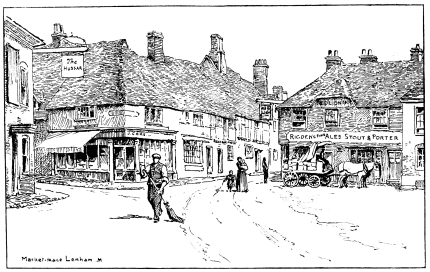
MARKET-PLACE, LENHAM.
Close to the church are the great tithe barns, built after the fire in
the fourteenth century by the Abbots of St. Augustine. The largest{166}
measures 157 feet long by 40 feet wide, and, saving the low stone walls,
is built entirely of oak from the forests of the Weald. The enormous
timbers are as sound and strong to-day as they were six hundred years
ago, and for solidity of material and beauty of construction, this
Kentish barn deserves to rank among the grandest architectural works of
the age. The monks are gone, and the proud Abbey itself has long been
laid in ruins, but these buildings give us some idea of the wealth and
resources of the great community who were the lords of Lenham during so
many centuries. They could afford to lend a kindly ear to the prayer of
the poor vicar when he humbly showed the poverty with which he had to
contend, and the load of the burden that he had to bear. The Abbot, we
are glad to learn, granted his request, and agreed to give him a roof
over his head and to allow his two cows to feed with the monks’ own
herds in the pastures at Lenham, during the months between the feast of
St. Philip and St. James and Michaelmas.{167}

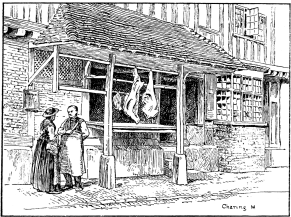
IN CHARING VILLAGE.
CHAPTER XI
CHARING TO GODMERSHAM
FROM Lenham the Pilgrims’ Road threads its lonely way along the
hill-side, past one or two decayed farmhouses still bearing the name of
the great families who once owned these manors—the Selves and the
Cobhams; and the view over the level country grows wider, and extends
farther to the south and east, until we reach{168} Charing Hill, one of the
highest points along this range of downs. The windmill, a few hundred
yards above the track, commands a far-spreading view over the valley,
stretching from the foot of the ridge to the Quarry Hills, where the
towers of Egerton Church stand out on its steep mound above the hazy
plains of the Weald. We look down upon Calehill, the home of the Darells
for the last five centuries, and across the woods and park of Surrenden
Dering, which has been held by the Dering family ever since the days of
Earl Godwin, to the churches and villages of the Weald. Beyond a
foreground of swelling hill and dale we see the flat expanse of Romney
Marsh and Dungeness; and then for the first time we catch a glimpse of a
pale blue line of sea—that sea across which Roman and Saxon and Norman
all sailed in turn to land upon the Kentish shore. On clear days you can
see the Sussex downs in the far horizon beyond the Weald, and near
Hastings, the hill of Fairlight rising sharply from the sea. Down in the
valley below, the tall tower of Charing Church lifts its head out of a
confused mass of red roofs{169} and green trees, with the ivy-grown ruins of
the old palace at its feet.
Many are the venerable traditions attached to the churches and villages
which we have seen along our road through this pleasant land of Kent,
but here is one older and more illustrious than them all. Here we have a
record which goes back far beyond the days of Lanfranc and of Athelstan,
and even that king of Mercia who gave Lenham to the Abbey of St.
Augustine. For Charing, if not actually given, as the old legend says,
by Vortigern to the ancient British Church, was at all events among the
first lands bestowed on Augustine and his companions by Ethelbert, king
of Kent. Saxon historians tell us how that this most ancient possession
of the church of Canterbury was seized by Offa, king of Mercia, in 757,
but restored again by his successor, Cenulph, in the year 788.

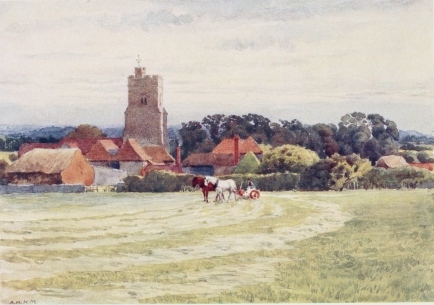
CHARING
Long before the Conqueror’s time, the Archbishops had a house here. In
Domesday Book, Charing is styled “proprium manorium archiepiscopi,”
being reserved by those prelates for their private use, and from those
days until{170} the manor was surrendered by Cranmer to Henry VIII. it
remained a favourite residence of the Archbishops. In the thirteenth
century the Franciscan Archbishop John Peckham dates many letters from
his house at Charing, and Stratford, as Dean Hook tells us, was often
there, and found consolation in this quiet retreat for the troubles of
those stormy days. Chichele, Kemp, and Bourchier were also frequently
here. Stratford first obtained the grant of a three days’ fair to be
held at Charing twice a year, on the festivals of St. George and St.
Luke. Leland tells us that Cardinal Morton made great buildings at
Charing, and the red and black brickwork still to be seen under the ivy
of the farmhouse walls may be ascribed to him, but the great gateway
with the chamber and hooded fireplace above, belongs to an earlier
period, and was probably the work of Stratford in the fourteenth
century. Some of the older stonework is to be found in the stables and
cottages now occupying the site of the offices on the west of the court.
The chapel, with its pointed arches and large windows, which in Hasted’s
time stood behind{171} the modern dwelling-house, was taken down eighty
years ago, but the great dining-hall, with its massive walls and fine
decorated window, still remains standing. This hall, where archbishops
sat in state, and kingly guests were feasted; where Henry VII. was
royally entertained by Archbishop Warham, on the 24th of March, 1507,
and where Henry VIII. stayed with all his train on his way to the Field
of Cloth of Gold, is now used as a barn. But in its decay, it must be
owned, the old palace is singularly picturesque. The wallflowers grow in
golden clusters high up the roofless gables and along the arches of the
central gateway; masses of apple-blossom hang over the grey stone walls,
and ring-necked doves bask in the sunshine on the richly coloured tiles
of the old banqueting-hall.
Close by is the church of Charing, famous in the eyes of mediæval
pilgrims for the possession of one hallowed relic, the block on which
St. John the Baptist was beheaded, brought back, an old tradition says,
by Richard Cœur de Lion from the Holy Land, and given by him to
Archbishop{172} Baldwin, when the King paid his devotions at the shrine of
St. Thomas. This precious relic went the way of all relics in the
sixteenth century, and is not mentioned in the long list of costly
vestments and frontals recorded in an inventory of Church property taken
at Charing in 1552. But Charing Church is still, in the words of the old
chronicler, “a goodly pile.” It is cruciform in shape, and contains some
traces of Early English work, but it is mostly of later date. The
windows are interesting on account of their great variety. There are
three narrow lancets, several of Transitional and Perpendicular style,
and one large and very remarkable square-headed Decorated window. The
chapel of Our Lady, on the south side of the chancel, was built, towards
the close of the fifteenth century, by Amy Brent, whose family owned the
charming old manor-house of Wickens in this parish. The porch and fine
tower, which forms so marked a feature in the landscape, was also
chiefly built by the Brents, whose crest, a wyvern, is carved on the
doorway, together with a rose encircled with sun-rays, the badge{173} of
Edward IV., in whose reign the work was completed. Through this handsome
doorway the Archbishop, attended by his cross-bearers and chaplains,
would enter from the palace-gate hard by, and many must have been the
stately processions which passed under the western arch and wound up the
long nave in the days of Morton and of Warham. A hundred years later
Charing Church narrowly escaped entire destruction. On the 4th of
August, 1590, a farmer, one Mr. Dios, discharged a birding-piece at a
pigeon roosting, as the pigeons do to this day, in the church tower, and
“the day being extreme hot and the shingle very dry,” a fire broke out
in the night, and by morning nothing was left but the bare walls of the
church, even the bells being melted by the heat of the fire. Happily the
parishioners applied themselves with patriotic zeal to the restoration,
and within two years the fine timber roof of the nave was completed. The
date 1592, E.R. 34, is inscribed on the rafter above the chancel arch,
while that of the chancel roof Ann. Dom. 1622, Anno Regni Jacobi xviii.,
appears on the beam immediately over the altar.{174}
The Pilgrims’ Way winds on through Charing past the noble church tower
and the ancient palace wall, with its thick clusters of ivy and trailing
wreaths of travellers’ joy, through the lovely woods of Pett Place, the
home of Honywoods and Sayers for some hundreds of years. The track
crosses the long avenue of stately limes which leads up to its gates,
and through the meeting boughs we see the red gables and tall chimneys
of the old Tudor house. In the fourteenth century the owners of Pett had
a chapel of their own, served by a priest whose name appears in the
Lambeth Register and other records as holding the living of
Pette-juxta-Charing; and Geoffery de Newcourt, who owned this manor,
together with the adjoining one of Newcourt, paid the king an aid on his
lands of Pett, when the Black Prince was knighted. A pleasant part of
the track this is dear to botanists for the wealth of ferns, flowers,
and rare orchises which grow along the shady path; pleasant alike in
May, when cowslips and violets grow thick in the grass and the
nightingales are in full song, and in June, when the ripe red fruit of
the{175} wild strawberries peep out from under the moss and the hawthorns
are in bloom, but perhaps best of all in autumn, when the beeches are
crimson and the maples in the hedges are one fire of gold.
For the next three miles, the way lies through the lower part of the
great woods of Long Beech, which stretch all over these hills, and which
from very early times belonged to the see of Canterbury. It brings us
out at Westwell, close to another extremely interesting church, dating
from the middle of the thirteenth century, and almost entirely of one
period. The graceful steeple, nave, chancel, and aisles, are all Early
English, but the most striking feature is the high open colonnade which
forms the rood-screen. The effect of the chancel, with its side arcade,
its groined roof, and beautiful lancet window filled with
richly-coloured old glass, seen through these three lofty arches, is
very imposing. There is another curious fragment of stained glass,
bearing the arms of Queen Anne of Bohemia and of Edward the Confessor
and his wife, in the north aisle, and the chancel contains six stone
walls{176} and a stone seat with a pointed arch, which were formerly used by
the monks and prior of Christ Church, Canterbury. For the manor of
Westwell, like so many others in this neighbourhood, belonged to the see
of Canterbury before the Conquest, and at the division of property
effected by Lanfranc was retained by the Priory. Its revenues were
allotted to the supply of the monks’ refectory, ad cibum eorum, just
as the tithes of Lenham were used to provide meals for St. Augustine’s
Abbey.

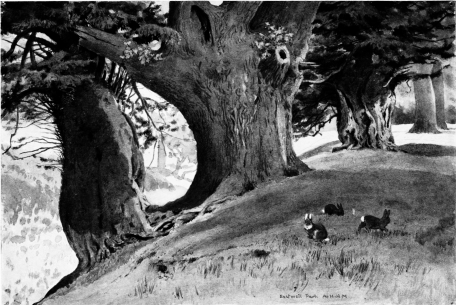
OLD YEWS AND OAK IN EASTWELL PARK.
Half a mile above Westwell Church the Pilgrims’ Way reaches the gates of
Eastwell. Here the track disappears for a time, but old maps show the
line which it took across the southern slopes of the park, which extends
for many miles, and is famous for the wild beauty of its scenery. The
hills we have followed so long run through the upper part of the park,
and magnificent are the views of the sea and Sussex downs which meet us
in these forest glades, where stately avenues of beech and oak and
chestnut throw long shadows over the grass, and antlered deer start up
from the bracken at{177} our feet. But the lower slopes are pleasant too,
with the venerable yews and thorns and hornbeams dotted over the
hill-side, and the heights above clad with a wealth of mingled foliage
which is reflected in the bright waters of the still, clear lake. The
old ivy-grown church stands close to the water’s edge, and contains some
fine tombs of the Earls of Winchelsea, and of their ancestors, the
Finches. But the traveller will look with more interest on the
sepulchral arch which is said to cover the ashes of the last of the
Plantagenets. The burial registers indeed record that Richard
Plantagenet, the illegitimate son of Richard III., died at Eastwell on
the 22nd of December, 1550, and a well, which goes by the name of
Plantagenet’s Well, marks the site of the cottage where he lived in
confinement after the defeat of his father on Bosworth Field. Eastwell
House, for some years the residence of H.R.H. the Duke of Edinburgh, was
originally built by Sir Thomas Moyle, Speaker of the House of Commons in
the reign of Henry VIII., but has been completely altered and modernised
since it passed into the Winchelsea family. Leaving it on our left, we{178}
come out of the Park at Boughton Lees, a group of houses on a
three-cornered green, and follow in the steps of the old track to
Boughton Aluph church, a large cruciform building with a spacious north
aisle and massive central tower, standing in a very lonely situation.
Boughton, called Bocton or Boltune in former times, belonged to Earl
Godwin and his son Harold, before the Conquest, after which it was given
to Eustace, Earl of Boulogne, and formed part of Juliana de Leybourne’s
vast inheritance. It took the name of Aluph from a Norman knight,
Aluphus de Bocton, who held the manor in the reign of King John, and
became thus distinguished from the other parishes of Boughton in the
neighbourhood. From the church a grassy lane, shaded by trees, ascends
the hill to Challock on the borders of Eastwell Park, and is probably
the old track of the Pilgrims’ Way which passed between these woods and
the park of Godmersham. This was formerly the property of Jane Austen’s
brother, who took the name of Knight on succeeding to the estate, but it
has now passed into the hands of another family.{179} Until the Dissolution
the manor and church of Godmersham belonged to Christ Church, and here,
in mediæval days, the priors of the convent had a fine manor-house,
where they frequently resided during the summer months. The hall was
pulled down in 1810, and nothing of the old house is now left except a
gable and doorway, adorned with a figure of a Prior wearing his mitre
and holding his crozier in his hand, probably intended for Henry de
Estria, the Prior who rebuilt the manor-house in 1290. The church of
Godmersham is remarkable for its early tower and curious semicircular
apse with small Norman lights, which are evidently remains of an older
building, and in the churchyard are some very ancient yews, one of which
is said to have been planted before the Conquest.
Under the shadow of these venerable trees there sleeps a remarkable
woman, Mary Sybilla Holland, whose father was at one time Vicar of
Godmersham, and afterwards moved to Harbledown, a larger parish near
Canterbury, a few miles further along the Pilgrims’ Way. Both Mrs.{180}
Holland and her distinguished brother, the lamented Sir Alfred Lyall,
retained a lifelong affection for this corner of East Kent. When Lyall
was far away in India, ruling over millions of British subjects, in the
north-west provinces, his verses tell us how passionately he yearned for
his old Kentish home.
“Ah! that hamlet in Saxon Kent,
Shall I find it when I come home?
With toil and travelling well-nigh spent,
Tired with life in jungle and tent,
Eastward never again to roam.
Pleasantest corner the world can show
In a vale which slopes to the English sea—
Where strawberries wild in the woodland grow,
And the cherry-tree branches are bending low,
No such fruit in the South countree.”
Sir Alfred died on the 10th of April, 1911, at Lord Tennyson’s house at
Farringford, in the Isle of Wight, and was buried in the churchyard of
St. Michael’s, Harbledown. Now brother and sister are both sleeping
under the grassy sod of the Kentish land which they loved so well,
“where the nightingales sing{181} heart-piercing notes in the silence of the
early summer night.”
“Shelter for me and for you, my friend,
There let us settle when both are old,
And whenever I come to my journey’s end,
There you shall see me laid, and blend
Just one tear with the falling mould.”

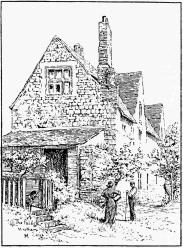
THE PLACE, WROTHAM.
{182}

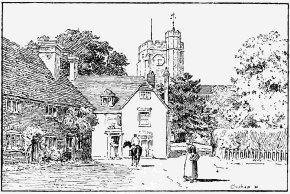
CHILHAM.
CHAPTER XII
CHILHAM TO HARBLEDOWN
THE Pilgrims’ Way skirted the wooded slopes of Godmersham Park for about
a mile, and then entered Chilham Park. The park is now closed, but the
old track lay right across the park, and in front of Chilham Castle. The
position of this fortress, overlooking the valley of the Stour, has made
it memorable in English history. Chilham has been in turn a Roman camp,
a Saxon castle, and a Norman keep, and has played an eventful{183} part in
some of the fiercest struggles of those days. According to a generally
received tradition recorded by Camden, Chilham was the scene of the
battle on the river in Cæsar’s second expedition; and the British barrow
near the Stour, popularly known as Julaber’s Grave, was believed to be
the tomb of the Roman tribune, Julius Laberius, although, as a matter of
fact, it contains no sepulchral remains. In the second century Chilham
is said to have been the home of that traditional personage, the
Christian King Lucius, and in Saxon days of the chief Cilla. The castle
was strongly fortified to resist the invasion of the Danes, by whom it
was repeatedly attacked. After the Norman Conquest it belonged to
Fulbert de Dover, whose last descendant, Isabel, Countess of Atholl,
died here in 1292, and is buried in the under-croft at Canterbury. Then
it passed into the hands of the great Lord Badlesmere, of Leeds, who on
one occasion gave Queen Isabel, the wife of Edward II., a splendid
reception here, and afterwards astonished the peaceful citizens and
monks of Canterbury by appearing at their gates, followed by nineteen
armed knights, each with a{184} drawn sword in his hand, to pay his
devotions at the shrine of St. Thomas. As late as the sixteenth century
Leland describes Chilham Castle as beautiful for pleasure, commodious
for use, and strong for defence; but soon after he wrote these words,
the greater part of the old house was pulled down by its owner, Sir
Thomas Cheney, Warden of the Cinque Ports under Edward VI., to complete
his new mansion in the Isle of Sheppey. The Norman keep, an octagonal
fortress three stories high, is the only part of the mediæval structure
that now remains, and can still be seen in the gardens of the new house
built in 1616 by Sir Dudley Digges, Master of the Rolls in the reign of
James I. This fine Jacobean manor-house stands well on the rising ground
above the river, and both the garden terrace and the top of the old keep
afford beautiful views of the vale of Ashford and the downs beyond the
Wye. Still more picturesque is the market-place of Chilham itself. On
one side we have the red brick walls and white stone doorway of the
castle, seen at the end of its short avenue of tall lime trees on the
other the quaint red roofs and timbered houses{185} of the charming old
square, with the grey church tower surrounded by the brilliant green of
sycamores and beeches. On a bright spring morning, when the leaves are
young and the meadows along the river-side are golden with buttercups,
there can be no prettier picture than this of the old market square of
Cilla’s home.
From the heights of Chilham the Pilgrims’ Way descends into the valley
of the Stour, and after following the course of the river for a short
time, climbs the opposite hill and strikes into Bigberry Wood. Here we
come suddenly upon the most ancient earthwork along the whole line of
the road, an entrenchment which Professor Boyd Dawkins, who explored it
thoroughly some years ago, has ascribed to the prehistoric Iron Age. For
most of us, perhaps, Bigberry Camp has a still greater interest as the
fort which the Britons held against the assault of the Roman invaders,
and which was stormed and carried by Cæsar’s legions. The memory of that
desperate fight, which sealed the fate of Britain and her conquest by
the great Proconsul, still lingers in the popular mind, and the shepherd
who follows his flock and{186} the waggoner who drives his team along the
road, still talk of the famous battle that was fought here two thousand
years ago.
After this the path crosses the valley and runs through the hop-gardens
to join Watling Street—the road by which Chaucer’s pilgrims came to
Canterbury—at Harbledown. This is the little village on the edge of the
forest of Blean, which has been immortalised by Chaucer’s lines—
“Wist ye not where standeth a little toun
Which that ycleped is Bob-up-and-down,
Under the Blee in Canterbury way.”

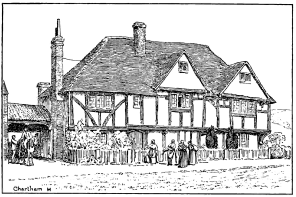
ON THE VILLAGE GREEN, CHARTHAM
And Bob-up-and-down is to this day a true and characteristic description
of the rolling ground by which we approach Harbledown. Here the
Pilgrims’ Road, along which we have journeyed over hill and dale, fails
to rise again. We climb the last hill, and on the summit of the rising
ground we find ourselves close to the lazar-house founded at Harbledown
by Lanfranc in 1084. The wooden houses built by the Norman Archbishop
for the reception of ten brothers and seven sisters have been replaced
by a row of modern{187} almshouses; but the chapel still preserves its old
Norman doorway, and the round arches and pillars of an arcade to the
north of the nave, which formed part of the hospital church dedicated by
Lanfranc to St. Nicholas. The devout pilgrim to St. Thomas’s shrine
never failed to visit this ancient leper-house. Not only did the
antiquity of the charitable foundation and its nearness to the road
attract him, but in the common hall of the hospital a precious relic was
preserved in the shape of a crystal which had once adorned{188} the leather
of St. Thomas’s shoe. Many were the royal personages and distinguished
strangers who paused before these old walls and dropped their alms into
the poor leper’s outstretched hand. Here, we read in contemporary
records, Henry II. came on his first memorable pilgrimage to the tomb of
the martyred Archbishop, and Richard Cœur de Lion after his release
from his long captivity. Edward I. stopped at Harbledown with his brave
Queen, Eleanor of Castille, on their return from the Holy Land, and the
Black Prince, accompanied by his royal captive, King John of France, and
that monarch’s young son Philip, also visited the leper-house. And when
the French king visited Canterbury for the second time, on his return to
his own kingdom, he did not forget to stop at Lanfranc’s old lazar-house
and leave ten gold crowns “pour les nonnains de Harbledoun.” But it is a
later and more sceptical traveller, Erasmus, who has left us the most
vivid description of Harbledown and of the feelings which the sight of
the relic aroused in the heart of his companion, Dean Colet. “Not far
from Canterbury, at the left-hand side of the road,”{189} he writes, in the
record of his pilgrimage, “there is a small almshouse for old people,
one of whom ran out, seeming to hear the steps of the horses. He first
sprinkled us with holy water, and then offered us the upper leather of a
shoe bound in a brass rim, with a crystal set in its centre like a
jewel. Gration (Dean Colet) rode on my left hand, nearer to the beggar
man, and was duly sprinkled, bearing it with a tolerable amount of
equanimity. But when the shoe was handed up, he asked the old man what
he wanted. ‘It is the shoe of St. Thomas,’ was the answer. Upon this he
fired up, and turning to me, exclaimed indignantly, ‘What! do these
cattle mean we should kiss the shoes of every good man?’” Erasmus, sorry
for the old man’s feelings, dropped a small coin into his hand, which
made him quite happy, and the two pilgrims rode on to London, discussing
the question of the worship of relics as they went. To this day a maple
bowl, bound with a brass rim, containing a piece of crystal, is
preserved in the hospital at Harbledown, the self-same relic, it may be,
which was shown to Erasmus and Colet, and{190} which Lambarde, writing half
a century later, describes as “faire set in copper and chrystall”; while
an old wooden box, with a slit in the lid for money, and a chain
attached to it, is said to be the one into which Erasmus dropped his
coin.
Behind the ivy-mantled tower of Lanfranc’s chapel is a clear spring
which was supposed to possess healing virtues, and is still believed by
the country folks to be of great benefit to the eyes. This spring still
goes by the name of the Black Prince’s Well, from an old tradition that
the warrior of Crecy and Poitiers drank of its waters when he visited
the hospital at Harbledown in 1357. Many, we know, are the memorials of
this popular hero at Canterbury. Only three days after he landed at
Sandwich he came, accompanied by his royal captive, to return thanks at
St. Thomas’s shrine for his victories, and six years afterwards he
founded and decorated the beautiful chantry in the Cathedral crypt,
which still bears his name, on the occasion of his marriage with his
cousin Joan, the Fair Maid of Kent. The old legend of the Black
Prince’s{191} Well goes on to tell how, when he lay dying of the wasting
disease which carried him off in the flower of his life, he thought of
the wonder-working spring near Canterbury, and sent to Harbledown for a
draught of its pure waters. But even that could not save him, and on the
29th of September, 1376, a stately funeral procession wound its way down
the hill-side at Harbledown, bearing the Black Prince to the grave which
he had chosen for himself in the Chapel of Our Lady of the Undercroft at
Canterbury.
At Harbledown the pilgrims caught their first sight of the Cathedral;
here they fell on their knees when they saw the golden angel on the top
of the central tower, and knew that the goal of their pilgrimage was
almost reached. Here Chaucer’s goodly company made their last halt, and
for the moment the noise of singing and piping and jingling of bells
gave place to a graver and more solemn mood as the motley crowd of
pilgrims pressed around, to hear this time not a Canterbury tale, but a
sermon. Deep was the impression which that first sight of{192} Canterbury
made upon Erasmus. The cold, critical scholar becomes eloquent as he
describes the great church of St. Thomas rearing itself up into the sky
with a majesty that strikes awe into every heart, and the clanging of
bells which, thrilling through the air, salute the pilgrims from afar.
To-day the great cross is gone from the Westgate, the shining archangel
no longer blesses the kneeling pilgrim from the topmost steeple, but the
same glorious vision of the great Cathedral rising with all its towers
into the sky meets the eyes of the traveller who looks down on
Canterbury from the hill of Harbledown.{193}

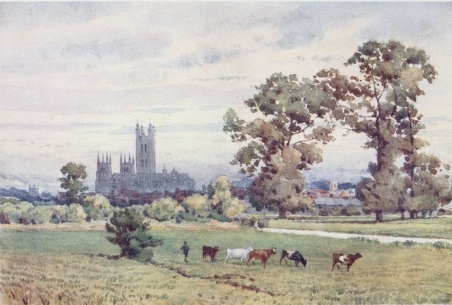
CANTERBURY CATHEDRAL FROM THE SOUTH-WEST

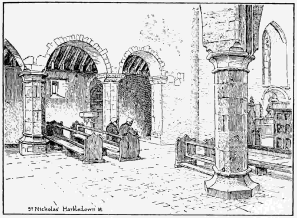
ST. NICHOLAS’, HARBLEDOWN.
CHAPTER XIII
HARBLEDOWN TO CANTERBURY
FROM Harbledown it is all downhill to Canterbury, and a short mile
brings us to the massive round tower of Simon of Sudbury’s noble
Westgate, the only one remaining of the seven fortified gateways which
once guarded the ancient city. Many are the pilgrims who have entered
Canterbury by this gate: kings and queens of all ages, foreign emperors
and princes, armed knights{194} and humble scholars, good Queen Philippa and
Edward Plantagenet, Henry of Agincourt, Margaret of Anjou, Chaucer and
Erasmus. Many, too, are the long processions which have wound down this
hill-side: newly created archbishops followed by a brilliant train of
bishops and courtiers on their way to be enthroned in the chair of St.
Augustine; solemn funerals, attended with all the pomp and circumstance,
the funeral plumes and sable trappings, with which men honour the mighty
dead. Through the Westgate went forth that gay company of monks and
friars, of merchants and citizens crowned with garlands of flowers, and
making joyous minstrelsy, as they rode out to welcome Archbishop
Winchelsea, who, once a poor student in the school at Canterbury, now
came to be enthroned in state in the presence of King Edward I. and all
his court. And this way, too, they bore him with much state and pomp,
eighteen years later, from the manor-house at Otford, where he died, to
sleep in his own Cathedral after all the labours and struggles, the
storms and changes of his troublous reign.{195}

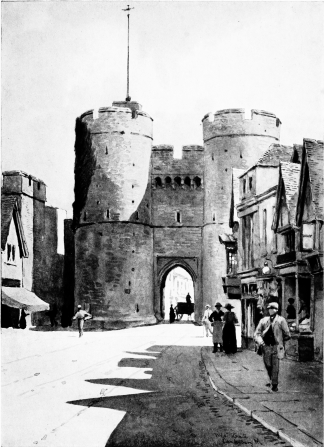
THE WEST GATE, CANTERBURY.
Since these mediæval days Canterbury has seen many changes. The
splendours of which Camden and Leland wrote have passed away, the
countless number of its churches has been reduced, and their
magnificence no longer strikes the eye of the stranger. The lofty walls
and their twenty-one watch-towers, which encircled the city in a
complete ring when Chaucer’s knight, after paying his devotion at the
shrine of St. Thomas, went out to see their strength, and “pointed to
his son both the perill and the doubt,” are all gone, and the
Conqueror’s mighty castle is turned into a coal-pit. But the old city is
still full of quaint corners and picturesque buildings, timbered houses
with carved corbels and oriel windows, hostelries with overhanging eaves
and fantastic sign-boards of wrought-iron work, hospitals whose charters
date from Norman times, and whose records give us many a curious peep
into the byways of mediæval life.
As we draw near the Martyr’s shrine, memories of St. Thomas crowd upon
us. The hill outside the Westgate, now occupied by the Clergy Orphan
School, is still called St. Thomas’s Hill, and was{196} formerly the site of
a chapel founded by Becket himself. A little way up the High Street we
reach a bridge over the Stour, which winds its way through the heart of
the city, and a low pointed doorway on our right leads into St. Thomas’s
Hospital. This ancient Spittle of East Bridge was founded, as a
fourteenth-century charter records, by the “glorious St. Thomas the
Martyr, to receive poor wayfaring men.” Archbishop Hubert Walter
increased its endowments in the twelfth century, and Stratford repaired
the walls in the fourteenth, and drew up statutes for its government.
From that time it was especially devoted to the use of poor pilgrims,
for whom twelve beds were provided, and whose wants were supplied at the
rate of fourpence a day. During those days, when the enthusiasm for St.
Thomas was at its height, alms and legacies were lavished upon
Eastbridge Hospital, and Edward III. bequeathed money to support a
chaplain, whose duty it was to say daily masses for the founders of the
hospital. After the days of pilgrimages were over, this hospital was
applied to various uses until Archbishop Whitgift recovered{197} the
property and drew up fresh statutes for its management. Ten poor
brothers and sisters still enjoy the fruit of St. Thomas’s benevolence,
and dwell in the old house built on arches across the bed of the river.
The low level of the floor, which has sunk far below that of the street,
and the vaulted roof and time-worn pillars, bear witness to its great
antiquity. There can be little doubt that the round arches of the Norman
crypt belong to St. Thomas’s original foundation, while the pointed
windows of the chapel and Early English arches of the refectory form
part of Archbishop Stratford’s improvements. In this hall some portions
of frescoes, representing on the one hand the Last Supper, on the other
the Martyrdom of the Saint, the penance of Henry II. at his tomb, with
the central figure of Christ in Glory, have been lately recovered from
under the coat of whitewash which had concealed them for more than two
centuries.
Twice a year, we know, at the summer festival of the Translation of St.
Thomas, on the 7th of July, and at the winter festival of the Martyrdom,
on the 29th of December, Canterbury was crowded{198} with pilgrims, and a
notice was placed in the High Street ordering the due provision of beds
and entertainment for strangers. The concourse was still greater on the
jubilees of the Translation, when indulgences were showered freely on
all who visited the shrine, and the festival lasted for a whole
fortnight. At the jubilee of the year 1420, just after the victory of
Agincourt, no less than a hundred thousand pilgrims are said to have
been present. On such occasions every available corner was occupied; the
inns, which were exceedingly numerous, the hospitals, and, above all,
the religious houses, were thronged with strangers. The most favourite,
the most renowned, of all the hostelries was the Chequers of the Hope,
the inn where Chaucer’s twenty-nine pilgrims took up their quarters.
“At Chekers of the Hope that every man doth know.”
This ancient inn, which Prior Chillenden rebuilt about 1400, stood at
the corner of High Street and Mercery Lane, the old Merceria, which was
formerly lined with rows of booths and stalls for the sale of pilgrimage
tokens, such as are to be{199} found in the neighbourhood of all famous
shrines. Both ampullas, small leaden bottles containing a drop of the
martyr’s blood, which flowed perennially from a well in the precincts,
and Caput Thomæ, or brooches bearing the saint’s mitred head, were
eagerly sought after by all Canterbury pilgrims. So too were the small
metal bells which are said to have given their name to the favourite
Kentish flower, the Canterbury bell. And we read that the French king,
John, stopped at the Mercery stalls to buy a knife for the Count of
Auxerre. The position of the inn close to the great gate of Christ
Church naturally attracted many visitors, and the spacious cellars with
vaulted roofs, which once belonged to the inn, may still be seen,
although the inner courtyard and the great chamber upstairs occupied by
the pilgrims, and known as the Dormitory of Hundred Beds, were burnt
down forty years ago. But the old street front, with its broad eaves
overhanging the narrow lane leading up to the great gateway at the other
end, still remains, and renders Mercery Lane the most picturesque and
interesting corner of the Cathedral city.{200}
The religious houses were open to all comers, and while royal visitors
were lodged in St. Augustine’s Abbey, the convents of the Mendicant
orders were largely frequented by the poorer classes. There was also the
house of the Whitefriars or Augustinians in the eastern part of the
town, close to St. George’s Gate, and the hospital of St. John in the
populous Northgate, “that faire and large house of stone,” built and
endowed by Lanfranc in the eleventh century, besides that of Eastbridge,
which has been already mentioned, and many other smaller foundations.
But it was in the great Priory of Christ Church that by far the largest
number of pilgrims found hospitable welcome. A considerable part of the
convent buildings was set aside for their reception. The Prior himself
entertained distinguished strangers, and lodged them in the splendid
suite of rooms overlooking the convent garden, known as the Omers or
Homers—Les Ormeaux—from a neighbouring grove of elms. This range of
buildings, including the banqueting-hall, generally known as “Meister
Omers,” was broken up into prebendal houses after the Dissolution,{201} and
supplied three separate residences for members of the new Chapter, which
gives us some idea of the size of these lodgings. For ordinary strangers
there was the Guest Hall, near the kitchen, on the west side of the
Prior’s Court, which was under the especial charge of a cellarer
appointed to provide for the needs of the guests. Prior Chillenden, whom
Leland describes as “the greatest builder of a Prior that ever was in
Christ Church,” repaired and enlarged this Strangers’ Hall early in the
fifteenth century, and added a new chamber for hospitality, which bore
the name of Chillenden’s Guest Chamber, and now forms part of the Bishop
of Dover’s house. Finally, without the convent precincts, close to the
court gateway, where the beautiful Norman stairway leads up to the Great
Hall, or Aula Nova, was the Almonry. Here the statutes of Archbishop
Winchelsea—he who had known what it was to hunger and thirst in his
boyhood, and who remained all through his greatness the friend of the
poor—provided that poor pilgrims and beggars should be fed daily with
the fragments of bread and meat, “which were many and great,” left on{202}
the monks’ tables, and brought here by the wooden pentise or covered
passage leading from the kitchen. This Almonry became richly endowed by
wealthy pilgrims in course of years, and early in the fourteenth century
Prior Henry of Estria built a chapel close by, which was dedicated to
St. Thomas the Martyr, and much frequented by pilgrims. The Almony was
turned into a mint-yard at the Dissolution, and the chapel and priests’
lodgings attached to it, now belong to the King’s School. Another
privilege freely conceded by the prior and monks of this great community
to pilgrims of all ranks and nationality who might die at Canterbury,
was that of burial within the precincts of Christ Church, close to the
blessed martyr’s shrine, and under the shadow of the Cathedral walls.{203}

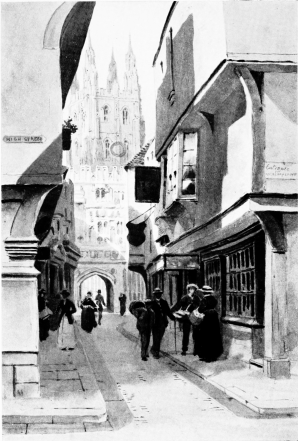
MERCERY LANE, CANTERBURY.
CHAPTER XIV
THE MARTYR’S SHRINE
ERASMUS has described the imposing effect of the great Cathedral church
on the stranger who entered its doors for the first time, and saw the
nave “in all its spacious majesty.” The vision which broke upon the eyes
of those pilgrims who, like himself and Dean Colet, visited Canterbury
in the early years of the sixteenth century, may well have filled all
hearts with wonder. For then the work was well-nigh perfected. The long
roll of master-builders, from Prior Wibert and De Estria to Chillenden
and Sellyng, had faithfully accomplished their task. Prior Goldstone,
the last but one who reigned before the Dissolution, had just completed
the central tower, the great labour of his predecessor Prior Sellyng’s
life, and was in the act of building the noble Perpendicular{204} gateway
which forms a fitting entrance to the precincts.
And now the great church stood complete. Without, “a very goodly,
strong, and beautiful structure”: the traceries and mouldings of the
windows, the stone canopies and sculptured images of the portal, all
perfect; the glorious towers in their might; Bell Harry Steeple, as we
see it to-day, matchless in its strength and beauty; and beside it,
rivalling its grace and majesty, the ancient Norman tower, which bore
the name of Ethelbert, crowned with the Arundel spire. Within, a
richness and splendour to which our eyes are wholly unaccustomed:
chapels and chantries lining the great nave, fresh from Prior
Chillenden’s work; altars glittering with lighted tapers and gold and
silver ornaments; roof and walls bright with painting and gilding, or
decked with silken tapestry hangings; carved images covered with pearls
and gems; stained windows throwing their hues of ruby and sapphire
across the floor, and lighting up the clouds of incense as they rose
heavenward. All this, and much more, met the pilgrims’ wondering eyes.
No{205} wonder they stood “half amazed,” as the Supplementary Tale to
Chaucer’s Pilgrimage describes “the gardener and the miller and the
other lewd sets,” gazing up at the painted windows, and forgetting to
move on with the crowd.

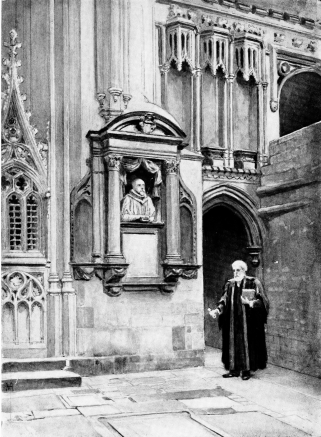
THE MARTYRDOM, CANTERBURY CATHEDRAL.
Then the show began. First of all the pilgrims were led up a vaulted
passage and “many steps” to the Transept of the Martyrdom, where the
wooden altar, at the foot of which the saint fell, remained to show the
actual place of the murder, and its guardian priest—the Custos
Martyrum—displayed the rusty sword of Richard le Breton. Next,
descending the flight of steps on the right, they were led into the dark
crypt, where more priests received them, and presented the saint’s
skull, encased in silver, to be kissed, and other relics, including the
famous girdle and hair-shirt. This Caput Thomæ was one of the chief
stations at which offerings were made, and the altar on which it lay,
mentioned in the Black Prince’s will as “the altar where the head is,”
marked the site of the original grave where the saint was buried by the
frightened monks on the day after the murder. The tomb stood in the{206}
eastern chapel of Ernulf’s crypt, under the beautiful Pointed arches
afterwards raised by that great architect, William the Englishman, whom
Gervase describes as “small in body, but in workmanship skilled and
honest.” Soon it acquired a miraculous virtue, and the fame of the cures
and wonders wrought there rang throughout the world. It was the scene of
Henry II.’s penance, and during the next fifty years it remained the
central object of interest to the crowds of pilgrims who came from all
parts of Christendom. Cœur de Lion, accompanied by William, King of
Scotland, knelt here on his way to the Crusades, to implore the martyr’s
blessing on his arms. Many were the Crusaders from all parts of France
and England who came thither on the same errand. King John and his wife
Isabella, who were crowned at Canterbury Cathedral by Archbishop Hubert
Walter, at Easter, 1201, offered their coronation canopies at this tomb
and vast sums of money were yearly offered here until 1220, when the
body of St. Thomas was translated, in the presence of the young King
Henry III., to the new Shrine in Trinity Chapel, immediately{207} above the
tomb in the crypt. In that year the offerings at the tomb, at the Altar
of the Sword’s Point, and at the new Shrine, reached the enormous amount
of £1,071, a sum equal to more than £20,000 of money at the present
time. After this, the offerings at the original tomb in the crypt
diminished in number and value, but the altar and relics of the Caput
Thomæ remained an object of deep reverence until the Reformation.
From the dark vaults of the subterranean church the pilgrims were led up
the steps to the north aisle of the choir. Here the great mass of
relics, including St. George’s arm and no less than four hundred skulls,
jaws, teeth, hands, and other bones, were displayed in gold, silver, or
ivory caskets, and pilgrims were allowed a glimpse of the magnificent
vessels and ornaments stored up under the high altar. “All the gold of
Midas and Crœsus,” exclaims Erasmus, “would have been nothing by the
side of these treasures!” and he confesses that he sighed to think he
kept no such relics at home, and had to beg the saint’s pardon for this
very unholy emotion. The golden {208}candlesticks and silken vestments of
the sacristy in St. Andrew’s tower, and the saint’s pallium, which no
ordinary pilgrims might see, were also shown to Erasmus and Colet, who
brought with them a letter of introduction from Archbishop Warham.
After duly inspecting these precious objects, they mounted the long
flight of steps behind the high altar leading into Trinity Chapel; a
continual ascent, “church, as it were, piled upon church,” which seems
to have greatly heightened the impression produced upon the awe-struck
pilgrims. Now at last they stood within the holiest of holies. There,
before their eyes, was the goal of all their journeyings, the object of
their deepest devotion, the Shrine which held the body of the blessed
martyr.

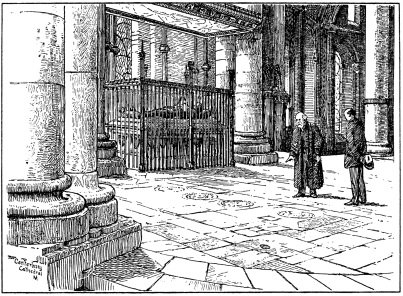
SITE OF THE SHRINE OF ST. THOMAS, CANTERBURY CATHEDRAL.
The Shrine itself, covered by a painted canopy of wood, rested on stone
arches in the centre of the floor, exactly under the gilded crescent
which is still to be seen in the Cathedral roof. On the right was the
richly carved and canopied monument of Henry IV. and his Queen, Joan of
Navarre, with its elaborate effigies of the royal{209} pair wearing their
crowns and robes of state; on the left the tomb of Edward the Black
Prince. He had willed to sleep before the altar of Our Lady of the
Under-croft, in the chapel adorned by his own gifts, but the people who
had loved him so well would not allow their hero to remain buried out of
sight in the dark crypt. So they brought him to rest by the great
saint’s Shrine, where all men could see his effigy of gilded bronze as
he lay there, clad in armour, his sword by his side, his hands clasped
in prayer, and read the pathetic lines which tell of his departed
glories, and bid the passing stranger pray for his soul:
“Pur Dieu, priez au Celestien Roy,
Que mercy ait de l’âme de moy.”
His was the first tomb that was ever raised in the sacred precincts
devoted to the martyr’s Shrine, and to this day it remains there, unhurt
by the hand of time or the more cruel violence of man.
Up the worn stone steps which still bear the marks left by thousands of
feet and knees, the pilgrims climbed, murmuring words of prayer{211} or
chanting the popular Latin hymns to St. Thomas:
“Tu, per Thomæ sanguinem,
Quem pro te impendit,
Fac nos, Christe, scandere
Quo Thomas ascendit.”
Here the Prior himself received them, and showed them first the corona
or crown of Becket’s head, preserved in a golden likeness of St.
Thomas’s face, ornamented with pearls and precious gems, which had been
presented by Henry V. Then, at a given sign, the wooden canopy was drawn
up by ropes, and the Shrine itself, embossed with gold and glittering
with countless jewels that flashed and sparkled with light, was revealed
to the eyes of the pilgrims. They all fell upon their knees and
worshipped, while the Prior with his white wand pointed out the
balass-rubies and diamonds, the sapphires and emeralds, which adorned
the Shrine, and told the names of the royal persons by whom these gifts
had been presented. There were rings and brooches and chains without
end, golden and silver statues offered by kings and queens, the crown of
Scotland{212} brought back by Edward I. after his victory over John Baliol,
and the regale of France, that superb ruby presented at the tomb in
the crypt by Louis VII., which shone like fire, and was as costly as a
king’s ransom. Full of awe and wonder the spectators gazed with admiring
eyes on these treasures, which for beauty and splendour were beyond all
they had ever dreamt, until the canopy slowly descended, and the Shrine
was once more hidden from their sight.
Then they went their way, some to visit the convent buildings, the noble
chapter-house with its gabled roof and stained windows, and the glazed
walk of the cloisters, glowing with bright colours and decorated with
heraldic devices of benefactors to Christ Church painted on the bosses
of the vaulting. Others made themselves fresh and gay, and went out to
see the city, the Knight and his son to look at the walls, the Prioress
and the Wife of Bath to walk in the herbary of the inn.
But for Erasmus and his rather inconvenient companion there was still a
sight in store, only reserved for very exalted personages, or{213} such as
had friends at court. Prior Goldstone, a gentle and well-bred man, not
altogether ignorant, as Erasmus found, of the Scotian theology, himself
took them back into the crypt, and lanterns were brought to illumine the
dark vaults. By their light the Prior led the way into the church of Our
Lady of the Undercroft, which was divided from the rest of the crypt by
strong iron railings. Here the two friends saw what Erasmus might well
call “a display of more than royal splendour.” For here, surrounded by
exquisitely carved stonework screens and a beautiful reredos with
delicate traceries and mouldings, richly coloured and gilt, was the
altar of Our Lady, adorned with precious ornaments and twinkling with
hundreds of silver lamps. There in the central niche, under a crocketed
and pinnacled canopy, stood the famous silver image of the Blessed
Virgin herself. And there was the jewelled tabernacle and frontal, with
its picture of the Assumption worked in gold, and the chalice and cruets
in the form of angels, and the great silver candelabra with which the
Black Prince had enriched his{214} favourite shrine. There too were the
costly gifts and jewels presented by his son, Richard II., the gold
brooches offered yearly by Edward I., the white silk vestments, diapered
with a vine pattern of blue, bequeathed by the Black Prince, and
countless other rare and precious things, which filled Erasmus with envy
and wonder. But then, as ill luck would have it, the Prior conducted his
guests into the sacristy, where on bended knees he opened a black
leathern chest, out of which he produced a parcel of ragged
handkerchiefs with which St. Thomas used to wipe his face. This was too
much for Dean Colet’s patience, already sorely tried as it had been by
what he had seen and heard. When the gentle Prior offered him one of the
filthy rags as a present, he shrank back in evident disgust, and turned
up his nose with an expression of contempt which filled Erasmus with
shame and terror. Fortunately the Prior was a man of sense and courtesy,
so he appeared to take no notice, and after giving his guests a cup of
wine, politely bade them farewell.
Before this Colet had alarmed his more timid{215} friend by the bold way in
which he had dared to question the priest who guarded the gilded head.
He had even gone so far as to remark aloud that the saint who was so
charitable in his lifetime, would surely be better pleased if some
trifling part of these riches were spent in relieving the poor and
destitute. Upon which the monk had glared at him with Gorgon eyes, and,
Erasmus felt sure, would have turned them out of the church forthwith,
had it not been for Archbishop Warham’s letter.
But in these words of the honest Dean we see a foreboding of the new and
critical spirit that was fast undermining the old beliefs. Already the
days of pilgrimages were numbered, and the glories of St. Thomas were on
the wane. A few more years and the monks who guarded his treasures were
rudely disturbed. The glorious Shrine was stripped of its priceless
gems. The wrought gold and precious jewels were borne away in two
enormous chests, such as six or seven men could barely lift. The
wonderful ruby which flashed fire in the darkness was set in a ring and
worn by King Harry himself on his{216} thumb. Finally, to complete the
sacrilege, the relics of the Saint were publicly burnt and his ashes
scattered to the winds. Only the broken pavement and the marks of the
pilgrims’ knees in the stone floor were left to show future generations
this spot, hallowed by the prayers and the worship of past ages.{217}
INDEX
A,
B,
C,
D,
E,
F,
G,
H,
I,
J,
K,
L,
M,
N,
O,
P,
Q,
R,
S,
T,
V,
W,
Y
Abbotsworthy, 34
Abbott, E., “St. Thomas of Canterbury,” 11 note
Abinger, 90;
discovery of Roman remains at, 99
Addington, cromlechs at, 146
Æthelred II., 153
Agincourt, battle of, 198
Albury, 18, 82;
yew hedge, 84;
church, 83;
Downs, 80;
view from, 80;
Park, 80, 87
Alexander III., Pope, 14
Alfred, King, 21, 72;
founds the Abbey of Hyde, 28
Alice Holt forest, 50
Allen, Mr. Grant, 5
Alresford, 35, 38;
New, cloth trade at, 39;
result of the Civil Wars, 40;
Old, 38
Alton, 28, 50
Anderida, forest of, 5
Apulderfelde, Thomas de, effigy of, 164
Aragon, Katherine of, portrait of, 131
Arle, ford of the, 38
Arundel, Thomas Howard, Earl of, 83;
collector of the Arundel marbles, 83;
portrait of, 83
Ash, 54
Ashburton, Lord, his famous Grange, 37{218}
Ashford, 127;
vale of, 184
Athelstan, 112, 134, 153, 169
Atholl, Isabel, Countess of, 183
Austen, Cassandra, 48
Austen, Jane, 46;
her cottage at Chawton, 48;
novels, 48;
mode of life, 48;
letters, 49
Avington Park, 36
Aylesford, 144;
Common, 146
Badlesmere, Lord, of Leeds, 183
Baldwin, Archbishop, 172
Baliol, John, 212
Becket, St. Thomas, Archbishop of Canterbury, his murder, 7-9;
championship for the rights of the Church, 9;
journey to Canterbury, 9;
miracles and cures wrought by, 10-12, 206;
canonisation, 14;
removal of his body, 15, 206;
shrine, 16, 208-212;
fame, 16;
his house at Otford, 129;
legends, 131;
relics, 205, 207
Beggars’ Corner, 58
Belloc, Hilaire, “The Old Road,” vii
Bentley Station, 52
Betchworth Park, 98
Bigberry Camp, 185;
wood, 185
Birinus, church of, 22
Birling, 142;
Place, 138{219}
Bishop Sutton, 43
Black Prince, at Harbledown, 188;
memorials of, 190;
death, 191;
tomb, 210
Black Prince’s Well, 190
Blackdown, 80
Blagge, Mistress, portrait of, 92
Blean, forest of, 186
Bletchingley, discovery of Roman remains at, 100
Blois, Henry of, 24, 52
Bocton, Aluphus de, 178
Bohemia, Queen Anne of, the arms of, 175
Boleyn, Anne, portrait of, 67
Boniface, Archbishop, 143
Boscawen, Mrs., her birthplace, 132
Botley Hill, 118
Botolph, St., church of, 122;
monuments, 122
Boughton Aluph church, 178
Boughton, Bocton or Boltune, 178
Boughton Lees, 178
Boughton Malherbe, 154
Boulogne, Eustace, Count of, 178
Box Hill, 94, 98
Boxley, the Cistercian Abbey of, 146;
relics, 147
Boxley, 151;
church, 152
Brabœuf Manor, 69
Brabourne, Lord, 49
Brent, Amy, 172
Brighton Downs, 107
Browne, Sir Richard, portrait of, 92
Brydges, George, 36
Buckingham, George Villiers, Duke of, 37
Buckland, 99
Bunker’s Farm, 142
Bunyan, John, 101
Burford, 96{220}
Burham church, 145
Calehill, 168
Calva, Ruald de, 77
Camden, W., 104, 195
Canterbury, routes taken by pilgrims, 3-6, 20, 28;
number of, 16-18, 193, 198;
characteristics, 195;
the Chequers of the Hope Inn, 198;
religious houses, 200;
Priory of Christ Church, 200;
the Omers or Homers, 200;
Guest Hall, 201;
the Almonry, 201
Canterbury Cathedral, the murder of Becket in, 9;
“the choir of Conrad” destroyed by fire, 14;
rebuilt, 14;
number of pilgrims, 16-18, 193, 198;
master-builders, 203;
completion, 204;
Transept of the Martyrdom, 205;
relics, 205, 207;
miracles and cures, 206;
number of crusaders, 206;
amount of offerings, 207;
the Shrine, 208-212;
the Church of Our Lady of the Undercroft, 213
Challock, 178
Chanctonbury Ring, 76, 107
Chantrey, Sir F. L., his effigy of Lady Frederica Stanhope, 124
Chantry Woods, 75
Chantry Ford, 87
Charing, 18;
height of, 138;
chapel, 170;
church, 168, 171-173;
traditions, 169;
relic in, 171;
destroyed by fire, 173;
rebuilt, 173;
fair at, 170;
Hill, 168;
manor, the residence of Archbishops, 170
Charles I., King, 53;
Prayer Book used by, 94
Charles II., King, 36{221}
Charterhouse 80
Chatham, Lord, his visits to Chevening, 122
Chaucer, G., lines from, 17, 186;
his pilgrims, 61, 191
Chawton, 46
Cheney, Sir John, 158
Cheney, Sir Thomas, 184
Chequers of the Hope Inn, 198
Cheriton battle, 41
Chevening church, 122;
monuments in, 122;
manor, 121;
Park, 121;
village, 122
Chilham Castle, 182-184;
manor-house, 184;
Park, 182
Chillenden Prior, 198, 201
Chilworth, 78;
powder-mills, 78-80
Ciderhouse Cottage, 75;
Lane, 75
Clere, St., mansion, 132
Cobbett, Richard, 54
Cobbett, William, his “Rural Rides,” 5, 35, 76, 78, 106, 109, 152;
his birthplace, 54;
at Albury, 84;
Godstone, 114
Cold-harbour Green, 118
Colet, Dean, at Harbledown, 188-190;
his visit to Canterbury Cathedral, 208;
in the Church of Our Lady of the Undercroft, 213-215;
treatment of the relics, 214
Colley Farm, 99;
discovery of Roman remains at, 99
Compton, 58, 63, 69;
church, 63
Copley, Sir Roger, 109
Corby Castle, 30
Courtenay, Archbishop, 143
Crooksbury, heights of, 54
St. Cross, Hospital of, 24
Crowborough Beacon, 107
Culpeper, Elizabeth, Lady, monument to, 158
Culpeper, John, Lord, the tapestries{222}
and altar-cloth worked by his daughters, 156;
monument to, 158
Culpeper, Sir Thomas, 159
Cuxton ford, 141
Dacre, Lord, 121. See Lennard
Danefield, 129
Darent valley, 126
Dartford, 126
Dawkins, Prof. Boyd, 185
Day, Bishop, letter from, 68
Deane, Archbishop, 130
Deepdene Park, 98
Denbies Park, 97
Denmark, Anne of, 66;
portrait of, 66
Deptford, 3
Detling, 152;
height of, 138
Digges, Sir Dudley, 184
Dios, Mr., 173
Dorking, 95, 97
Dover, 3
Dover, Fulbert de, 183
Drummond, Mr., 83
Dungeness, 168
Dürer, Albert, 112
East Grinstead, 107
Eastbridge Hospital, 196
Eastwell, 176;
church, 177;
House, 177;
Park, 126
Edinburgh, H.R.H. the Duke of, his residence Eastwell House, 177
Edward I., King, 26, 130, 142, 212;
at Harbledown, 188
Edward II., King, 50;
his visit to Boxley Abbey, 148
Edward III., King, 196
Edward IV., King, 173
Edward VI., King, 105;
portrait of, 67{223}
Edward, the Black Prince, at Harbledown, 188;
memorials of, 190;
death, 191;
tomb, 210
Effingham, Lady Howard of, 105
Egbert, King, 33
Egerton Church, 168
Eleanor of Castille, Queen, 188
Elizabeth, Queen, 53;
her visits to Loseley, 66;
to Leeds Castle, 154
Elliston-Erwood, Mr., “The Pilgrims’ Road,” vi
Erasmus, at Harbledown, 188-190;
his impressions of Canterbury Cathedral, 192, 203;
on the relics, 207;
in the Church of Our Lady of the Undercroft, 213-215
Estria, Prior Henry of, 179, 202
Ethelbald, King of Wessex, 52
Ethelred the Unready, 113
Ethelwold, Bishop, 22
Evelyn, John, 78, 84;
his home at Wotton, 90;
portrait, 92
Evershed’s Rough, 90
Ewhurst Mill, 80
Fairlawn House, 136
Fairlight hill, 168
Farnham, 52;
Castle, 52
Farrer, Sir Thomas, 100
Farringford, 180
Farthing copse, 77
Fitz Urse, Reginald, 9
Froyle Park, 52
Gatton church, 111;
House, 111;
park, 108, 112;
town hall, 110
George I., King, 121
Gethin, Dame Grace, inscription on her monument, 159
Gethin, Sir Richard, 159
Giffard, Lady, 56{224}
St. Giles’ Hill, fair at, 31
Godmersham, 50;
church, 179;
manor, 179;
park, 178, 182
Godstone, 114;
The White Hart or Clayton Arms, 114
Godwin, Earl, 168, 178
Goldstone, Prior, 203, 213
Gomshall station, 94
Gravesend, 138
Greenway Court, 157
Greenwich, 3
Gresham, Sir John, 119
Gresham, Sir Marmaduke, 119
Gresham, Sir Thomas, 119;
founder of the Royal Exchange, 119;
portrait, 119
Grey, Richard de, founds a Carmelite Priory, 145
Grose, F., “Antiquities of England and Wales,” 77 note
Grove Court, 157
Guildford, 3, 51, 57, 72;
fair at, 58
Gurdon, Adam de, 45, 51
Hackhurst Downs, 94
Halfpenny Lane, 77
Halling, Lower, 142;
Upper, 142
Hampshire, 20
Harbledown, 179, 186;
leper-house, 186;
relic in, 187;
royal visitors, 198;
first sight of Canterbury Cathedral from, 191
Harrietsham, 160;
church, monuments in, 161
Hastings, 168;
Battle of, 161
Headbourne Worthy, 31;
derivation of the name, 33;
church, 33
Helix pomatia, 18
Hengist, proclaimed the first king of Kent, 146
Henry I., King, 29, 41{225}
Henry II., King, his penance at Becket’s tomb, 4, 14, 206;
visit to the leper-house at Harbledown, 188
Henry III., King, 16, 24, 52, 57, 206
Henry IV., King, monument of, 208
Henry V., King, 211
Henry VI., King, 109, 161
Henry VII., King, 158;
his visit to Charing, 171
Henry VIII., King, 109, 129, 130;
portrait of, 131;
visit to Charing, 171
Herault, Isaac, 94
Hethe, Bishop Hamo de, 142
Hindhead, 72, 76, 80, 107
Hog’s Back, 54, 57, 63, 76
Holbein, Hans, 66
Holland, Mary Sybilla, 179
Hollingbourne, 152, 153;
height of, 138;
history, 153;
church, monuments in the, 158;
manor-house, 154;
traditions, 154
Holm Castle, 104. See Reigate
Holmbury, 90
Holmesdale, valley of, 104
Honywood, Anthony, 165
Honywood, Dame Mary, 165
Horn Hatch, 101
Horne, Robert, Bishop of Winchester, letter from, 68
Hutton, W. H., “Thomas Becket,” 9 note
Hyde, Abbey of, 28;
history, 29;
ruins, 30;
desecration of tombs, 30
Ightham House, 136
Isabel, Queen, her reception at Chilham, 183
Islip, Simon, 130, 134{226}
Itchen Abbas, 35, 37
Itchen river, 28, 29, 39;
valley, 35
Itchen Stoke, 37
James I., King, 65;
his visit to Loseley, 66;
portrait, 66
James, Capt. E. Renouard, “Notes on the Pilgrims’ Way in West Surrey,” 101 note
John, King, 38, 73, 178;
legend of, 82;
coronation, 206
John, King of France, 188
Johnson, Mrs. Hester, 56
Jones, Sir Inigo, 121, 132
Josse, St., shrine of, 29
Julaber’s grave, 183
Katherine’s, St., Chapel, 69, 71;
Hill, fair at, 59
Kemsing, 132;
church and well, 132
Ken, Morris, 50
Kent, Aldric, king of, 129
Kent, John, brass to, 33
Kent, Pilgrims’ Way through, 126
Kingsworthy, 33
Kitchin, Dean, on the fair at St. Giles’ Hill, 32, 40
Kits Coty House, 145
Knight, Sir Richard, his monument in Chawton Church, 46
Knockholt down, height of, 138
Laberius, Julius, 183
Lambarde, W., 190;
at Otford, 132
Lanfranc, Archbishop, 153, 169, 176;
founds a lazar-house at Harbledown, 186
Langton, Stephen, Archbishop, 16
Leeds Castle, 154, 157
Leith Hill, 107{227}
Leland, J., 170, 184, 195, 201
Len river, 161
Lenham, 161;
church, 162-165;
tithe barns, 165
Lennard, John, his monument, 122
Lennard, Richard, Lord Dacre, 121
Leveson, Sir John, quarterings of, 143
Leveson-Gower, Mr., 100, 119
Leyborne, Juliana de, 161, 178
Limnerslease, 69
Limpsfield Lodge Farm, 117
Littleton Cross, shrine of, 69
Long Beech Woods, 175
Loseley manor, 64;
royal visitors, 66;
portraits, 67;
royal warrants, 67;
letters, 68
Louis VII., King of France, 212
Louis VIII., King of France, 72, 105
Lucy, Bishop Godfrey, 25;
rebuilds the town of Alresford, 38
Lyall, Sir Alfred, 180;
his verses, 180;
death, 180
Maidstone, 143
Marden Park, 116
Martha’s, St., Hill, 80;
chapel, 70, 76;
view from, 76
Martyr’s Hill, 76
Martyrsworthy, 34
Massilia, 4
Medway river, 140, 142;
valley, 137, 138
Mercia, Cenulph, King of, 169
Mercia, Offa, King of, 129, 169
Meredith, G., “Diana of the Crossways,” 91 note
Merstham, 108, 112;
church, 113
Miller, Sir Hubert, 52{228}
Milton, John, his line on the River Mole, 95
Mole river, 95, 99;
valley, 94
Monks’ Hatch, 69
Monks’ Walk, Winchester, 31, 33
Monson, Lord, 109, 111
Moor Park, 55
More, Antonio, 119
More, Sir Christopher, 64
More, Sir William, 64
Morley, Bishop, 53
Morne Hill, 25
Morton, Cardinal, his buildings at Charing, 170
Moyle, Sir Thomas, Speaker of the House of Commons, 177
Mytens, D., his portraits, 66
Newark Hospital, 143;
Priory, 77
Newcourt, Geoffery de, 174
Newcourt manor, 174
Newlands Corner, 80, 82
Nore, the, 138
Nore Hill, 46
Norfolk, Duke of, 53
North Downs, 107, 118
Nowell, Alexander, Dean of St. Paul’s, letter from, 68
Nuns’ Walk, Winchester, 31
Odo of Bayeux, 161
Otford, 126;
manor-house, 129;
battles at, 129;
the Bull Inn, 131;
legends, 131
Oxted, 117
Paddlesworth or Paulsford, 138
Palmer, Mr., his treatise on “Three Surrey Churches,” vi
Palmers Wood, 19, 116
Paternoster Lane, 19, 98
St. Paul’s Cathedral, 76{229}
Peckham, John, the Franciscan Archbishop, 170
Penenden Heath, 150;
memorable assembly held at, 150
Pett Place, 174
Pette-juxta-Charing, 174
Pilgrims to Canterbury, routes taken by, 3-6, 20, 28;
number of, 12, 16-18, 193, 198;
traces of, 18, 58;
characteristics, 60
Pilgrims’ Chapel, 98
Pilgrims’ Ferry, 19, 74
Pilgrims’ House, 138
Pilgrims’ Lodge, 19, 120
Pilgrims’ Place, 43
Plantagenet, Richard, his death at Eastwell, 177
Plantagenet’s Well, 177
Pray Meadows, 98
Puttenham, 58;
fair at, 59;
Heath, 63
Quarry Hangers, 114
Quarry Hills, 101, 168
Ranmore Common, 98
Redhill, 96
Reigate, 99, 103;
chapels, 104;
hill, 107;
park, 106
Richard Cœur de Lion, his return from the Holy Land, 171;
at Harbledown, 188;
Canterbury, 206
Richard III., King, 177
Ripley, 77
Robbers’ or Roamers Moor, 58
Robertson, T. C., “Materials for the History of Archbishop Becket,” 12 note
Rochester, 3, 141
Romney Marsh, 168
Rood, the miraculous, or winking image, 148{230}
Ropley, 43
Rotherfield Park, 43
Rumbold, St., the image of, 147
Rupibus, Peter de, 45
Rutupine, Port, 4
Salisbury, John of, Bishop of Chartres, 12
Saltwood Castle, 9
Sandwich Haven, 3, 4, 73
Sandy Lane, 69
Scott, Sir Walter, on the death of Jane Austen, 50
Seale, 58;
church, 59
Selborne, 44
Sellyng, Prior William, 154, 203
Sesto, Cesare da, 111
Sevenoaks, 107
Shalford, 74;
fair at, 59, 74;
park, 75
Shere, 88;
church, 87
Shoelands, manor-house of, 58
Shooters’ Hill, 138
Shrewsbury, Francis, Earl of, 37
Shrewsbury, Lady, 36
Shrewsbury, Roger de Montgomery, Earl of, 64
Silchester, 28
Silent Pool, 82;
legend of, 82
Sittingbourne, 3
Snails, or Helix pomatia, 18
Snodland, limestone works, 137, 140
Snowden-Ward, Mr. H., “The Canterbury Pilgrimages,” vi
Somers, Earl, 106
Somerset, Lady Henry, 106
South Downs, 76
South Leith Hill, 76
Southampton, 3, 20, 35
Spenser, Edmund, his lines on the Mole, 95
Stane Street, 97{231}
Stanhope, Charles, Earl, 122
Stanhope, General, 121
Stanhope, Lady Frederica, effigy of, 124
Stanhope, Lady Hester, 122
Stanhope, James, Earl, monument to, 124
Stanley, Dean, 5;
extract from his account of the Canterbury pilgrimage, 6;
on the characteristics of pilgrims, 60
Stede, Sir William, monument to, 161
Stede Hill, 160
Stour river, 162, 196;
valley, 182, 185
Strangers’ Hall, Winchester, 26
Stratford, Archbishop, 196, 197;
at Charing, 170
Sudbury, Simon of, 193
Surrenden Dering, 168
Sussex Downs, 168
Swift, J., 56
Swithun, St., Bishop of Winchester, 3;
his shrine, 21;
removal of his bones, 22;
miracles wrought, 22;
number of pilgrims to his shrine, 25
Tatsfield church, 120
Temple, Sir William, 56
Thames river, 126;
valley, 76, 138
Thomas’, St., Hill, 195;
Hospital, 196;
Well, 117
Thurnham, 152
Tichborne, Isabella, 41
Tichborne, Sir Roger, 41
Tichborne Park, 41;
legend of the Dole, 41-43
Tillingbourne stream, 87
Titsey Park, 117;
discovery of Roman remains at, 100;
Place, 117{232}
Trottescliffe (Trosley), 138
Tunbridge Wells, 107
Tupper, Martin, 82
Tyting’s Farm, 77
Vandyck, A., portrait by, 83
Vane, Sir Harry, 136
Vigo Inn, 138
Vinci, Leonardo da, iii
Walkelin, Bishop, his church, 25
Walter, Archbishop Hubert, 196, 206
Wanborough, 59;
church, 60
War Camp or Cardinal’s Cap, 114
Warham, Archbishop, 149, 171, 208
Warrenne, William of, 104
Watling Street, 141, 186
Watts, George Frederic, 69
Wauncey, Richard de, 69
Waverley Abbey, 56, 59
Waynflete, Bishop William of, 45, 78
Wen, the, 5
Wessex, 21
Westerham, 121
Westhumble Lane, 98
Weston Wood, 80
Westwell, 175;
church, 175;
manor, 176
Wey, river, 51, 57, 72, 75
White, Gilbert, his house at Selborne, 44
White Hill Downs, 114
Whiteway End, 57
Whitgift, Archbishop, 196
Whorne Place, 142
Wibert, Prior, 203
Wickens, manor-house, 172
Wilberforce, Samuel, Bishop of Winchester, place of his death, 90{233}
William III., King, 56, 106
William, King of Scotland, at Canterbury, 206
Winchelsea, Archbishop, 130, 164;
his enthronement, 194;
death, 194;
statutes, 201
Winchester, 3, 20;
the shrine of St. Swithun, 21;
number of churches and chapels, 22;
buildings, 24;
number of pilgrims, 25;
Nuns’ Walk, 31;
St. Giles’ Hill, fair at, 31
Winders’ Hill, 116
Windsor Castle, 76
Wolsey, Cardinal, 149
Wolvesey, castle of, 24, 29{234}
Wotton, 90
Wotton, Sir Henry, 154
Wren, Christopher, 36
Wriothesley, Thomas, his treatment of the Abbey of Hyde, 29
Wrotham, 132;
church, 135;
hill, 135;
manor-house, 134;
palace, 136
Wulfstan, on the removal of St. Swithun’s bones, 22
Wykeham, William of, 24, 25, 45
Wye, the, 184
Yaldham, manor of, 136
Yew trees, 6, 82, 84, 94, 99, 108, 126
{235}
PRINTED BY
HAZELL, WATSON AND VINEY, LD.,
LONDON AND AYLESBURY,
ENGLAND.
| Typographical errors corrected by the etext transcriber: |
|---|
| ten gold growns=> ten gold crowns {pg 188} |
| Alresford, 35, 38; New, cloth frade at, 39;=> Alresford, 35, 38; New, cloth trade at, 39; {pg 217} |
*** END OF THE PROJECT GUTENBERG EBOOK 44684 ***
![]() will bring up a larger version of the image.
will bring up a larger version of the image.
